You are using an out of date browser. It may not display this or other websites correctly.
You should upgrade or use an alternative browser.
You should upgrade or use an alternative browser.
Reviews by third_eye
Filters
Show only:
Loading…
Pros: - Luxurious design, fit and finish
- Excellent ergonomics for long term comfort
- Relaxed and smooth presentation ideal for long listening sessions
- Best in class unboxing experience
- Celeste cable adds refinement and notable increase in resolution
- Excellent ergonomics for long term comfort
- Relaxed and smooth presentation ideal for long listening sessions
- Best in class unboxing experience
- Celeste cable adds refinement and notable increase in resolution
Cons: - slightly lower level of resolution/detail in stock form (without Celeste) compared to other flagships in price class
- right angle adapter on the Awesome Plug system more suitable for mobile rather than desktop use
- right angle adapter on the Awesome Plug system more suitable for mobile rather than desktop use
Introduction
In a world where the pursuit of ever-increasing numbers of drivers and combinations of driver technologies dominate the IEM industry, minimalism may seem like an unusual concept. During my visit to CanJam Singapore in March 2023, I had the opportunity to experience the Dita Perpetua - a single dynamic driver IEM that belongs to the flagship class. I was fortunate enough to have some listening time on the Sunday of the event, and listening to the Perpetua was one of my personal show highlights. DITA Audio were showing the Perpetua in two different systems, one mobile source-based, and the other one configured in a summit-fi desktop system with DITA Audio’s Celeste silver upgrade cable. This latter combination was just stunning, and the Perpetua was truly impressive in how it scaled to new heights. What’s even more impressive is how this is even possible with a single driver.

DITA Audio, a Singaporean company, has adopted a unique approach in the IEM industry by focusing solely on dynamic drivers. It’s well known that certain aspects of the frequency response, particularly the bass response, cannot be replicated with other driver types. Dynamic driver bass has a distinct impact and is particularly effective for certain genres of music as it can push more air. Dynamic drivers work by using a moving coil attached to a diaphragm to create sound. As an electrical current flows through the coil, it interacts with a magnetic field and moves the coil back and forth, causing the diaphragm to vibrate and create sound waves.
The DITA Audio Perpetua, their current flagship model, represents the culmination of DITA’'s experience gained through developing the Dream (Gen 1) and Dream XLS models. Compared to the Dream XLS with its 10mm dynamic driver, the Perpetua takes things a step further with a 12mm dynamic driver. Additionally, the Perpetua has a new ergonomic chassis design that is designed to fit more comfortably and naturally in the ear. All internal wiring in the Perpetua is sourced from Kondo Japan, a renowned audio manufacturer that also produces the internal wiring of Audio Note amplifiers. The DITA Perpetua retails for $2,999, and was originally released in 2021.
The DITA Audio Celeste super upgrade cable features 4N Silver conductors from Kondo Japan, and both the Celeste and the stock Perpetua cable come with DITA Audio’s 2nd generation Awesome Plug design, which is an interchangeable plug system that features 4.4mm, 3.5mm, and 2.5mm options. The Celeste is an exclusive limited edition (only 250 units available worldwide) cable that features 4N Silver conductors from Kondo Japan. The Celeste retails for $2,799.
I’ve been using the Perpetua and Celeste mostly in my desktop-based headphone audio system, using an Innuos Zenith Mk3 streamer, feeding a dCS Bartok DAC and Lina Master Clock, with the Lina Headphone Amplifier. The Bartok output voltage is set to 2V, and the gain on the Headphone amp is set to Low.
Unboxing and First Impressions
Wow, just wow. The unboxing experience, and the packaging quality of a flagship product is a very important part of a brand’s ethos, and it’s very clear that DITA Audio takes this very seriously. In fact, I cannot recall any IEM product with this higher level of packaging refinement, and this is right up there with higher end product packaging of luxury products. It is clear that the packaging has been meticulously designed with attention to detail.

The Perpetua comes in a high-quality keepsake box that opens to reveal not one, but two premium cases for the IEMs. The first case is an aluminum round case which features 6061 aerospace aluminum with T6 annealing. This case has an airlock pressure valve on top which locks and unlocks the case. The experience of handling and removing the top cover is luxurious and feels incredible, as it glides so smoothly and effortlessly. This case is quite heavy and is suitable for desktop storage, not to mention being just lovely to look at.

The second included case is a high quality, single sheet Italian leather case that is more designed for mobile use. It’s both incredibly smooth to the touch with a very pleasant leather smell to it.

Finally, the package includes a suite of luxurious paper, stickers, and branded materials that take the whole experience to another level. Eartips in various sizes, along with DITA Audio’s Awesome Plug system (comes with adapters for 4.4mm, 3.5mm, and 2.5mm) round out this very impressive package.
The DITA Audio Celeste is similarly packaged to the Perpetua, and features another silver color 6061 aluminum round case. The Celeste also comes with a metal warranty card, and paperwork that is presented and enveloped in high quality, and beautiful paper.

Picking up the Perpetua, one can immediately notice the heft and smoothness of this polished and PVD coated titanium shell. With DITA-branded faceplates made of sapphire glass, the overall aesthetic is both understated and luxurious at the same time. The stock cable that comes with the Perpetua is similarly a high quality coil/over cable made of high purity copper.
The Celeste cable is an implementation of Kondo Japan’s pure silver conductors and visually the Celeste has a white outer weave with silver accents, and is also just lovely to the touch.

Setup
I used the Perpetua in a couple of configurations as follows:
So how does this luxurious, single dynamic driver offering from Dita Audio stack up?
Sound Impressions
The main sound impression of the Perpetua is an incredible sense of coherence and smoothness. Usually when referring to audio products as being overly smooth, this can convey a sense of lack of resolution or sparkle, or other characteristic of sound. Not in this case. Everything is there, it’s just presented in such a pleasing way that sounds natural and realistic. This is an IEM that can be comfortably worn for hours without any listening fatigue at all.
Bass and midrange are clearly the stars of the show here. With many types of bass-centric music, such as electronic music, bass pressure can sometimes get out of hand; the Perpetua deals with this in a delicate and smooth fashion, yet still retains enough detail to stay engaging. Soundstage and imaging are very good, and the Perpetua’s timbre quality is outstanding. Finally, the treble quality is also very good, albeit with a slight roll-off. Although not lacking, this is not a detail monster. Nor is it trying to be.
The Celeste cable ups the ante for the Perpetua, with the silver conductors able to provide a higher level of resolution, impact, and overall transparency. As always, people’s perception of upgrade cables vary, and demoing gear is always recommended whenever possible.

Comparisons
I’ve been comparing the Perpetua to two other flagship IEM’s the Unique Melody Multiverse Mentor, and the FiR Audio Radon 6. The Mentor is being used with an Effect Audio Cleopatra II Octa, and the Radon 6 with a Flash Acoustics Ultron. Both of these are silver cables, and I feel
that both are incremental improvements over their respective stock cables.
The Multiverse Mentor (MM) boasts flagship-levels of resolution, imaging, and soundstage, making it a technical marvel. Although it surpasses the Perpetua in some of these aspects, it can fall short in terms of bass response, particularly for bass-heavy genres where dynamic drivers offer distinct advantages. In comparison, the Perpetua offers a more direct and tactile experience, while the MM provides a more open and spacious sound.
Another flagship option that utilizes a tribrid approach is the Radon 6, which combines dynamic driver bass, balanced armature (BA) mids and highs, and electrostatic ultra-highs. With a warm neutral sound signature and exceptional technical capabilities, the Radon 6 is a highly engaging listen. The main differentiator here is a slightly more energetic Radon 6 vs a slightly more balanced and easier listening Perpetua.
Conclusion
The DITA Audio Perpetua and Celeste upgrade cable are luxurious audiophile products that exude quality and provide a smooth and fatigue-free flagship listening experience. What DITA Audio has managed to achieve using only one 12mm dynamic driver is remarkable. The Perpetua is a very special IEM worthy of being considered among the many flagship IEM’s in the market today. For those favoring dynamic driver bass and long-term and non-fatiguing sound, this is a must audition. The Celeste upgrade cable is really the icing on the cake here and to my ears, takes this fine IEM to the next level and among the very best IEM sound I’ve heard to date.

In a world where the pursuit of ever-increasing numbers of drivers and combinations of driver technologies dominate the IEM industry, minimalism may seem like an unusual concept. During my visit to CanJam Singapore in March 2023, I had the opportunity to experience the Dita Perpetua - a single dynamic driver IEM that belongs to the flagship class. I was fortunate enough to have some listening time on the Sunday of the event, and listening to the Perpetua was one of my personal show highlights. DITA Audio were showing the Perpetua in two different systems, one mobile source-based, and the other one configured in a summit-fi desktop system with DITA Audio’s Celeste silver upgrade cable. This latter combination was just stunning, and the Perpetua was truly impressive in how it scaled to new heights. What’s even more impressive is how this is even possible with a single driver.

DITA Audio, a Singaporean company, has adopted a unique approach in the IEM industry by focusing solely on dynamic drivers. It’s well known that certain aspects of the frequency response, particularly the bass response, cannot be replicated with other driver types. Dynamic driver bass has a distinct impact and is particularly effective for certain genres of music as it can push more air. Dynamic drivers work by using a moving coil attached to a diaphragm to create sound. As an electrical current flows through the coil, it interacts with a magnetic field and moves the coil back and forth, causing the diaphragm to vibrate and create sound waves.
The DITA Audio Perpetua, their current flagship model, represents the culmination of DITA’'s experience gained through developing the Dream (Gen 1) and Dream XLS models. Compared to the Dream XLS with its 10mm dynamic driver, the Perpetua takes things a step further with a 12mm dynamic driver. Additionally, the Perpetua has a new ergonomic chassis design that is designed to fit more comfortably and naturally in the ear. All internal wiring in the Perpetua is sourced from Kondo Japan, a renowned audio manufacturer that also produces the internal wiring of Audio Note amplifiers. The DITA Perpetua retails for $2,999, and was originally released in 2021.
The DITA Audio Celeste super upgrade cable features 4N Silver conductors from Kondo Japan, and both the Celeste and the stock Perpetua cable come with DITA Audio’s 2nd generation Awesome Plug design, which is an interchangeable plug system that features 4.4mm, 3.5mm, and 2.5mm options. The Celeste is an exclusive limited edition (only 250 units available worldwide) cable that features 4N Silver conductors from Kondo Japan. The Celeste retails for $2,799.
I’ve been using the Perpetua and Celeste mostly in my desktop-based headphone audio system, using an Innuos Zenith Mk3 streamer, feeding a dCS Bartok DAC and Lina Master Clock, with the Lina Headphone Amplifier. The Bartok output voltage is set to 2V, and the gain on the Headphone amp is set to Low.
Unboxing and First Impressions
Wow, just wow. The unboxing experience, and the packaging quality of a flagship product is a very important part of a brand’s ethos, and it’s very clear that DITA Audio takes this very seriously. In fact, I cannot recall any IEM product with this higher level of packaging refinement, and this is right up there with higher end product packaging of luxury products. It is clear that the packaging has been meticulously designed with attention to detail.

The Perpetua comes in a high-quality keepsake box that opens to reveal not one, but two premium cases for the IEMs. The first case is an aluminum round case which features 6061 aerospace aluminum with T6 annealing. This case has an airlock pressure valve on top which locks and unlocks the case. The experience of handling and removing the top cover is luxurious and feels incredible, as it glides so smoothly and effortlessly. This case is quite heavy and is suitable for desktop storage, not to mention being just lovely to look at.

The second included case is a high quality, single sheet Italian leather case that is more designed for mobile use. It’s both incredibly smooth to the touch with a very pleasant leather smell to it.

Finally, the package includes a suite of luxurious paper, stickers, and branded materials that take the whole experience to another level. Eartips in various sizes, along with DITA Audio’s Awesome Plug system (comes with adapters for 4.4mm, 3.5mm, and 2.5mm) round out this very impressive package.
The DITA Audio Celeste is similarly packaged to the Perpetua, and features another silver color 6061 aluminum round case. The Celeste also comes with a metal warranty card, and paperwork that is presented and enveloped in high quality, and beautiful paper.

Picking up the Perpetua, one can immediately notice the heft and smoothness of this polished and PVD coated titanium shell. With DITA-branded faceplates made of sapphire glass, the overall aesthetic is both understated and luxurious at the same time. The stock cable that comes with the Perpetua is similarly a high quality coil/over cable made of high purity copper.
The Celeste cable is an implementation of Kondo Japan’s pure silver conductors and visually the Celeste has a white outer weave with silver accents, and is also just lovely to the touch.

Setup
I used the Perpetua in a couple of configurations as follows:
- dCS Bartok DAC and dCS Lina AMP, 2V setting, low gain enabled
- HiBy RS8 R2R DAP, medium gain, Class A, Turbo enabled
- With and without the Celeste silver cable
- SpinFit CP145 Eartips
So how does this luxurious, single dynamic driver offering from Dita Audio stack up?
Sound Impressions
The main sound impression of the Perpetua is an incredible sense of coherence and smoothness. Usually when referring to audio products as being overly smooth, this can convey a sense of lack of resolution or sparkle, or other characteristic of sound. Not in this case. Everything is there, it’s just presented in such a pleasing way that sounds natural and realistic. This is an IEM that can be comfortably worn for hours without any listening fatigue at all.
Bass and midrange are clearly the stars of the show here. With many types of bass-centric music, such as electronic music, bass pressure can sometimes get out of hand; the Perpetua deals with this in a delicate and smooth fashion, yet still retains enough detail to stay engaging. Soundstage and imaging are very good, and the Perpetua’s timbre quality is outstanding. Finally, the treble quality is also very good, albeit with a slight roll-off. Although not lacking, this is not a detail monster. Nor is it trying to be.
The Celeste cable ups the ante for the Perpetua, with the silver conductors able to provide a higher level of resolution, impact, and overall transparency. As always, people’s perception of upgrade cables vary, and demoing gear is always recommended whenever possible.

Comparisons
I’ve been comparing the Perpetua to two other flagship IEM’s the Unique Melody Multiverse Mentor, and the FiR Audio Radon 6. The Mentor is being used with an Effect Audio Cleopatra II Octa, and the Radon 6 with a Flash Acoustics Ultron. Both of these are silver cables, and I feel
that both are incremental improvements over their respective stock cables.
The Multiverse Mentor (MM) boasts flagship-levels of resolution, imaging, and soundstage, making it a technical marvel. Although it surpasses the Perpetua in some of these aspects, it can fall short in terms of bass response, particularly for bass-heavy genres where dynamic drivers offer distinct advantages. In comparison, the Perpetua offers a more direct and tactile experience, while the MM provides a more open and spacious sound.
Another flagship option that utilizes a tribrid approach is the Radon 6, which combines dynamic driver bass, balanced armature (BA) mids and highs, and electrostatic ultra-highs. With a warm neutral sound signature and exceptional technical capabilities, the Radon 6 is a highly engaging listen. The main differentiator here is a slightly more energetic Radon 6 vs a slightly more balanced and easier listening Perpetua.
Conclusion
The DITA Audio Perpetua and Celeste upgrade cable are luxurious audiophile products that exude quality and provide a smooth and fatigue-free flagship listening experience. What DITA Audio has managed to achieve using only one 12mm dynamic driver is remarkable. The Perpetua is a very special IEM worthy of being considered among the many flagship IEM’s in the market today. For those favoring dynamic driver bass and long-term and non-fatiguing sound, this is a must audition. The Celeste upgrade cable is really the icing on the cake here and to my ears, takes this fine IEM to the next level and among the very best IEM sound I’ve heard to date.

Redcarmoose
@exhale,
I have been to Singapore and heard the DITA line, though then they didn’t have anything exactly like this.....then. But why do you say it’s overpriced? Have you heard it, or are you speaking of audio equipment in general? I’m just saying this because truly it’s subjective what is viewed as overpriced. For some it may be underpriced, do you see where I’m going with this?
I have been to Singapore and heard the DITA line, though then they didn’t have anything exactly like this.....then. But why do you say it’s overpriced? Have you heard it, or are you speaking of audio equipment in general? I’m just saying this because truly it’s subjective what is viewed as overpriced. For some it may be underpriced, do you see where I’m going with this?
Sajid Amit
Extraordinary IEM. I do hope that more and more “summitfi” enthusiasts give this a listen. The Perpetua deserves a lot more attention than it is getting!
Pros: - Magical midrange and vocal performance
- Great tonal balance across all frequencies
- Excellent BA bass, in conjunction with the BCD
- Incredible technicalities including speed, resolution, imaging, and layering
- High quality, and ergonomic PW Audio cable
- Comfortable for long listening sessions without fatigue or pressure build-up
- Great tonal balance across all frequencies
- Excellent BA bass, in conjunction with the BCD
- Incredible technicalities including speed, resolution, imaging, and layering
- High quality, and ergonomic PW Audio cable
- Comfortable for long listening sessions without fatigue or pressure build-up
Cons: - BA bass (specifically for DD bass fans)
- High cost
- Some slight visual imperfections on the shells
- High cost
- Some slight visual imperfections on the shells
Introduction
IEM driver technology continues to be one of the most exciting and innovative spaces in the headphone audio market. Over the past few years we’ve seen countless designs utilizing dynamic drivers, balanced armature drivers, piezoelectric drivers, bone conducting drivers, and hybrid designs containing various combinations of the above.
Bone conduction technology is different from the other driver technologies that move air, in that it passes vibrations through the bones in the jaw and skull, directly into the inner ear. In a sense, this means that the sound bypasses the ear structure and the sound is heard from inside the ear, instead of outside.
Guangdong-based Unique Melody are now one of the most well-known manufacturers of IEMs and like many current IEM manufacturers, can trace their roots back to the hearing aid business. They were also one of the first to introduce bone conduction drivers into their products. The Unique Melody MEST and its successor, the MEST MKII were very well received by the Head-Fi community. More recently, Unique Melody continued with various bone conduction designs and had three limited edition flagship products in the Mason Fabled Sound and FS Le Jardin, and the Red Halo, that all used a hybrid design of 12 balanced armature drivers and a full-range bone conduction driver.
The Multiverse Mentor is Unique Melody’s newest flagship product in the Mentor Series and retails for $4,499 for the universal model, and $4,999 for the custom model. During CanJam SoCal 2022, I was fortunate enough to stop by the MusicTeck booth on the Sunday afternoon before the show closed in order to hear the Multiverse Mentor, paired with the fantastic HiBy RS8 digital audio player. It’s always an eye-opening experience when experiencing truly cutting-edge products that are pushing boundaries for the first time, and the MM (and RS8) certainly fell into this category.
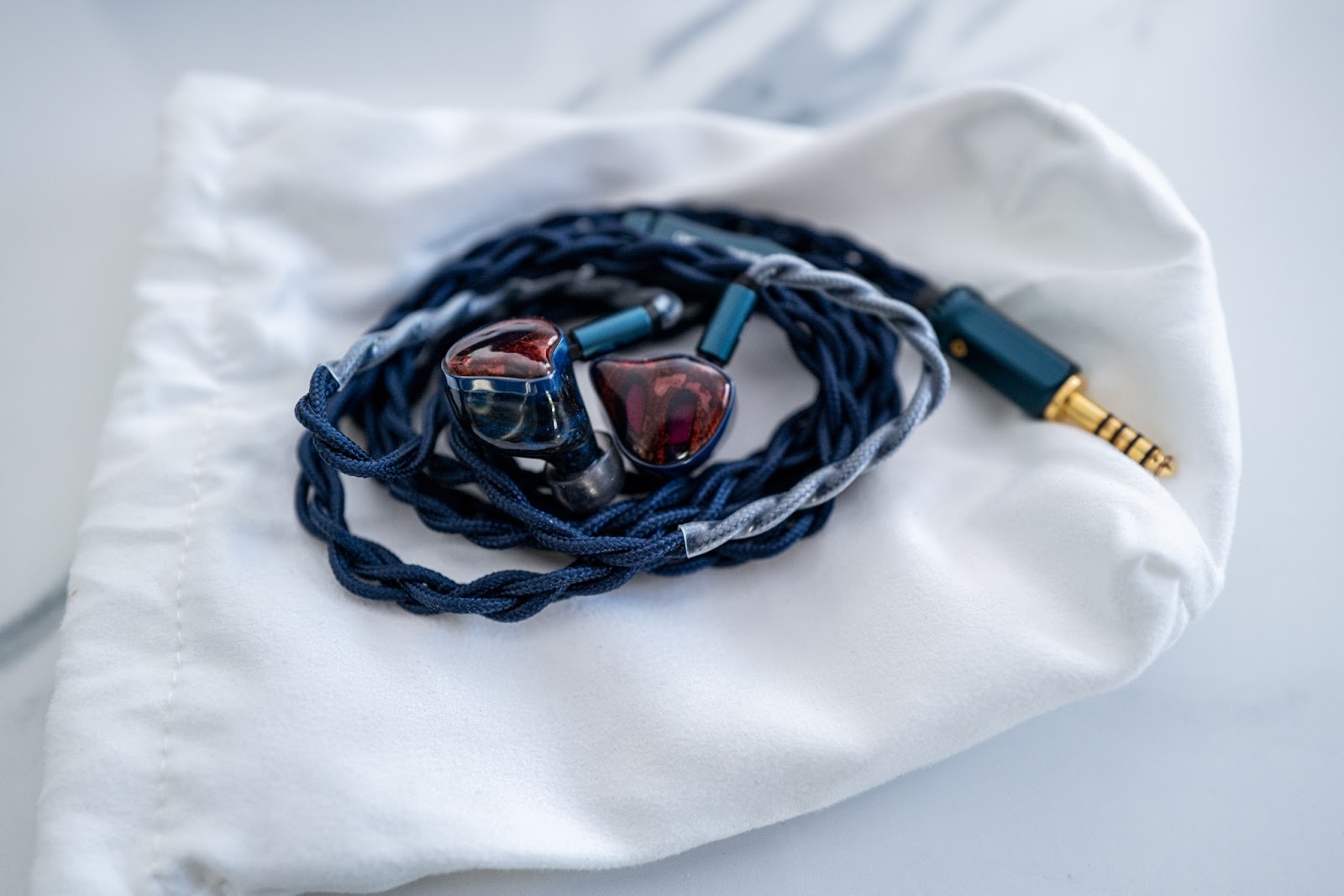
According to Unique Melody, the new Mentor features a brand new Frequency Shift Piezoelectric bone conduction driver that was specifically developed for the entire hearing frequency range of human ears. To ensure the driver’s performance, a conductive palladium slurry with high temperature resistance is applied to the vibrators, and a pure copper substrate is added on top of a double-sided ceramic layer. The performance of the driver is also optimized by adjusting the internal structure of the cavity, which also reduces the vibrations sense and increases the comfort.
The Mentor has a 5-way crossover design which features 4 bass, 2 mids, 2 mid-treble, and 4 treble balanced armature drivers along with the bone conduction driver. The Mentor comes with a lovely PW Audio cable with 26AWG copper and silver-plated copper wires. The cable is covered in a soft nylon material, and independent shielding that PW Audio dubs “Deep of Universe''.
I’ve now had a chance to spend several weeks with the Multiverse Mentor and have used it predominantly with the HiBy RS8 DAP, the EarMen Sparrow dongle DAC, as well as with the dCS Lina DAC (set at 2V output), and AMP (set to low gain).
Unboxing and First Impressions
The Mentor ships in a relatively small shrink-wrapped silver outer box. Opening the outer box reveals a silk-screened inner box which opens with a latch system and also contains a shelf of included accessories. The Mentor itself sits inside of the vegan leather case, which itself is wrapped in a white cloth drawstring bag. While the packaging is not what I would consider “luxurious”, it is very professional and imparts an understated feeling of quality.



The accessories include a set of Azla Xelastec ear tips, cleaning materials, and replaceable metal mesh filters. The case, while rather large, is of a high quality and appears to be made by a particularly well-known and popular manufacturer from the Republic of Korea.
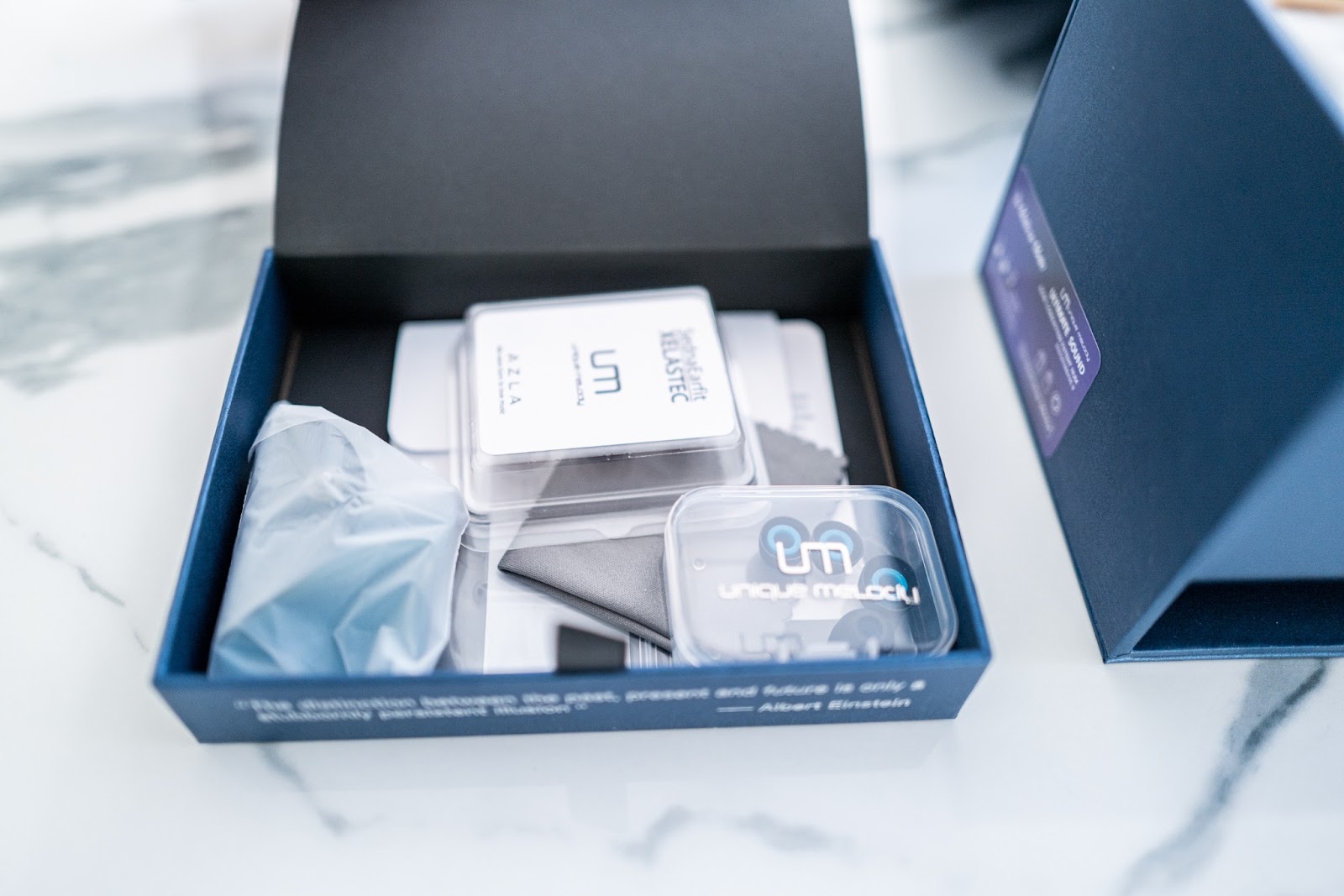


Looking at the earpieces themselves, the Multiverse Mentor is made from a Carbon Fiber blue shell, with a Ceramic Frame holding the Bone Conduction Driver, and is finished with a Banksia Seed Faceplate. The Banksia wood in person gives the Mentor a darker brown appearance with splashes of purple that are accentuated when hit with direct light.
The custom-designed cable from PW Audio is a deep blue color that matches the blue ceramic frame of the Mentor almost perfectly. It’s a a 4 wire, 26AWG silver-plated copper cable called “Deep of universe” that is terminated in a 4.4mm balanced pentacon plug. Overall, the cable seems to be of very high quality and while it’s quite large and thick, the ergonomics are very good, with the cable folding/wrapping, and unwrapping nicely.
I found that the relatively small size of the earpieces made for a comfortable and ergonomic fit. Additionally, with a vent in each earpiece shell, there was no perceptible pressure build in my ears, so extended listening sessions were overall very comfortable.

Setup
I used the Mentor in three different configurations as follows:
The Multiverse Mentor competes at the highest level of flagship IEM territory and is positioned to take on the likes of the Aroma Jewel, Oriolus Trailli, and other top tier offerings.
Sound Impressions
I’ve been listening to the Mentor almost exclusively for the past several weeks and continue to be deeply impressed. These are among the finest IEM’s I’ve ever experienced and blend a combination of technical mastery and are tuned almost perfectly to my personal listening preferences. Foremost is a great sense of tonal balance across the frequencies along with truly magical midrange. In particular, vocals sound rich and lifelike and have a certain intangible quality that makes them come across as incredibly natural.
While some may lament that BA bass cannot overcome certain shortcomings, I felt that the Mentor’s bass, enhanced by the Bone Conduction Driver, certainly provides a great bass experience with impact and slam when called upon. And while it’s not quite equivalent to dynamic driver bass, I never really thought anything was lacking. Of course, there are also those who prefer BA bass in that it also can be less fatiguing to listen to. As with most things in the hobby, YMMV.
The Multiverse Mentor’s treble is also extremely well tuned. It’s highly resolving and is able to extract the micro details, with the sparkle and shimmer when called upon, but it’s tasteful and never overdone. I’m fairly sensitive to treble sibilance and listening fatigue in general, yet I never felt this while listening to the MM.
The MM is an absolute technical monster. It’s resolution, soundstaging, layering, and overall speed are “best in class” impressive, and are really pushing the boundaries of what’s possible in an IEM today.
Conclusion
Unique Melody has really hit it out of the park with the Multiverse Mentor. While it’s impossible to “crown” a single IEM as being best in its category, I can unequivocally say that it's perhaps the most well balanced IEM I’ve personally experienced, and fits my personal listening preferences to a tee. As an all-arounder with flagship level technicalities, the Multiverse Mentor has a magical midrage, a highly detailed yet non-fatiguing treble, and among the best BA bass I’ve ever heard, aided by the Bone Conduction Driver. Tying it all together is a laser-focused set of technicalities which I’ve rarely experienced in an IEM. The Unique Melody Multiverse Mentor has my highest recommendation and is a must-audition for anyone in the market for a flagship IEM.
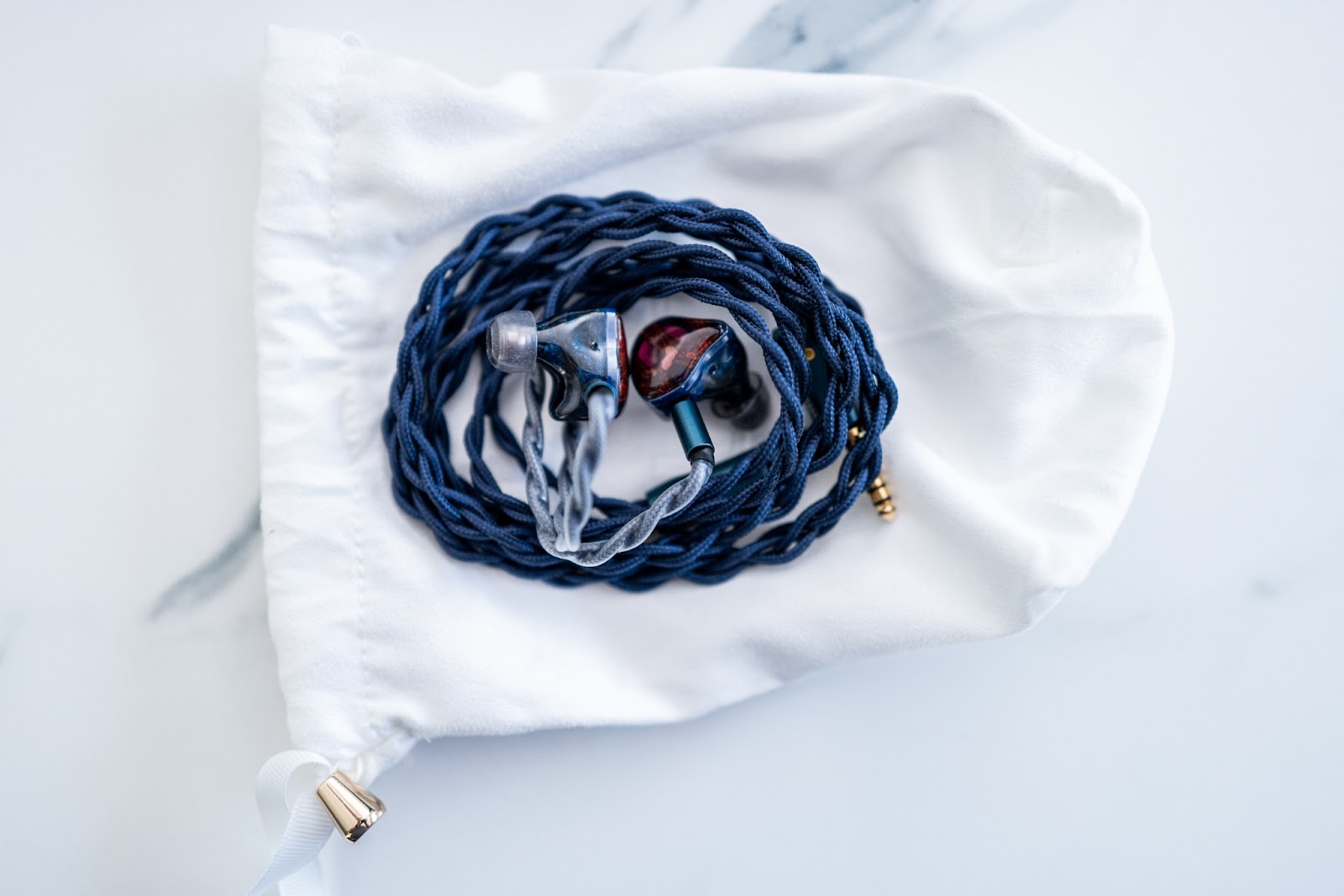
IEM driver technology continues to be one of the most exciting and innovative spaces in the headphone audio market. Over the past few years we’ve seen countless designs utilizing dynamic drivers, balanced armature drivers, piezoelectric drivers, bone conducting drivers, and hybrid designs containing various combinations of the above.
Bone conduction technology is different from the other driver technologies that move air, in that it passes vibrations through the bones in the jaw and skull, directly into the inner ear. In a sense, this means that the sound bypasses the ear structure and the sound is heard from inside the ear, instead of outside.
Guangdong-based Unique Melody are now one of the most well-known manufacturers of IEMs and like many current IEM manufacturers, can trace their roots back to the hearing aid business. They were also one of the first to introduce bone conduction drivers into their products. The Unique Melody MEST and its successor, the MEST MKII were very well received by the Head-Fi community. More recently, Unique Melody continued with various bone conduction designs and had three limited edition flagship products in the Mason Fabled Sound and FS Le Jardin, and the Red Halo, that all used a hybrid design of 12 balanced armature drivers and a full-range bone conduction driver.
The Multiverse Mentor is Unique Melody’s newest flagship product in the Mentor Series and retails for $4,499 for the universal model, and $4,999 for the custom model. During CanJam SoCal 2022, I was fortunate enough to stop by the MusicTeck booth on the Sunday afternoon before the show closed in order to hear the Multiverse Mentor, paired with the fantastic HiBy RS8 digital audio player. It’s always an eye-opening experience when experiencing truly cutting-edge products that are pushing boundaries for the first time, and the MM (and RS8) certainly fell into this category.
According to Unique Melody, the new Mentor features a brand new Frequency Shift Piezoelectric bone conduction driver that was specifically developed for the entire hearing frequency range of human ears. To ensure the driver’s performance, a conductive palladium slurry with high temperature resistance is applied to the vibrators, and a pure copper substrate is added on top of a double-sided ceramic layer. The performance of the driver is also optimized by adjusting the internal structure of the cavity, which also reduces the vibrations sense and increases the comfort.
The Mentor has a 5-way crossover design which features 4 bass, 2 mids, 2 mid-treble, and 4 treble balanced armature drivers along with the bone conduction driver. The Mentor comes with a lovely PW Audio cable with 26AWG copper and silver-plated copper wires. The cable is covered in a soft nylon material, and independent shielding that PW Audio dubs “Deep of Universe''.
I’ve now had a chance to spend several weeks with the Multiverse Mentor and have used it predominantly with the HiBy RS8 DAP, the EarMen Sparrow dongle DAC, as well as with the dCS Lina DAC (set at 2V output), and AMP (set to low gain).
Unboxing and First Impressions
The Mentor ships in a relatively small shrink-wrapped silver outer box. Opening the outer box reveals a silk-screened inner box which opens with a latch system and also contains a shelf of included accessories. The Mentor itself sits inside of the vegan leather case, which itself is wrapped in a white cloth drawstring bag. While the packaging is not what I would consider “luxurious”, it is very professional and imparts an understated feeling of quality.
The accessories include a set of Azla Xelastec ear tips, cleaning materials, and replaceable metal mesh filters. The case, while rather large, is of a high quality and appears to be made by a particularly well-known and popular manufacturer from the Republic of Korea.
Looking at the earpieces themselves, the Multiverse Mentor is made from a Carbon Fiber blue shell, with a Ceramic Frame holding the Bone Conduction Driver, and is finished with a Banksia Seed Faceplate. The Banksia wood in person gives the Mentor a darker brown appearance with splashes of purple that are accentuated when hit with direct light.
The custom-designed cable from PW Audio is a deep blue color that matches the blue ceramic frame of the Mentor almost perfectly. It’s a a 4 wire, 26AWG silver-plated copper cable called “Deep of universe” that is terminated in a 4.4mm balanced pentacon plug. Overall, the cable seems to be of very high quality and while it’s quite large and thick, the ergonomics are very good, with the cable folding/wrapping, and unwrapping nicely.
I found that the relatively small size of the earpieces made for a comfortable and ergonomic fit. Additionally, with a vent in each earpiece shell, there was no perceptible pressure build in my ears, so extended listening sessions were overall very comfortable.
Setup
I used the Mentor in three different configurations as follows:
- HiBy RS8 R2R DAP, medium gain, Turbo enabled
- dCS Lina DAC and AMP, 2V setting, low gain enabled
- EarMen Sparrow dongle DAC
The Multiverse Mentor competes at the highest level of flagship IEM territory and is positioned to take on the likes of the Aroma Jewel, Oriolus Trailli, and other top tier offerings.
Sound Impressions
I’ve been listening to the Mentor almost exclusively for the past several weeks and continue to be deeply impressed. These are among the finest IEM’s I’ve ever experienced and blend a combination of technical mastery and are tuned almost perfectly to my personal listening preferences. Foremost is a great sense of tonal balance across the frequencies along with truly magical midrange. In particular, vocals sound rich and lifelike and have a certain intangible quality that makes them come across as incredibly natural.
While some may lament that BA bass cannot overcome certain shortcomings, I felt that the Mentor’s bass, enhanced by the Bone Conduction Driver, certainly provides a great bass experience with impact and slam when called upon. And while it’s not quite equivalent to dynamic driver bass, I never really thought anything was lacking. Of course, there are also those who prefer BA bass in that it also can be less fatiguing to listen to. As with most things in the hobby, YMMV.
The Multiverse Mentor’s treble is also extremely well tuned. It’s highly resolving and is able to extract the micro details, with the sparkle and shimmer when called upon, but it’s tasteful and never overdone. I’m fairly sensitive to treble sibilance and listening fatigue in general, yet I never felt this while listening to the MM.
The MM is an absolute technical monster. It’s resolution, soundstaging, layering, and overall speed are “best in class” impressive, and are really pushing the boundaries of what’s possible in an IEM today.
Conclusion
Unique Melody has really hit it out of the park with the Multiverse Mentor. While it’s impossible to “crown” a single IEM as being best in its category, I can unequivocally say that it's perhaps the most well balanced IEM I’ve personally experienced, and fits my personal listening preferences to a tee. As an all-arounder with flagship level technicalities, the Multiverse Mentor has a magical midrage, a highly detailed yet non-fatiguing treble, and among the best BA bass I’ve ever heard, aided by the Bone Conduction Driver. Tying it all together is a laser-focused set of technicalities which I’ve rarely experienced in an IEM. The Unique Melody Multiverse Mentor has my highest recommendation and is a must-audition for anyone in the market for a flagship IEM.
Last edited:
CT007
I wonder what the cost of the drivers and materials is - maybe $500 at most?
musicfreakboy
Totally agreeing with all the points in the review. The technicalities are out of this world. Usually technicalities mean fatiguing listening to me. But the MM manages to be one of the most technically resolving iem yet remaining easy to listen to. It’s really a “just-one-more-track” kind of iem for me. Homerun for sure!
Pros: - Beautiful sounding R2R DAC with Darwin II architecture
- Titanium construction
- 5.5" 1080p retina display with 443 PPI
- Open Android 12
- Fast UI
- Luxury presentation and accessories
- Titanium construction
- 5.5" 1080p retina display with 443 PPI
- Open Android 12
- Fast UI
- Luxury presentation and accessories
Cons: - Heavy
Introduction
The flagship DAP market has gotten really interesting over the last few years. Once a near exclusive purview of Astell&Kern, with a smattering of Sony on top, the market has since expanded to include the likes of Cayin, Luxury & Precision, and now HiBy, among others.
Most flagship DAPs are traditional chip/based DACs which pursue varying degrees of reference type sound signatures. In an effort to appeal to enthusiasts looking for a wider variety of personal listening preferences, Cayin released their N8 series in 2018 which enabled the user to choose between tube and solid state amplification. The flagship market further expanded when Luxury & Precision released their first fully discrete R2R ladder DACs, the P6 and P6 Pro in late 2020.
Guangdong-based HiBY Music was established in 2011, primarily as a digital music provider, and in recent years has developed its own line of DAP hardware products. Initially targeting budget-minded consumers, the company rapidly shifted to focus on the midrange and upper end of the market with the 2020-released R8 and 2021-released RS6. The RS6 was also HiBy’s first R2R DAP.
R2R (resistor-to-resistor) DACs use a series of resistors to convert digital signals into analog signals. R2R DACs have been traditionally used in desktop applications, yet they are now becoming more popular in the DAP market. R2R designs typically bring a more natural, non-fatiguing, and organic presentation to the table. Which is especially important for those that are sensitive to sibilance or harshness in the frequency response.
The R8 and RS6 were both highly regarded and excellent products in their own right, and were the stepping stones for HiBy to finally bring a true flagship audio player to market. With the introduction of the all-new RS8, HiBy has clearly set out to compete at the top end of the market with a no compromise design, and is packed to the gills with features. Those who attended CanJam SoCal 2022 had a chance to demo the new RS8 and for many, it was the best sounding DAP at the show.
The RS8 has a flagship DAP price and retails for $3,299 and is the most expensive HiBy DAP to date.
Some notable features of the HiBy RS8 include:
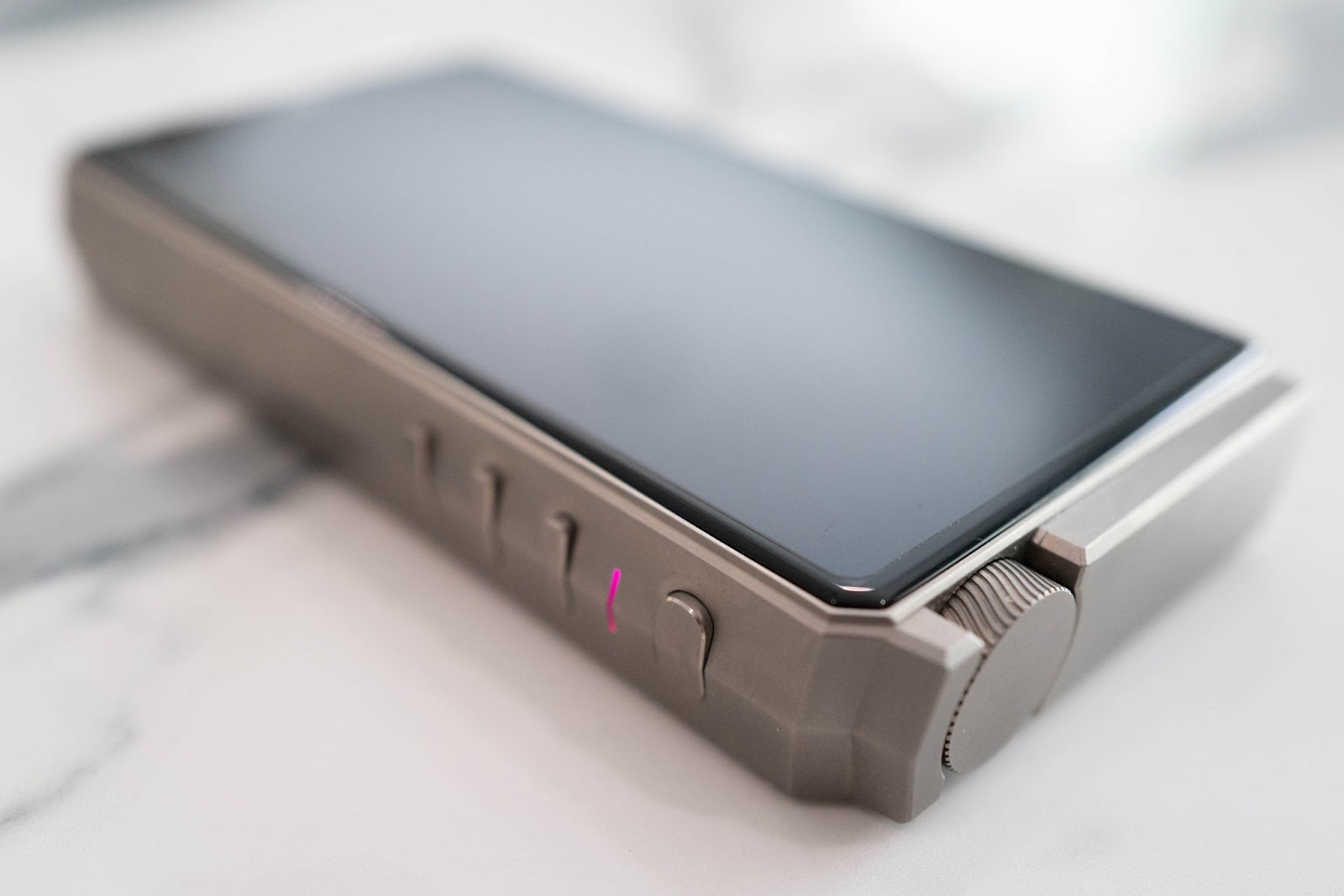
Unboxing and First Impressions
The RS8 is a premium, flagship DAP and the unboxing experience is among the most luxurious I’ve seen across any product in the high end personal audio space. Opening the shiny and reflective silver box, we’re greeted with a catchy “HIBY RS8” silver inscribed piece of translucent wax paper that is sat on top of a cloth drawstring bag which protects the leather storage case.
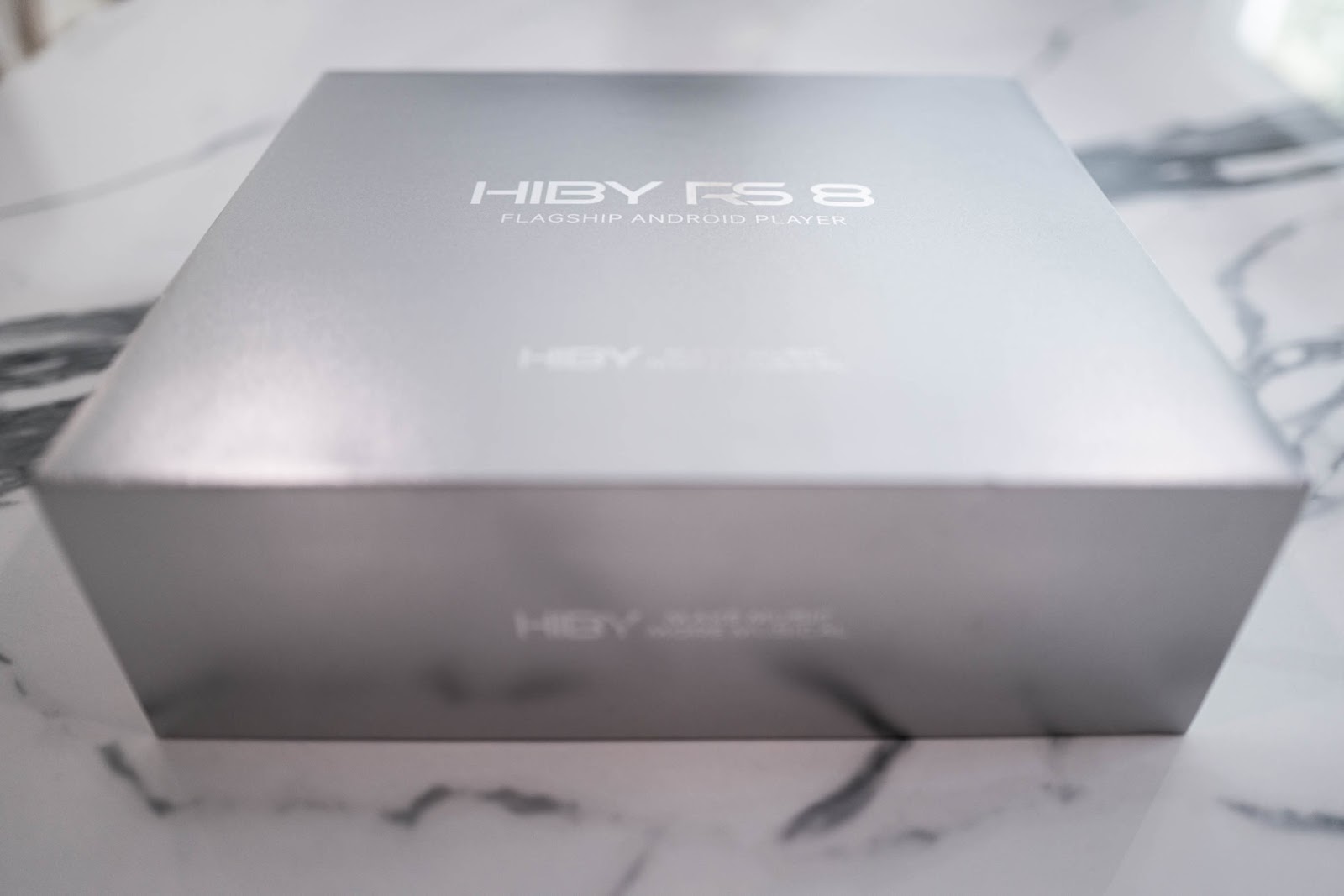


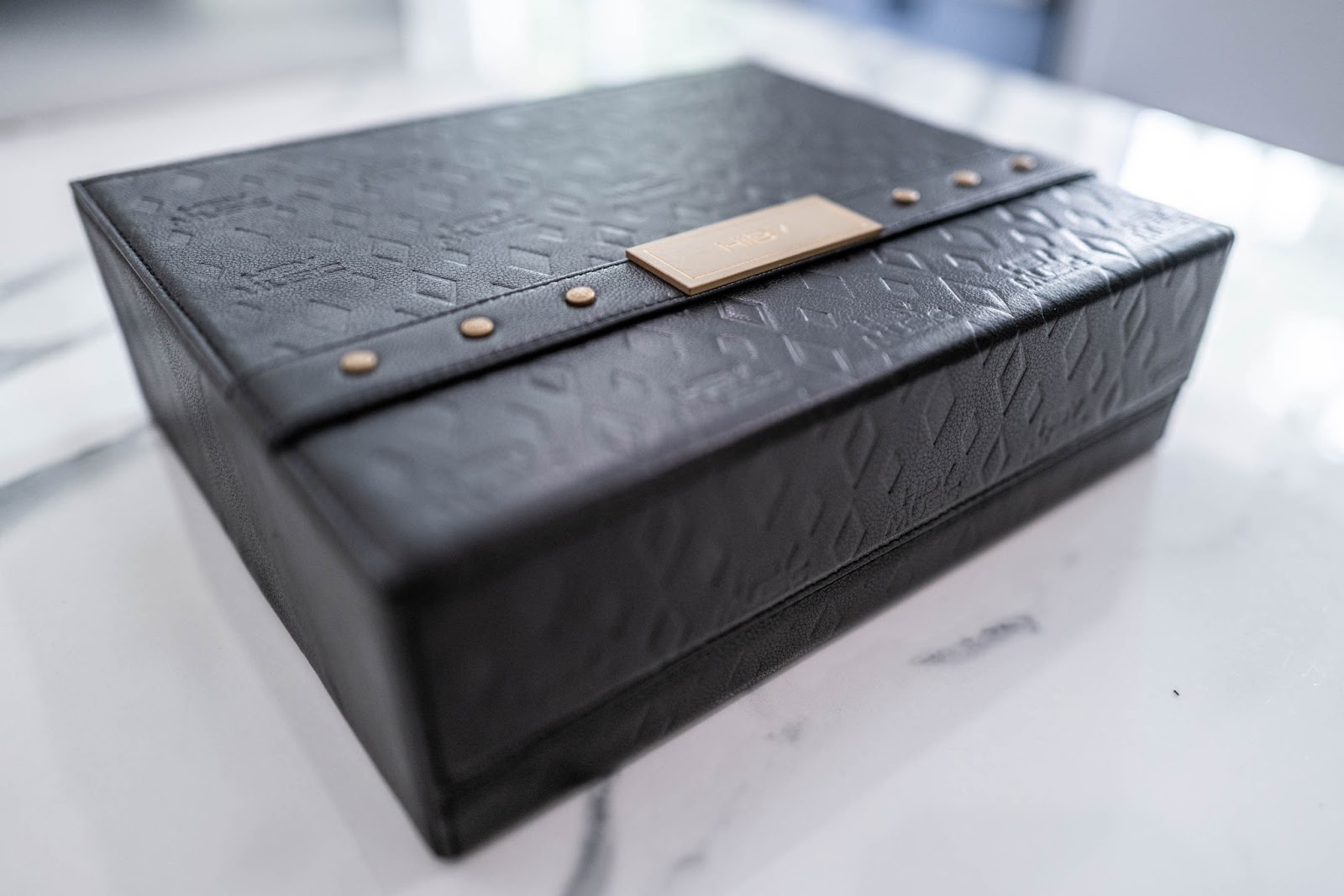
The case is beautifully adorned with HIBY branded decoration and feels ultra-premium in hand. Opening the magnetic latch case reveals the top shelf holding the RS8 unit itself, along with a lovely owner’s card, a branded piece of solid Titanium.
Removing the upper shelf reveals three boxes of Accessories which include a custom designed leather case, a USB-C charging cable, and a USB-C to digital coaxial cable. There is also an included envelope containing a quick start guide, warranty card, extra screen protector (one comes pre-installed on the unit), and a thank-you note from HiBy.

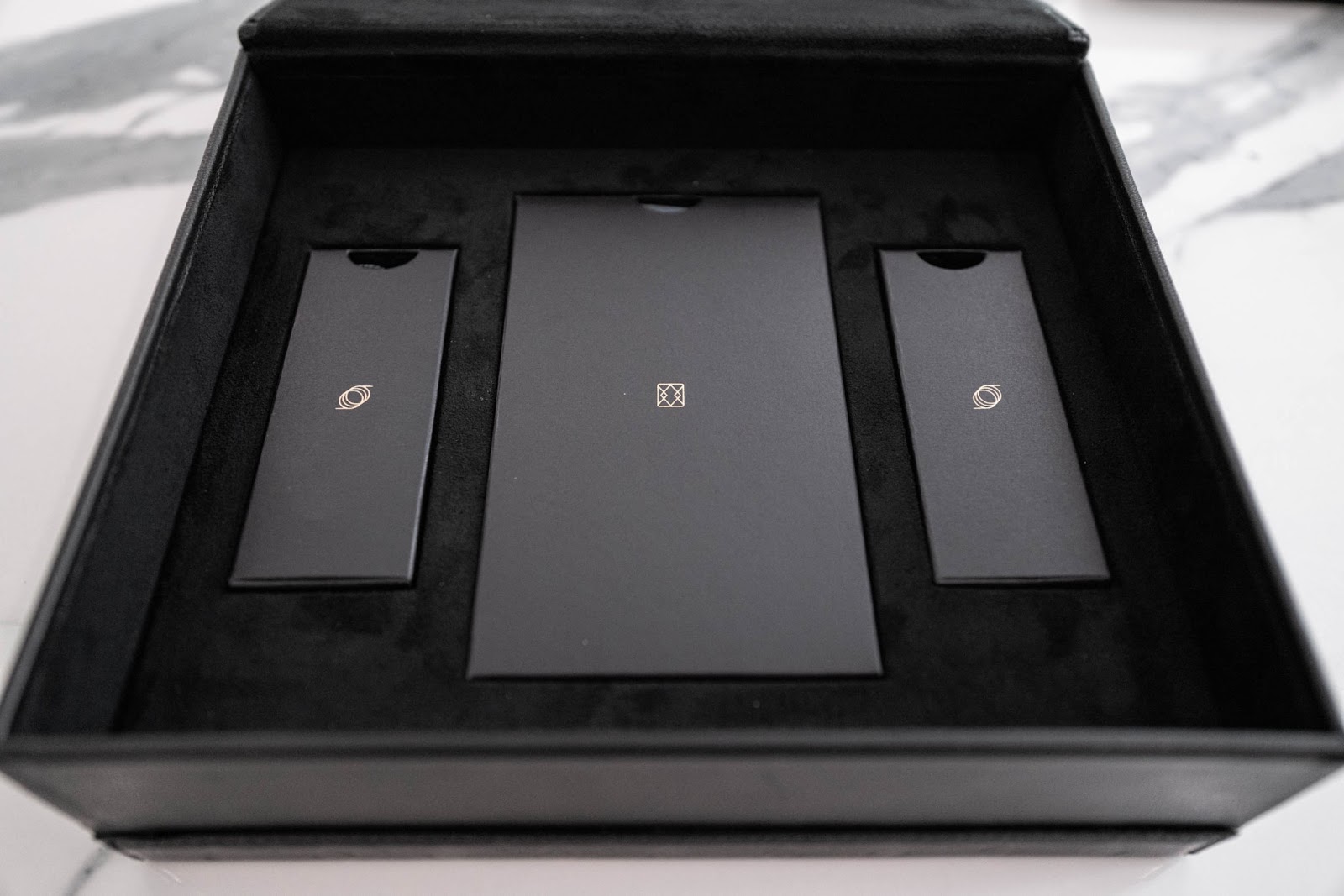
The leather case itself is a beautiful shade of blue with greenish tones and is precisely cut for a perfect and tight fit with the RS8. The back of the case contains a fairly large cut-out which enables the user to see the decorated back panel of the unit. I also noticed through usage, that the cutout made holding the RS8 easier, so this design choice has more than an aesthetic benefit.
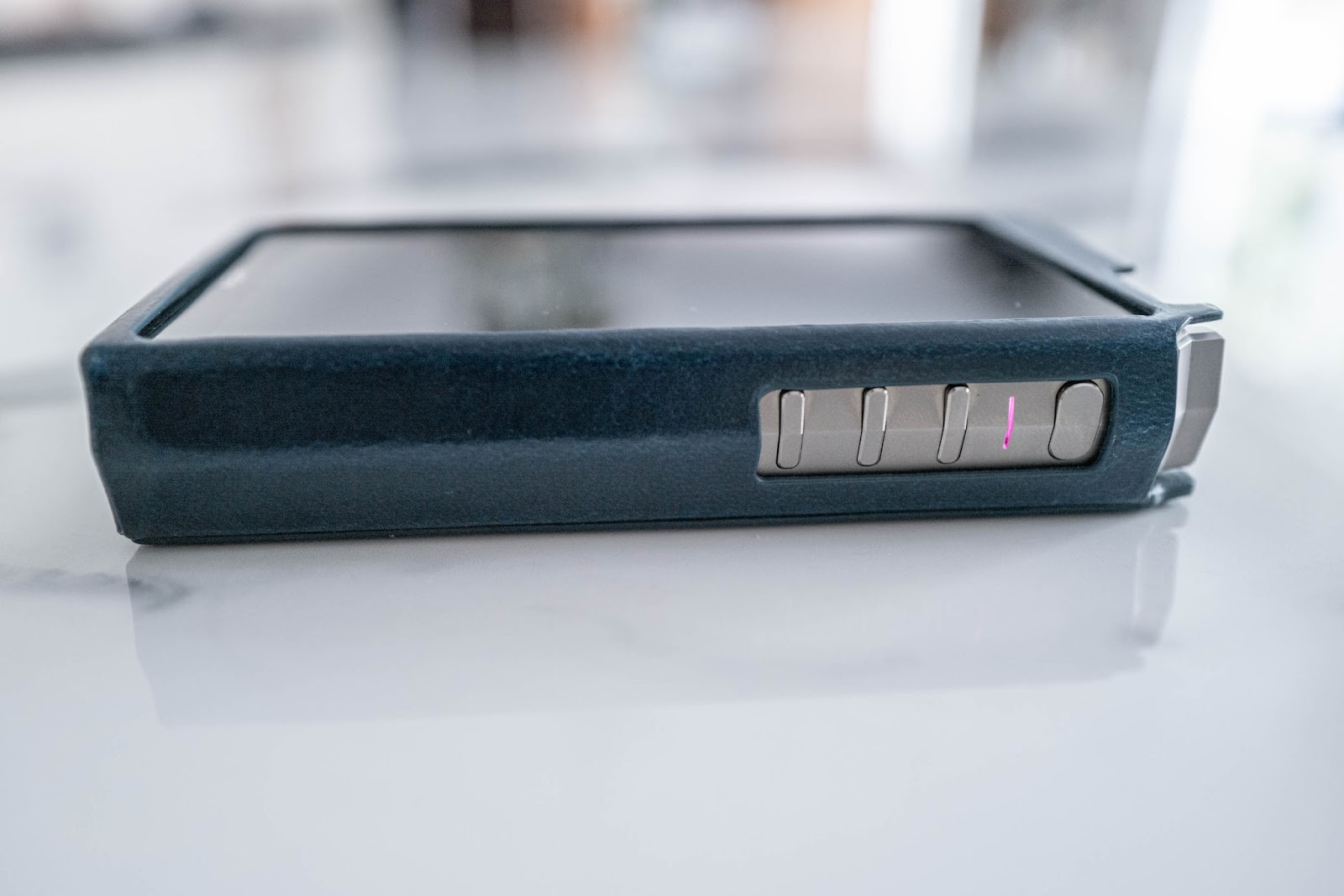

Picking up the actual unit itself, the RS8 is made from a solid block of titanium and has significant weight to it, coming in at just under 590 grams. The volume knob has perfectly machined notches and is without question, the nicest feeling volume control I’ve ever experienced on a portable device. It has just the right amount of resistance and is smooth as butter.
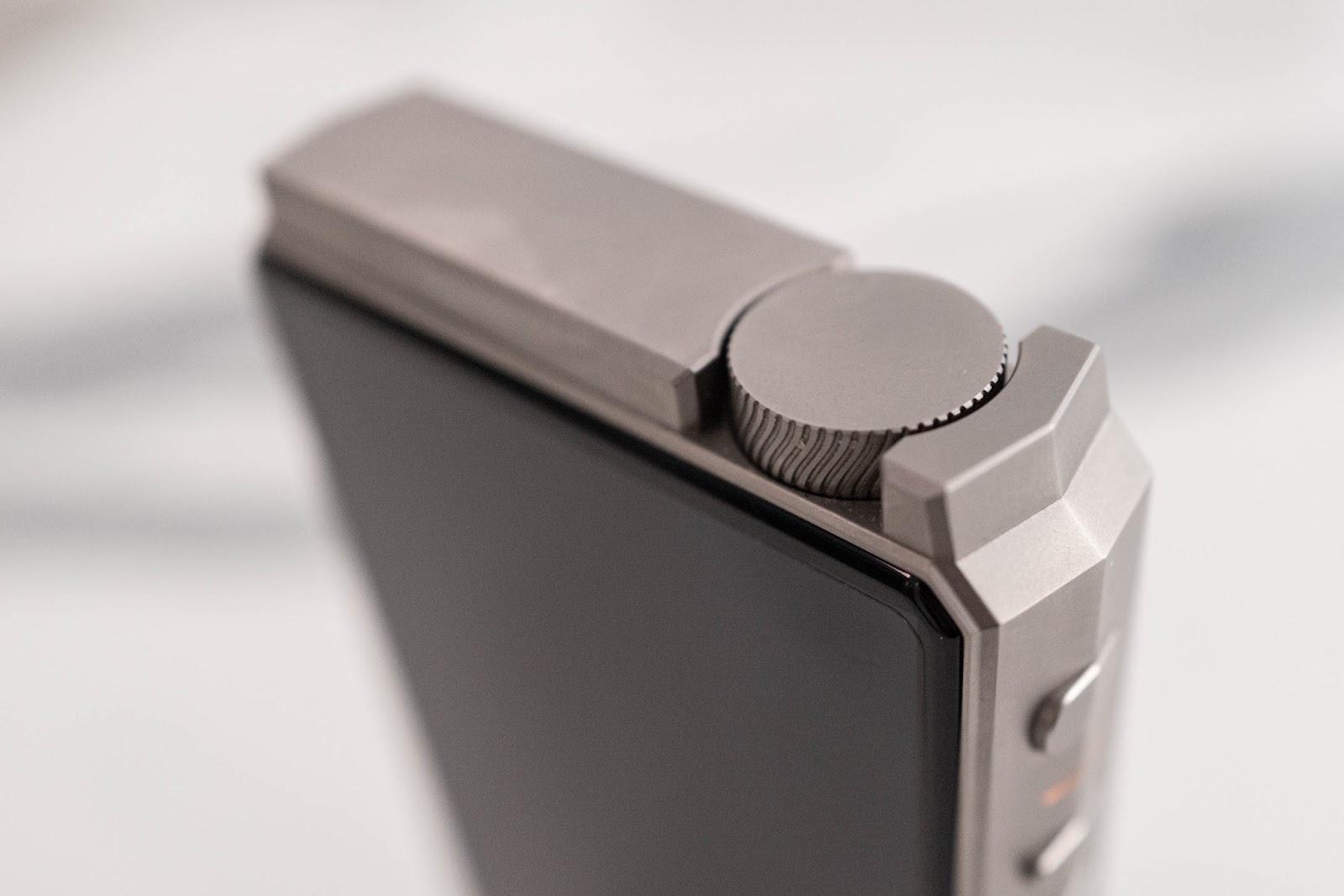
The sharp angles at the top of the unit highlight and accentuate the beauty of the titanium shell, which itself is velvety smooth to the touch. All of the ports on the RS8 are on the bottom of the unit and include 3.5mm and 4.4mm balanced and unbalanced outputs. There is also a USB-C port which charges the RS8 and also provides the coaxial connection using the supplied USB-C to coaxial cable.
The RS8 boasts a 5.5” 1080p IPS retina screen which has a 443 ppi density. The Android 12 interface is snappy and its open architecture allows for the adding of apps from the Google Play store. I added both the Tidal and YouTube apps and the overall interaction with the device feels similar to a modern Android smartphone. The RS8 comes with a screen protector pre-installed, and there is a second, spare screen protector included as well.
The right side of the RS8 has a power switch and three additional buttons, for playback/pause, forward, and backward with an LED indicator in between. The LED indicator will show different colors depending on the bitrate passing through. Flipping over, the left side features a MicroSD card slot which supports card sizes up to 2TB.
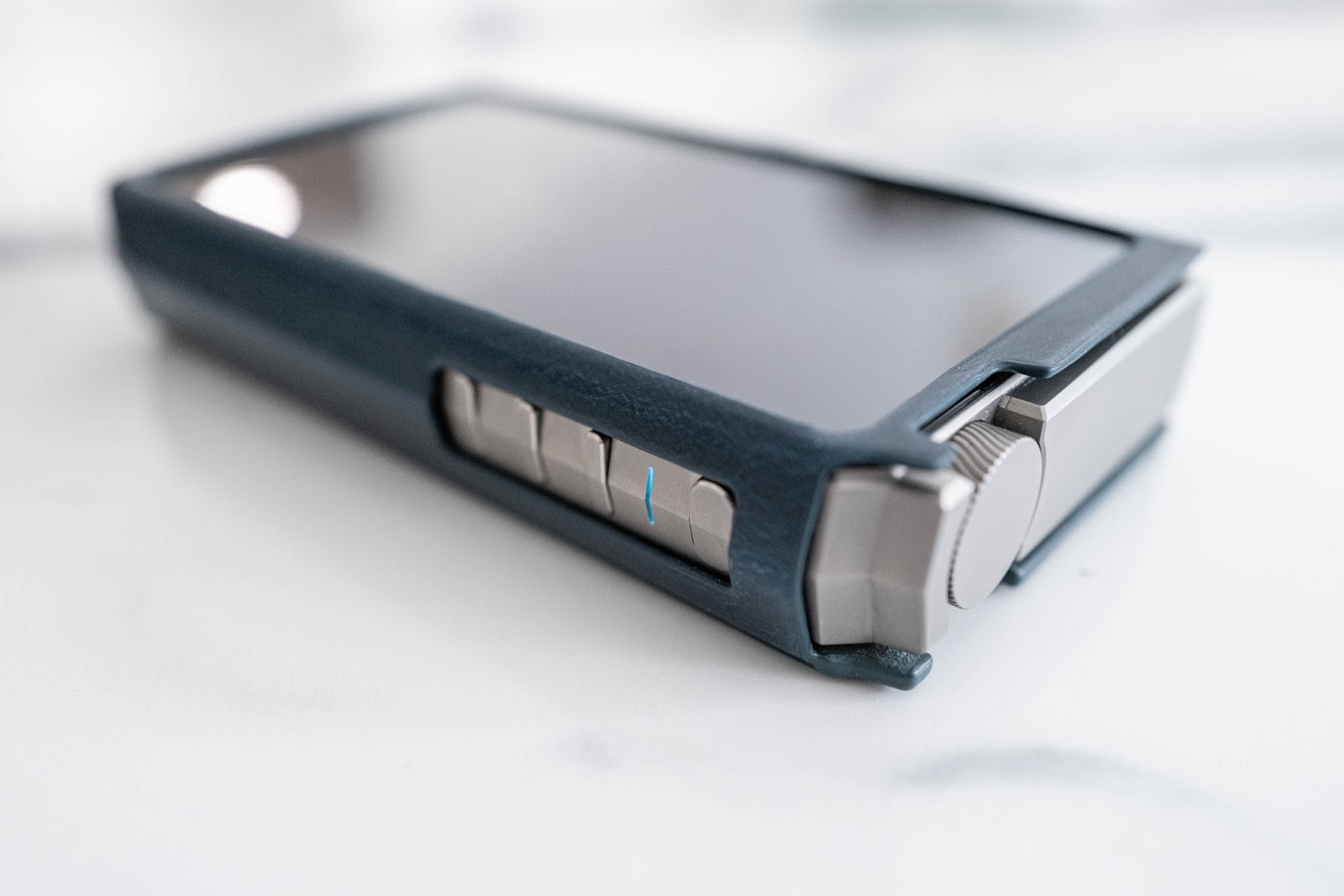
Setup and Operation
The RS8 uses an open Android 12 operating system, which provides the user with multiple options on how to listen to and stream music. I used the Google Play Store to download the Tidal app for music streaming and the UAPP player for listening to local files. There is also a fine default, and fully featured audio player called HiBy Music Pro.
I mostly used 2 different menus to tweak the sound to my liking, these were the Audio Settings Menu, and the Darwin Controller Menu. To access apps such as Tidal, UAPP, and YouTube, you can simply tap the app icon of the home screen, similar to a phone or tablet. To access Audio Settings and the Darwin Controller, all it takes is a simple swipe or double swipe down from the top of the unit. I liked the ease of access to these options without scrolling through menus as it made adjustments on the fly, quick and easy.
The Audio Settings Menu provides several options to tailor the sound. Throughout my listening impressions, I found myself adjusting settings depending on IEM used and on genre/recording quality of the music. There is an option to switch between Class A and Class AB modes, enabling Turbo mode, changing Gain levels, adjusting DSD Gain compensation, setting channel balance, and capping maximum volume. There is also an excellent built-in EQ in the MSEB settings menu, which enables subtle changes when needed.
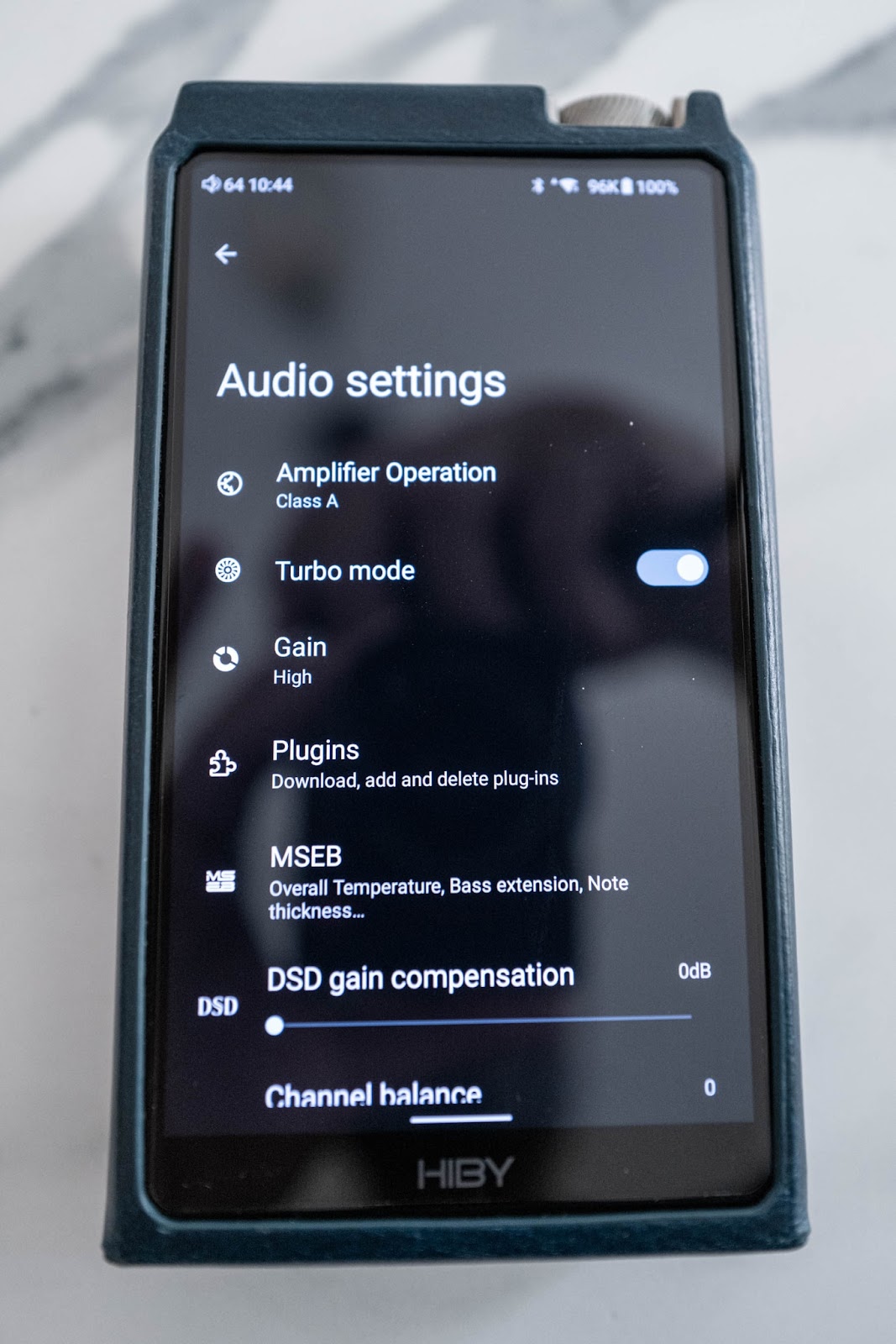
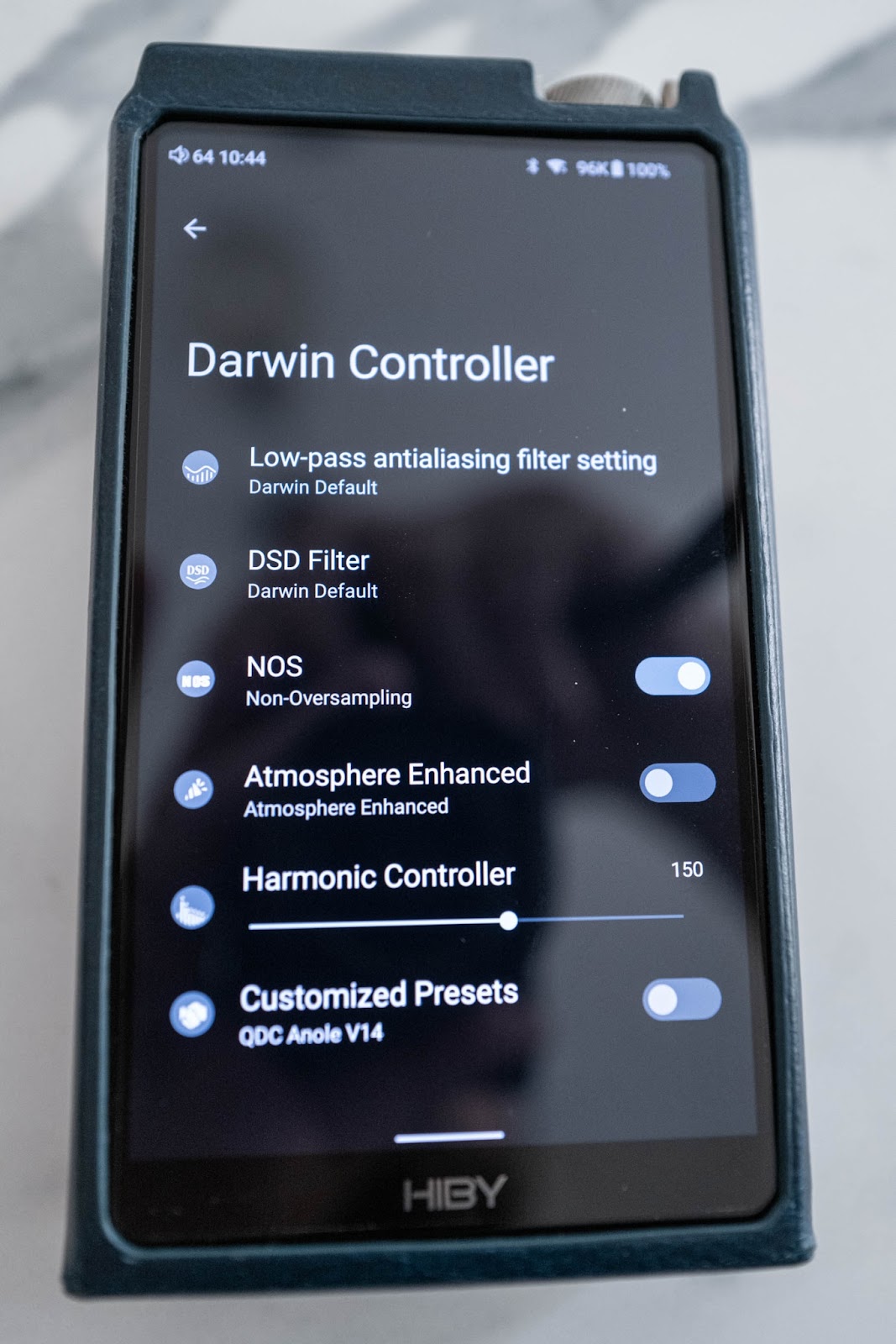
The Darwin Controller contains several options to customize various aspects of the digital signal. The main setting here is the toggle for non-oversampling (NOS) or if left off, oversampling. For the most part, I preferred the NOS setting as it sounded more natural and musical. The OS setting sounded perhaps a tad cleaner, but I felt it also gave up some of the “magic sauce” that I was hearing with the NOS setting engaged.
There are also filter presets for Low-pass antialiasing and DSD, an Atmosphere Enhanced toggle along with a Harmonic Controller, and Customized presets that contain a few popular IEMs, with more to come in future updates. Tweaking these settings resulted in some minor effects and it's great to have so many options on board.

Sound Impressions
For my listening impressions with the RS8, I used a Unique Melody Mentor Multiverse and a Vision Ears Elysium. The Elysium really comes to life with higher output power and the RS8 outputs up to 780mW when using the balanced output, and 280mW single ended, both into 32Ω. The RS8 was burned in for about 150 hours before doing any critical listening.
“I keep wanting to turn the volume up. Not because I can’t hear what’s going on, but because it sounds so damn good.” This just about sums it up for me. The RS8 is probably the most enjoyable DAP I’ve ever heard and reminded me of desktop listening sessions using tube amplification. There’s an inherent organic quality to the sound which is natural and realistic. In terms of overall tuning, I would describe the RS8 as warmer than neutral but still close to a reference tuning.
The RS8 has an incredibly black background and it is completely silent. Sounds have a wonderful textural quality to them that is simply engaging and left me wanting to keep listening. Detail retrieval is still excellent even with edges that are a little smooth and rounded. There was simply no sibilance or listening fatigue.
The Turbo mode provides a little more voltage swing and results in a more direct and engaging sound. I generally preferred the Turbo mode when wanting more overall energy in my listening. This was again, another feature that I found myself using a lot.
The Mentor is a new flagship IEM which has 12 BA drivers and a new frequency shift piezoelectric bone conduction driver. This IEM has a reference, warm neutral sound signature and pairs beautifully with the RS8. Listening mostly on low or medium gain settings, this combo shines with most everything I threw at it, even bass-heavy tracks where I had to EQ some of the bass frequency down just ever so slightly.
The Elysium has magic in its midrange and this was accentuated with the RS8. Here I could switch to a high gain setting and this combination was the best I’ve ever heard the Elysium sound. Music had a beautiful tone, with a little more relaxed yet still detailed treble.
On both IEMs, the soundstage was not only wide but also had depth and had more dimensionality than I’m used to hearing from portable audio devices. Here again, this reminded me of higher end desktop listening.
Overall, I’m really impressed with the sound quality of the RS8 and it is without a doubt, one of the best portable audio devices I’ve ever heard.
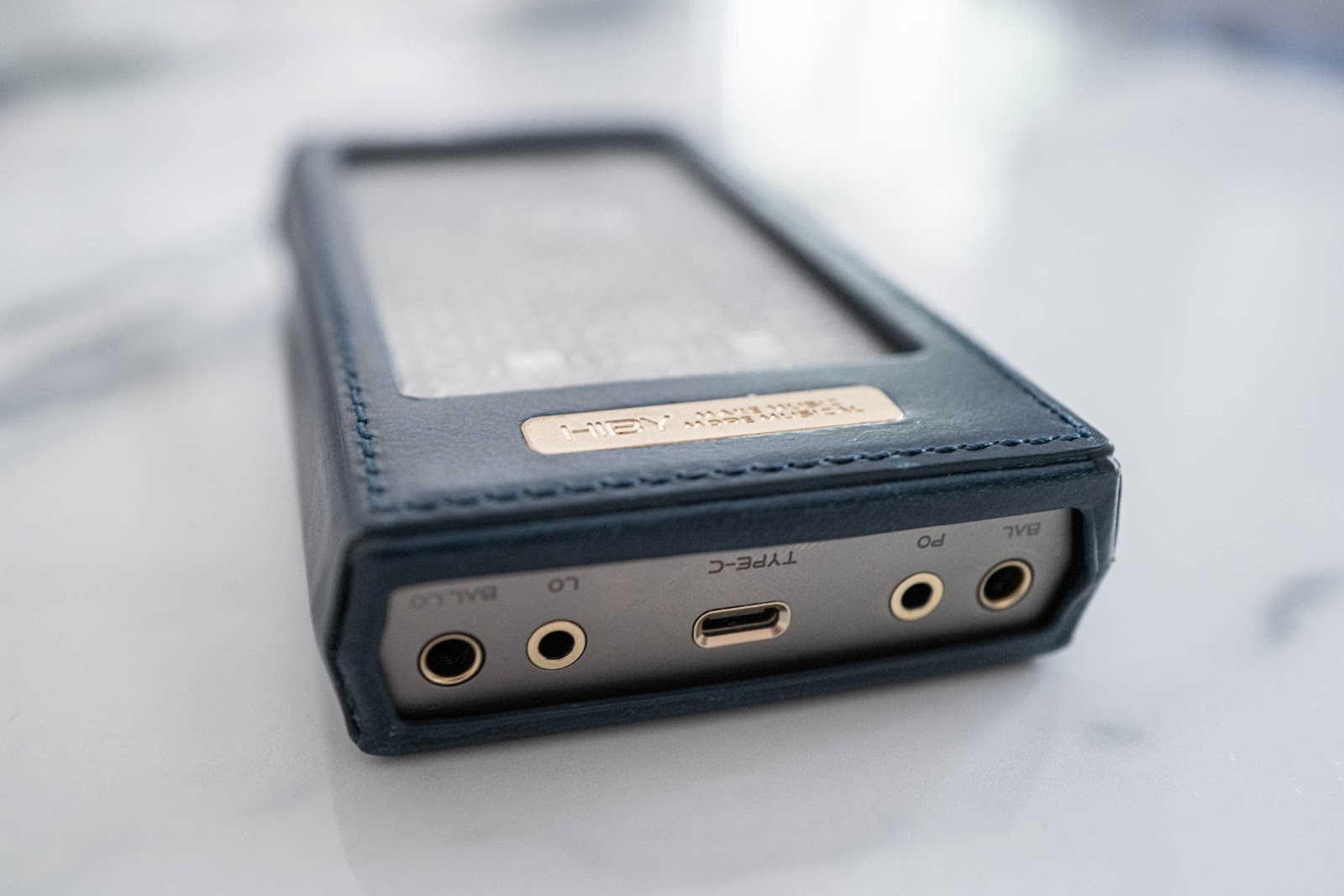
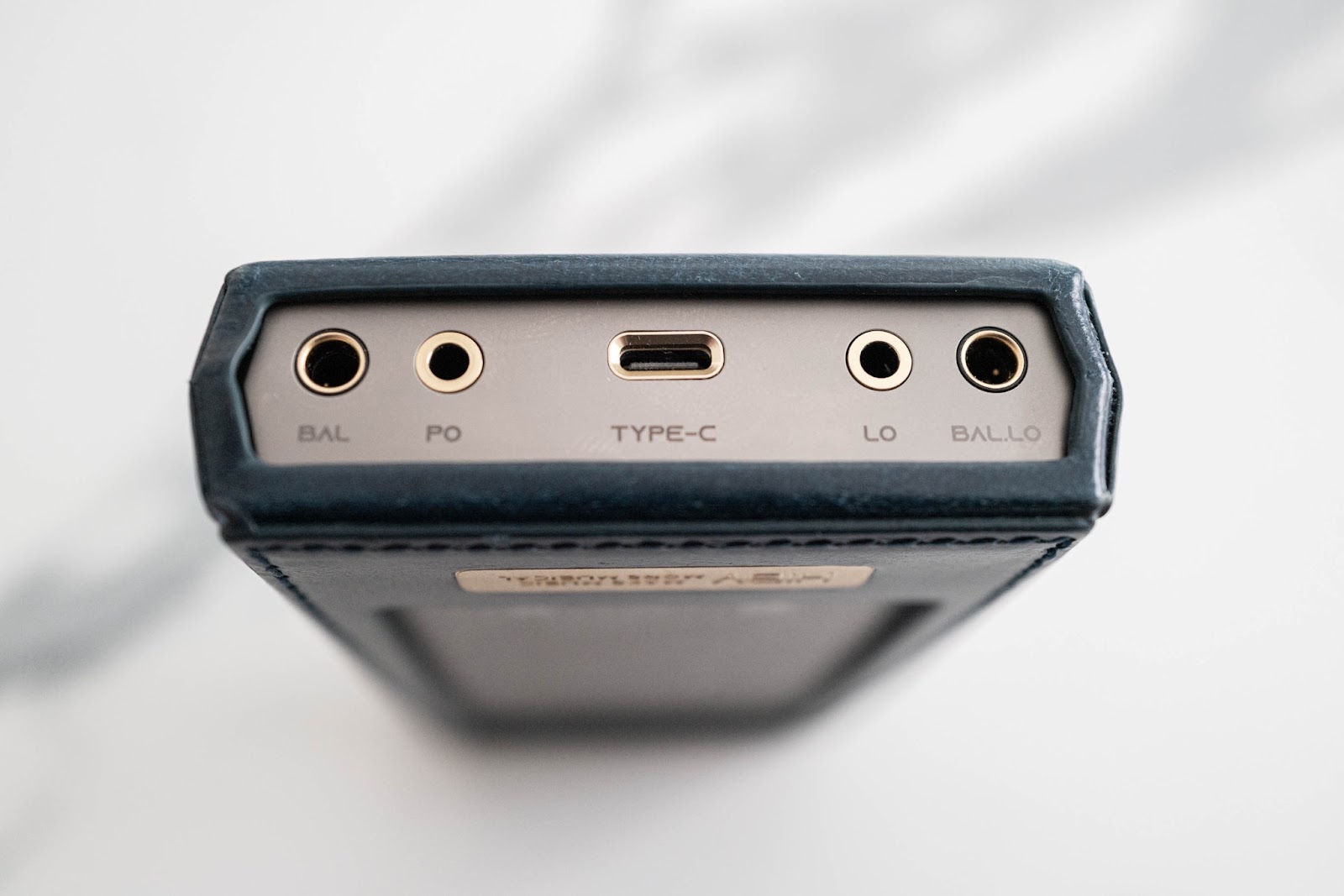
Conclusion
With the RS8, HiBy now has a strong contender in the flagship DAP category. In addition to its highly impressive physical and technical features, the RS8 has a beautiful and natural, organic quality to its sound signature. While naturally appealing to traditional R2R DAC fans, I believe the RS8 will likely appeal to any enthusiast looking for a flagship portable DAP. There is just an inherent quality to listening to music through this device which reminds me of listening to music with a high quality tube amplifier. Never harsh, detailed yet musical, and incredibly enjoyable. When you add in the beautiful Titanium construction, open Android 12, and a great screen and UI, this makes the overall package even more compelling.
I highly recommend auditioning the RS8 for anyone in the market for a flagship level DAP in 2023.
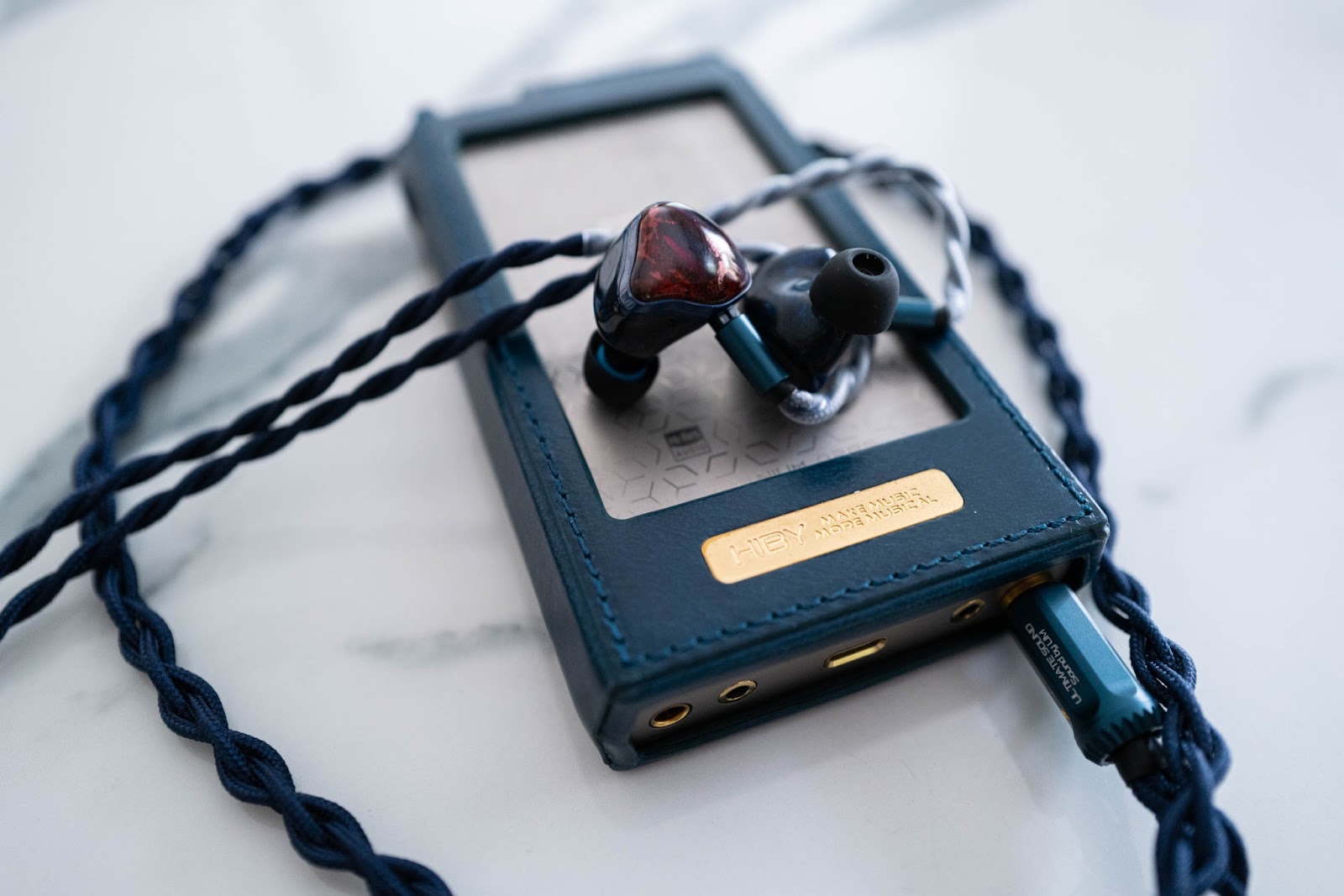
The flagship DAP market has gotten really interesting over the last few years. Once a near exclusive purview of Astell&Kern, with a smattering of Sony on top, the market has since expanded to include the likes of Cayin, Luxury & Precision, and now HiBy, among others.
Most flagship DAPs are traditional chip/based DACs which pursue varying degrees of reference type sound signatures. In an effort to appeal to enthusiasts looking for a wider variety of personal listening preferences, Cayin released their N8 series in 2018 which enabled the user to choose between tube and solid state amplification. The flagship market further expanded when Luxury & Precision released their first fully discrete R2R ladder DACs, the P6 and P6 Pro in late 2020.
Guangdong-based HiBY Music was established in 2011, primarily as a digital music provider, and in recent years has developed its own line of DAP hardware products. Initially targeting budget-minded consumers, the company rapidly shifted to focus on the midrange and upper end of the market with the 2020-released R8 and 2021-released RS6. The RS6 was also HiBy’s first R2R DAP.
R2R (resistor-to-resistor) DACs use a series of resistors to convert digital signals into analog signals. R2R DACs have been traditionally used in desktop applications, yet they are now becoming more popular in the DAP market. R2R designs typically bring a more natural, non-fatiguing, and organic presentation to the table. Which is especially important for those that are sensitive to sibilance or harshness in the frequency response.
The R8 and RS6 were both highly regarded and excellent products in their own right, and were the stepping stones for HiBy to finally bring a true flagship audio player to market. With the introduction of the all-new RS8, HiBy has clearly set out to compete at the top end of the market with a no compromise design, and is packed to the gills with features. Those who attended CanJam SoCal 2022 had a chance to demo the new RS8 and for many, it was the best sounding DAP at the show.
The RS8 has a flagship DAP price and retails for $3,299 and is the most expensive HiBy DAP to date.
Some notable features of the HiBy RS8 include:
- Snapdragon 665 processor
- HiBY’s in-house developed Darwin II architecture
- NOS/OS mode switch enabling the user to change between non-oversampling mode and oversampling mode
- Audio-dedicated Femtosecond Crystal Oscillators
- Massive 12000mAH lithium-polymer battery
- Class A and AB amplification modes
- Switchable Turbo mode for an additional 1.5V power output
- Open Android 12 architecture
- 5.5” 1080P IPS retina touchscreen with 443 PPI
- 8GB RAM and 256GB internal storage
- Custom HiByOS with open Android 12, Google Play Store
- Quick charge support with up to 20W fast charging
Unboxing and First Impressions
The RS8 is a premium, flagship DAP and the unboxing experience is among the most luxurious I’ve seen across any product in the high end personal audio space. Opening the shiny and reflective silver box, we’re greeted with a catchy “HIBY RS8” silver inscribed piece of translucent wax paper that is sat on top of a cloth drawstring bag which protects the leather storage case.
The case is beautifully adorned with HIBY branded decoration and feels ultra-premium in hand. Opening the magnetic latch case reveals the top shelf holding the RS8 unit itself, along with a lovely owner’s card, a branded piece of solid Titanium.
Removing the upper shelf reveals three boxes of Accessories which include a custom designed leather case, a USB-C charging cable, and a USB-C to digital coaxial cable. There is also an included envelope containing a quick start guide, warranty card, extra screen protector (one comes pre-installed on the unit), and a thank-you note from HiBy.
The leather case itself is a beautiful shade of blue with greenish tones and is precisely cut for a perfect and tight fit with the RS8. The back of the case contains a fairly large cut-out which enables the user to see the decorated back panel of the unit. I also noticed through usage, that the cutout made holding the RS8 easier, so this design choice has more than an aesthetic benefit.
Picking up the actual unit itself, the RS8 is made from a solid block of titanium and has significant weight to it, coming in at just under 590 grams. The volume knob has perfectly machined notches and is without question, the nicest feeling volume control I’ve ever experienced on a portable device. It has just the right amount of resistance and is smooth as butter.
The sharp angles at the top of the unit highlight and accentuate the beauty of the titanium shell, which itself is velvety smooth to the touch. All of the ports on the RS8 are on the bottom of the unit and include 3.5mm and 4.4mm balanced and unbalanced outputs. There is also a USB-C port which charges the RS8 and also provides the coaxial connection using the supplied USB-C to coaxial cable.
The RS8 boasts a 5.5” 1080p IPS retina screen which has a 443 ppi density. The Android 12 interface is snappy and its open architecture allows for the adding of apps from the Google Play store. I added both the Tidal and YouTube apps and the overall interaction with the device feels similar to a modern Android smartphone. The RS8 comes with a screen protector pre-installed, and there is a second, spare screen protector included as well.
The right side of the RS8 has a power switch and three additional buttons, for playback/pause, forward, and backward with an LED indicator in between. The LED indicator will show different colors depending on the bitrate passing through. Flipping over, the left side features a MicroSD card slot which supports card sizes up to 2TB.
Setup and Operation
The RS8 uses an open Android 12 operating system, which provides the user with multiple options on how to listen to and stream music. I used the Google Play Store to download the Tidal app for music streaming and the UAPP player for listening to local files. There is also a fine default, and fully featured audio player called HiBy Music Pro.
I mostly used 2 different menus to tweak the sound to my liking, these were the Audio Settings Menu, and the Darwin Controller Menu. To access apps such as Tidal, UAPP, and YouTube, you can simply tap the app icon of the home screen, similar to a phone or tablet. To access Audio Settings and the Darwin Controller, all it takes is a simple swipe or double swipe down from the top of the unit. I liked the ease of access to these options without scrolling through menus as it made adjustments on the fly, quick and easy.
The Audio Settings Menu provides several options to tailor the sound. Throughout my listening impressions, I found myself adjusting settings depending on IEM used and on genre/recording quality of the music. There is an option to switch between Class A and Class AB modes, enabling Turbo mode, changing Gain levels, adjusting DSD Gain compensation, setting channel balance, and capping maximum volume. There is also an excellent built-in EQ in the MSEB settings menu, which enables subtle changes when needed.
The Darwin Controller contains several options to customize various aspects of the digital signal. The main setting here is the toggle for non-oversampling (NOS) or if left off, oversampling. For the most part, I preferred the NOS setting as it sounded more natural and musical. The OS setting sounded perhaps a tad cleaner, but I felt it also gave up some of the “magic sauce” that I was hearing with the NOS setting engaged.
There are also filter presets for Low-pass antialiasing and DSD, an Atmosphere Enhanced toggle along with a Harmonic Controller, and Customized presets that contain a few popular IEMs, with more to come in future updates. Tweaking these settings resulted in some minor effects and it's great to have so many options on board.
Sound Impressions
For my listening impressions with the RS8, I used a Unique Melody Mentor Multiverse and a Vision Ears Elysium. The Elysium really comes to life with higher output power and the RS8 outputs up to 780mW when using the balanced output, and 280mW single ended, both into 32Ω. The RS8 was burned in for about 150 hours before doing any critical listening.
“I keep wanting to turn the volume up. Not because I can’t hear what’s going on, but because it sounds so damn good.” This just about sums it up for me. The RS8 is probably the most enjoyable DAP I’ve ever heard and reminded me of desktop listening sessions using tube amplification. There’s an inherent organic quality to the sound which is natural and realistic. In terms of overall tuning, I would describe the RS8 as warmer than neutral but still close to a reference tuning.
The RS8 has an incredibly black background and it is completely silent. Sounds have a wonderful textural quality to them that is simply engaging and left me wanting to keep listening. Detail retrieval is still excellent even with edges that are a little smooth and rounded. There was simply no sibilance or listening fatigue.
The Turbo mode provides a little more voltage swing and results in a more direct and engaging sound. I generally preferred the Turbo mode when wanting more overall energy in my listening. This was again, another feature that I found myself using a lot.
The Mentor is a new flagship IEM which has 12 BA drivers and a new frequency shift piezoelectric bone conduction driver. This IEM has a reference, warm neutral sound signature and pairs beautifully with the RS8. Listening mostly on low or medium gain settings, this combo shines with most everything I threw at it, even bass-heavy tracks where I had to EQ some of the bass frequency down just ever so slightly.
The Elysium has magic in its midrange and this was accentuated with the RS8. Here I could switch to a high gain setting and this combination was the best I’ve ever heard the Elysium sound. Music had a beautiful tone, with a little more relaxed yet still detailed treble.
On both IEMs, the soundstage was not only wide but also had depth and had more dimensionality than I’m used to hearing from portable audio devices. Here again, this reminded me of higher end desktop listening.
Overall, I’m really impressed with the sound quality of the RS8 and it is without a doubt, one of the best portable audio devices I’ve ever heard.
Conclusion
With the RS8, HiBy now has a strong contender in the flagship DAP category. In addition to its highly impressive physical and technical features, the RS8 has a beautiful and natural, organic quality to its sound signature. While naturally appealing to traditional R2R DAC fans, I believe the RS8 will likely appeal to any enthusiast looking for a flagship portable DAP. There is just an inherent quality to listening to music through this device which reminds me of listening to music with a high quality tube amplifier. Never harsh, detailed yet musical, and incredibly enjoyable. When you add in the beautiful Titanium construction, open Android 12, and a great screen and UI, this makes the overall package even more compelling.
I highly recommend auditioning the RS8 for anyone in the market for a flagship level DAP in 2023.
Last edited:
Maxx134
IMO, RS8 is better... SP3000 is a bit upgrade from past AKM chip sound. RS8 Also better than LP6, N8ii, they both stand a bit in it's shadow.
RS8 a bit noticably different. Very real and expansive "desktop level" R2R sound.
RS8 a bit noticably different. Very real and expansive "desktop level" R2R sound.
1
111MilesToGo
Excellent! Thanks.
rpade
How does the RS8 compare to the P6 Pro? They’re the biggest R2R DAPs in the market!
Pros: Flagship Streaming DAC, Solid State Headphone Amp, and Master Clock
Modular design
Small footprint, suitable for desktop placement
Excellent design, and build quality
Roon and Airplay streaming support
Modular design
Small footprint, suitable for desktop placement
Excellent design, and build quality
Roon and Airplay streaming support
Cons: High price of entry
Lack of remote volume control
Lack of remote volume control
Introduction
At this point in time, it would be fair to assume that most serious headphone enthusiasts have heard of dCS. The Cambridge, UK based company has been at the forefront of digital audio for many years now, and was the first to introduce asynchronous USB to a standalone DAC, called the Debussy, back in 2008. The company is revered in the high-end, hi-fi space and the dCS Bartok (current MSRP $19,950) gave us a real taste of its flagship lines, the Vivaldi and Rossini, at a more palatable price level.

Back in 2019, when dCS introduced the Bartok, the company began to realize the potential of the headphone enthusiast market. The Bartok was billed as a hybrid hi-fi product that could also cater to the headphone enthusiast market as it included an option for a excellent built-in headphone amplifier. This appealed to many enthusiasts, as a flagship all-in-one device. For context, I have been using the dCS Bartok as my reference DAC for the past few years and have been enamored with its performance as a daily driver being run every day, for most of the day.
Intrigued by reports from Bartok owners of improved performance by adding the Rossini Master Clock to the Bartok, I had the opportunity to demo and compare the standalone Bartok and the Bartok + Rossini Master Clock earlier this year, at CanJam Singapore 2022. It was a revelatory experience. The addition of the Master Clock added improved soundstage depth, sounded more focused, and seemingly more musical information was able to transfer through. To draw an analogy, it was like looking at a higher resolution photo with more megapixels of information. To be clear, the Bartok already sounds excellent on its own, and the difference of adding the Master Clock only really becomes apparent on a direct A/B comparison.
Spending time with Steve Smith and Joss Marvie from dCS, I was able to learn more about the Master Clock, and its essential role in reducing jitter. Most exciting of all, I learned that dCS were about to release their first line of dedicated headphone audio products, called LINA. The Lina product line includes the Lina Network DAC (MSRP $12,750), Lina Headphone Amplifier (MSRP $9,100, and the Lina Master Clock ($7,300).

Some of the most intriguing elements of the Lina system are how the no-compromise designs were able to be housed in the smaller chassis size. For example, the Lina DAC is a full implementation of the dCS Ring DAC with a foldable board design.
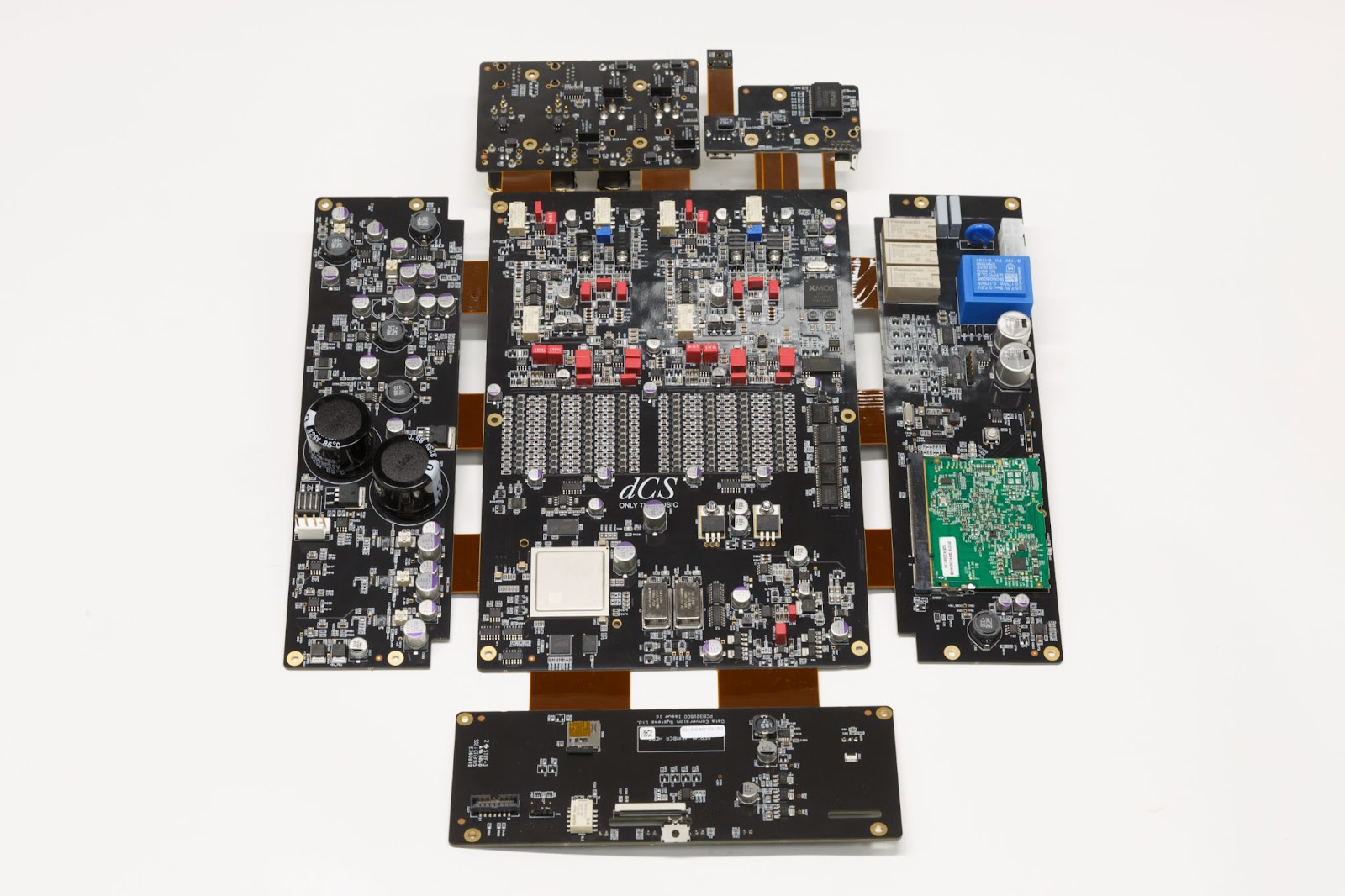
The Lina Master Clock performs the same function as the Rossini Master Clock, and is housed in the smaller Lina chassis. Clocking is used to keep the digital circuits, including power supplies, high-speed signal processing and modulation, in sync with the main audio clock and operating at exactly the same time. This effectively serves to reduce jitter and as a result improves the sound quality when using the network or USB inputs.
The Lina Headphone Amplifier is a completely new Class AB design with increased power output (2W per channel) as compared to the Bartok’s internal headphone amplifier (1.4W per channel), which benefits the hardest to drive headphones, such as the Hifiman Susvara, and Abyss line of headphones.
I’ve now had the opportunity to demo the dCS Lina stack over the past several weeks and to also compare the Lina to the Bartok.
Unboxing and First Impressions
The Lina system ships in three separate boxes, each box opens to reveal an interior box which contains the Lina unit, along with all of the cables necessary to connect the system. For the DAC, this includes short XLR cables to connect to the Amplifier, and an Ethernet cable; and in the case of the Master Clock, the BNC cables that connect to the DAC. Additionally, there are power link cables which enable the entire system's power to be managed from one of the units.
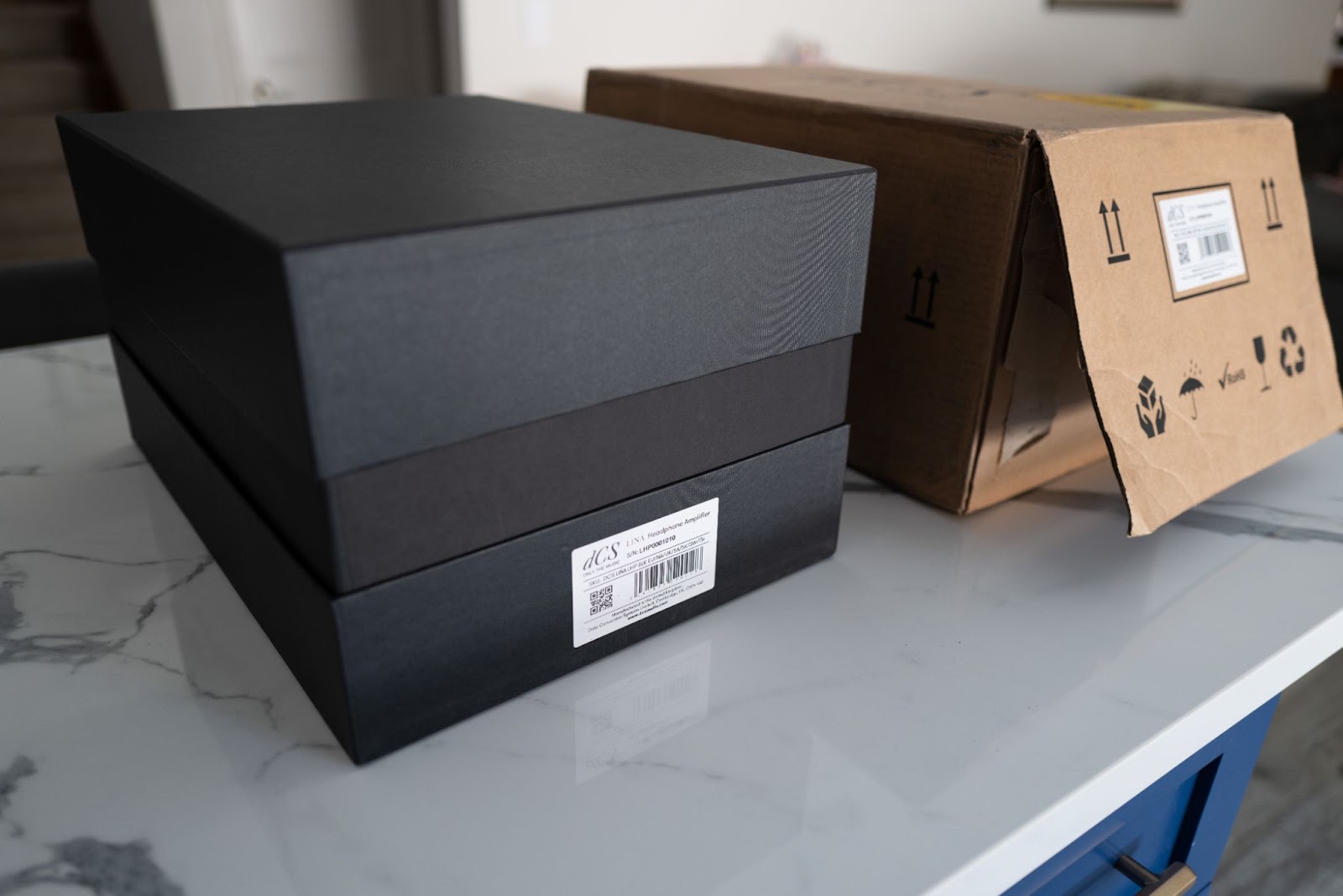
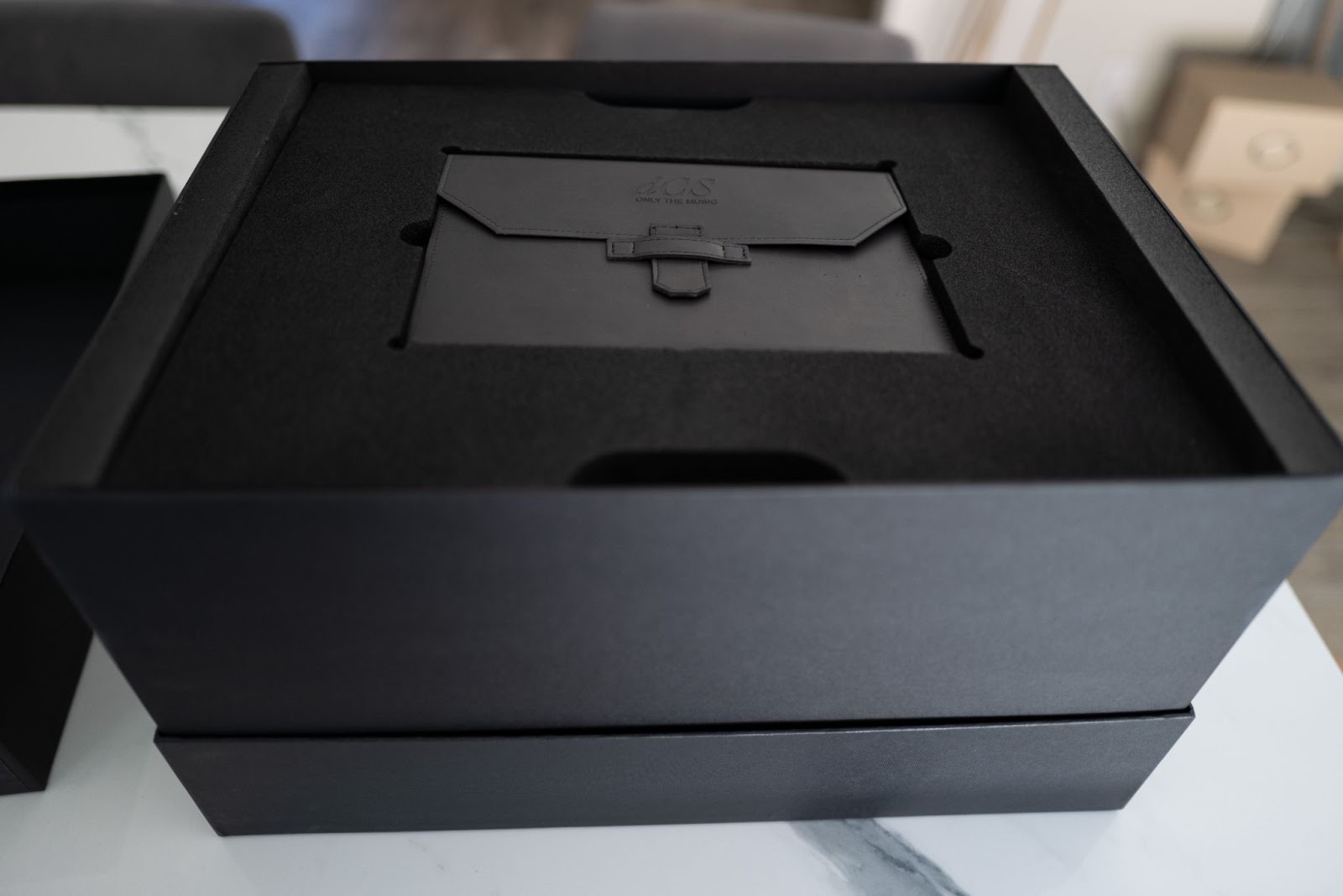
The Lina product line was purpose built from the ground up to be a headphone audio product. With the components being in a half-sized chassis measuring 9” wide, 13” deep, and 5” tall, the Lina stack strikes an uber impressive presence on the desk. Yet is also fully compatible with a wide range of placement environments, such as audio racks, and shelving units.

Each unit has an extremely high level of build quality and solid heft, with aluminum casing finished in a beautiful matte black with an ultra smooth finish on the front and rear elements. The key features of each are as follows (taken from dCS source material):
Lina Network DAC
The Lina system is designed to be a full digital audio playback system. I normally listen to a wide variety of music and media content from many different sources, including the playback of lossless audio files stored on my computer’s hard drives, streaming of lossless and hi-res audio files from qobuz and Apple Music, media content consumption from YouTube, as well as digital audio playback from AppleTV apps such as Netflix, Amazon Prime Video, and others. Using the touch sensitive inputs just under the Lina DAC screen, I can seamlessly switch the input source for my given application. In lieu of a dedicated remote control, the dCS Mosaic app can perform most of the essential functions of the system, including input changes, and the toggling of various DAC options.
For music listening specifically, I used the Lina as a Roon endpoint to manage both my hard drive based music files as well as my streaming music content.
There are a couple of ways to position the Lina system. After initially placing the units in a side by sided configuration in my audio rack, I opted to stack the units on top of each other. Not only does this end up saving space, it is also immensely satisfying to operate the system from a seated desktop position. The large volume control on the Lina headphone amp is buttery smooth and provides extremely precise control, similar to the Bartok.
dCS recommends having the headphone amplifier on the bottom, master clock in the middle, and the streaming DAC on top. Fortunately, dCS includes all of the necessary cabling for the connections between the Lina units in the box, including different AC power plugs for various regions. I have the system set up as follows:
From the DAC:
Operation
The primary ways to use the Lina system are with dCS’s own proprietary Mosaic app or with Roon. Both are excellent options and in terms of sound quality are close enough to each other to be able to call a wash. YMMV.
The Mosaic app does have the advantage of being able to function as a full fledged remote control for the Lina system. It has the ability to change inputs, engage the crossfeed and filter functionality, control the Lina DAC display, and to toggle between the various sync modes. In short, nearly all of the functionality of the menu system on the DAC unit itself is accessible through the Mosaic app. On the other hand, the Roon app has the advantage of having a desktop app which is easier to use throughout the day rather than having to use the phone. As the Lina does not have the option for remote volume control, a desktop placement of the system is recommended.

Sound Impressions
Right off the bat, it became quickly apparent that the Lina stack is a top-tier flagship headphone system, and one of the very best I’ve ever heard, regardless of price.
The dCS Ring DAC incorporated in the Lina uses a modified and foldable version of the Ring DAC board found in the Bartok. The Ring DAC uses a network of programmable FPGA’s that are running proprietary dCS software that performs the digital and analog conversion as well as the digital filtering. One of the key advantages of the Ring DAC is its upgradability via free firmware updates. As an example, at the time of this writing, the dCS Bartok is about to receive 2.0 firmware on May 31, 2022 and after an audition, and comparison with the current firmware, I can confirm that it is a significant sound quality upgrade.
The Lina headphone amplifier is a Class AB solid state design that outputs 2 watts per channel at 30 Ohms. dCS manages to balance voltage and current requirements such that the Lina headphone amp can handle both high and low impedance headphones. It also has a physical high/low gain switch at the bottom of the front of the unit. Although I generally do not use IEMs in a desktop environment, I did try out the qdc Anole V14 with the Lina amp in the low gain setting, and the V14 sounded better than I had ever heard it before.
My impressions of the Lina system were formed by first listening to the entire system as a whole for several days before starting to tinker with listening to the differences with and without the clock, and comparing it to the Bartok DAC and internal headphone amplifier.
Lina DAC + Headphone Amp
The Lina DAC and Headphone amp alone already make an endgame system. This pairing with both the Susvara and Abyss Diana TC is staggeringly good.. The additional power output of the Lina headphone amp is immediately noticeable and translates to increased air, space, and dynamic range. The overall presentation is so well balanced and is simultaneously ruthlessly transparent and yet incredibly musical and engaging. In my experience, it usually sways in one direction or the other. Lina manages to achieve this harmony in such a powerful and impactful way. It is a truly wonderful listening experience.

Lina DAC + Headphone Amp + Master Clock
Adding the Master Clock to the system is like adding icing to an already excellent cake. The difference in sound is immediately noticeable with everything sounding a little more organic, and lifelike. The more tangible sense of realism makes the musical image sound incredibly cohesive and natural. Music just seems to flow better and I found myself more emotionally engaged. Instead of trying to critically listen to differences in bass, treble, midrange, and soundstage, I was just getting lost in the music.
Overall, it would be hard to quantify the level of improvement gained by adding the Master Clock as the DAC and Headphone Amp alone already provide excellent, endgame performance. However, to my ears, there is a noticeable improvement and it's great to have the option of an upgrade path.
Comparison with Bartok
In comparing the Lina to the Bartok, the most immediate and noticeable difference is the headphone amplifier. The Bartok’s internal headphone output is already excellent with the majority of headphones. However, there is a noticeable improvement with the Susvara and Diana TC when using the Lina Headphone amplifier.. The increased dynamics, provide a more intimate and visceral listening experience without a trace of sharpness or sibilance. The Bartok by contrast has a slightly deeper, and wider soundstage.
Connecting the Lina Master Clock to the Bartok provided a similar improvement as compared to the Bartok on its own, and sounded similar to the Rossini Master Clock and Bartok pairing that I heard at CanJam Singapore. The Bartok remains an outstanding product and is about to get a major upgrade with Bartok 2.0 firmware.
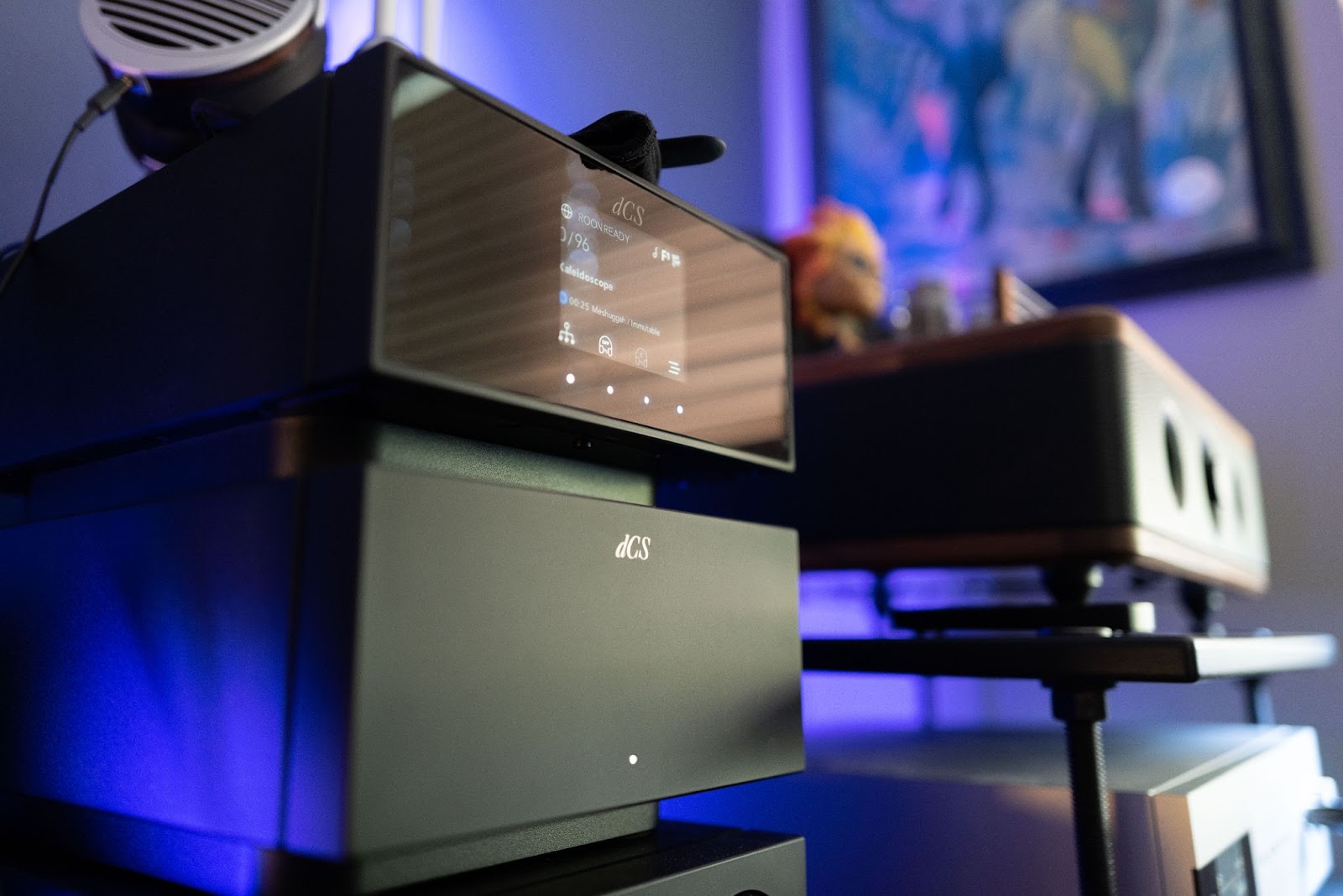
Conclusion
The dCS Lina stack is a flagship headphone system, and is also the finest solid state headphone system I’ve heard to date.
The Lina DAC and Headphone Amplifier together compare well with the Bartok in a smaller form factor that is suitable for desktop applications, and the optional addition of the Master Clock only enhances the already excellent performance. Hard to drive headphones such as the Susvara and Abyss will clearly benefit from the additional drive of the Lina headphone amp, and in particular, I have yet to hear the Susvara sound better from a solid state headphone amp.
It’s great to see a storied company such as dCS invest resources and their engineering chops in developing an audio system specifically catered for the high-end headphone enthusiast.
The dCS Lina components are individually top-tier flagship products and as a whole headphone system, one of the very best currently available. Having the flexibility of tailoring individual pieces for specific needs, or the ability to build the system incrementally over time is a welcome option.
Overall, I would enthusiastically recommend auditioning the Lina headphone system for anyone looking to build a flagship, endgame setup.
At this point in time, it would be fair to assume that most serious headphone enthusiasts have heard of dCS. The Cambridge, UK based company has been at the forefront of digital audio for many years now, and was the first to introduce asynchronous USB to a standalone DAC, called the Debussy, back in 2008. The company is revered in the high-end, hi-fi space and the dCS Bartok (current MSRP $19,950) gave us a real taste of its flagship lines, the Vivaldi and Rossini, at a more palatable price level.
Back in 2019, when dCS introduced the Bartok, the company began to realize the potential of the headphone enthusiast market. The Bartok was billed as a hybrid hi-fi product that could also cater to the headphone enthusiast market as it included an option for a excellent built-in headphone amplifier. This appealed to many enthusiasts, as a flagship all-in-one device. For context, I have been using the dCS Bartok as my reference DAC for the past few years and have been enamored with its performance as a daily driver being run every day, for most of the day.
Intrigued by reports from Bartok owners of improved performance by adding the Rossini Master Clock to the Bartok, I had the opportunity to demo and compare the standalone Bartok and the Bartok + Rossini Master Clock earlier this year, at CanJam Singapore 2022. It was a revelatory experience. The addition of the Master Clock added improved soundstage depth, sounded more focused, and seemingly more musical information was able to transfer through. To draw an analogy, it was like looking at a higher resolution photo with more megapixels of information. To be clear, the Bartok already sounds excellent on its own, and the difference of adding the Master Clock only really becomes apparent on a direct A/B comparison.
Spending time with Steve Smith and Joss Marvie from dCS, I was able to learn more about the Master Clock, and its essential role in reducing jitter. Most exciting of all, I learned that dCS were about to release their first line of dedicated headphone audio products, called LINA. The Lina product line includes the Lina Network DAC (MSRP $12,750), Lina Headphone Amplifier (MSRP $9,100, and the Lina Master Clock ($7,300).
Some of the most intriguing elements of the Lina system are how the no-compromise designs were able to be housed in the smaller chassis size. For example, the Lina DAC is a full implementation of the dCS Ring DAC with a foldable board design.
The Lina Master Clock performs the same function as the Rossini Master Clock, and is housed in the smaller Lina chassis. Clocking is used to keep the digital circuits, including power supplies, high-speed signal processing and modulation, in sync with the main audio clock and operating at exactly the same time. This effectively serves to reduce jitter and as a result improves the sound quality when using the network or USB inputs.
The Lina Headphone Amplifier is a completely new Class AB design with increased power output (2W per channel) as compared to the Bartok’s internal headphone amplifier (1.4W per channel), which benefits the hardest to drive headphones, such as the Hifiman Susvara, and Abyss line of headphones.
I’ve now had the opportunity to demo the dCS Lina stack over the past several weeks and to also compare the Lina to the Bartok.
Unboxing and First Impressions
The Lina system ships in three separate boxes, each box opens to reveal an interior box which contains the Lina unit, along with all of the cables necessary to connect the system. For the DAC, this includes short XLR cables to connect to the Amplifier, and an Ethernet cable; and in the case of the Master Clock, the BNC cables that connect to the DAC. Additionally, there are power link cables which enable the entire system's power to be managed from one of the units.
The Lina product line was purpose built from the ground up to be a headphone audio product. With the components being in a half-sized chassis measuring 9” wide, 13” deep, and 5” tall, the Lina stack strikes an uber impressive presence on the desk. Yet is also fully compatible with a wide range of placement environments, such as audio racks, and shelving units.
Each unit has an extremely high level of build quality and solid heft, with aluminum casing finished in a beautiful matte black with an ultra smooth finish on the front and rear elements. The key features of each are as follows (taken from dCS source material):
Lina Network DAC
- Supports hi-res streaming via Roon, TIDAL, Qobuz, Spotify, Deezer, AirPlay, and more
- Includes the renowned dCS Ring DAC system
- dCS Expanse technology offers enhanced crossfeed options
- Touchscreen UI for navigation, system can also be controlled via dCS Mosaic app
- Class AB solid state design with 2 Watts per channel into 30 Ohms.
- Large and ultra smooth volume control knob
- High and low gain switch
- Includes 3 headphone outputs (1x single 4 pin XLR, 1x dual 3 pin XLR, and 1x single ¼” headphone jack)
- Oven-controlled crystal oscillators (one for 44.1kHz based audio sample rates and one for 48kHz) ensure accurate clocking for all audio samples and frequencies.
- Allows Lina Network DAC to be locked to a single master signal for enhanced audio performance.
- Minimizes risk of jitter and timing irregularities which can affect playback.
The Lina system is designed to be a full digital audio playback system. I normally listen to a wide variety of music and media content from many different sources, including the playback of lossless audio files stored on my computer’s hard drives, streaming of lossless and hi-res audio files from qobuz and Apple Music, media content consumption from YouTube, as well as digital audio playback from AppleTV apps such as Netflix, Amazon Prime Video, and others. Using the touch sensitive inputs just under the Lina DAC screen, I can seamlessly switch the input source for my given application. In lieu of a dedicated remote control, the dCS Mosaic app can perform most of the essential functions of the system, including input changes, and the toggling of various DAC options.
For music listening specifically, I used the Lina as a Roon endpoint to manage both my hard drive based music files as well as my streaming music content.
There are a couple of ways to position the Lina system. After initially placing the units in a side by sided configuration in my audio rack, I opted to stack the units on top of each other. Not only does this end up saving space, it is also immensely satisfying to operate the system from a seated desktop position. The large volume control on the Lina headphone amp is buttery smooth and provides extremely precise control, similar to the Bartok.
dCS recommends having the headphone amplifier on the bottom, master clock in the middle, and the streaming DAC on top. Fortunately, dCS includes all of the necessary cabling for the connections between the Lina units in the box, including different AC power plugs for various regions. I have the system set up as follows:
From the DAC:
- Dual balanced XLR cables are connected to the XLR balanced outputs and lead to the XLR balanced inputs on the amp.
- Dual BNC cables connect from the WORDCLOCK input sockets on the DAC to the WORDCLOCK output sockets on the Master Clock
- Toslink Cable (not included in the box) connects from the SPDIF 3 Toslink input to the Toslink output on my Sony TV.
- Dual BNC cables connect the WORDCLOCK output sockets on the Lina Clock to the WORDCLOCK input sockets on the Lina DAC. Once setting the clocking sync mode on the Lina DAC to “Auto”, the Lina DAC will then select the appropriate clock input and will lock to it.
- Dual balanced XLR cables are connected to the XLR balanced input sockets on the amp and lead to the XLR balanced outputs on the DAC.
Operation
The primary ways to use the Lina system are with dCS’s own proprietary Mosaic app or with Roon. Both are excellent options and in terms of sound quality are close enough to each other to be able to call a wash. YMMV.
The Mosaic app does have the advantage of being able to function as a full fledged remote control for the Lina system. It has the ability to change inputs, engage the crossfeed and filter functionality, control the Lina DAC display, and to toggle between the various sync modes. In short, nearly all of the functionality of the menu system on the DAC unit itself is accessible through the Mosaic app. On the other hand, the Roon app has the advantage of having a desktop app which is easier to use throughout the day rather than having to use the phone. As the Lina does not have the option for remote volume control, a desktop placement of the system is recommended.
Sound Impressions
Right off the bat, it became quickly apparent that the Lina stack is a top-tier flagship headphone system, and one of the very best I’ve ever heard, regardless of price.
The dCS Ring DAC incorporated in the Lina uses a modified and foldable version of the Ring DAC board found in the Bartok. The Ring DAC uses a network of programmable FPGA’s that are running proprietary dCS software that performs the digital and analog conversion as well as the digital filtering. One of the key advantages of the Ring DAC is its upgradability via free firmware updates. As an example, at the time of this writing, the dCS Bartok is about to receive 2.0 firmware on May 31, 2022 and after an audition, and comparison with the current firmware, I can confirm that it is a significant sound quality upgrade.
The Lina headphone amplifier is a Class AB solid state design that outputs 2 watts per channel at 30 Ohms. dCS manages to balance voltage and current requirements such that the Lina headphone amp can handle both high and low impedance headphones. It also has a physical high/low gain switch at the bottom of the front of the unit. Although I generally do not use IEMs in a desktop environment, I did try out the qdc Anole V14 with the Lina amp in the low gain setting, and the V14 sounded better than I had ever heard it before.
My impressions of the Lina system were formed by first listening to the entire system as a whole for several days before starting to tinker with listening to the differences with and without the clock, and comparing it to the Bartok DAC and internal headphone amplifier.
Lina DAC + Headphone Amp
The Lina DAC and Headphone amp alone already make an endgame system. This pairing with both the Susvara and Abyss Diana TC is staggeringly good.. The additional power output of the Lina headphone amp is immediately noticeable and translates to increased air, space, and dynamic range. The overall presentation is so well balanced and is simultaneously ruthlessly transparent and yet incredibly musical and engaging. In my experience, it usually sways in one direction or the other. Lina manages to achieve this harmony in such a powerful and impactful way. It is a truly wonderful listening experience.
Lina DAC + Headphone Amp + Master Clock
Adding the Master Clock to the system is like adding icing to an already excellent cake. The difference in sound is immediately noticeable with everything sounding a little more organic, and lifelike. The more tangible sense of realism makes the musical image sound incredibly cohesive and natural. Music just seems to flow better and I found myself more emotionally engaged. Instead of trying to critically listen to differences in bass, treble, midrange, and soundstage, I was just getting lost in the music.
Overall, it would be hard to quantify the level of improvement gained by adding the Master Clock as the DAC and Headphone Amp alone already provide excellent, endgame performance. However, to my ears, there is a noticeable improvement and it's great to have the option of an upgrade path.
Comparison with Bartok
In comparing the Lina to the Bartok, the most immediate and noticeable difference is the headphone amplifier. The Bartok’s internal headphone output is already excellent with the majority of headphones. However, there is a noticeable improvement with the Susvara and Diana TC when using the Lina Headphone amplifier.. The increased dynamics, provide a more intimate and visceral listening experience without a trace of sharpness or sibilance. The Bartok by contrast has a slightly deeper, and wider soundstage.
Connecting the Lina Master Clock to the Bartok provided a similar improvement as compared to the Bartok on its own, and sounded similar to the Rossini Master Clock and Bartok pairing that I heard at CanJam Singapore. The Bartok remains an outstanding product and is about to get a major upgrade with Bartok 2.0 firmware.
Conclusion
The dCS Lina stack is a flagship headphone system, and is also the finest solid state headphone system I’ve heard to date.
The Lina DAC and Headphone Amplifier together compare well with the Bartok in a smaller form factor that is suitable for desktop applications, and the optional addition of the Master Clock only enhances the already excellent performance. Hard to drive headphones such as the Susvara and Abyss will clearly benefit from the additional drive of the Lina headphone amp, and in particular, I have yet to hear the Susvara sound better from a solid state headphone amp.
It’s great to see a storied company such as dCS invest resources and their engineering chops in developing an audio system specifically catered for the high-end headphone enthusiast.
The dCS Lina components are individually top-tier flagship products and as a whole headphone system, one of the very best currently available. Having the flexibility of tailoring individual pieces for specific needs, or the ability to build the system incrementally over time is a welcome option.
Overall, I would enthusiastically recommend auditioning the Lina headphone system for anyone looking to build a flagship, endgame setup.
Last edited:
AudioTransit9213
I believe it said "remote volume control". There's definitely a large volume knob on the amplifier.
adydula
Amazing how a really high cost amp that only produces 2 watts can drive Susvaras well. Many folks think Susvaras need mega watts to be driven very well. Several other amps that have 3+ watts have been described as not the best for Susvaras. Makes me wonder at times...if 2 watts at such a high price is well...???
Pros: Balanced and transparent sound signature, and powerful amplification for a dongle DAC. A clear upgrade in sound quality when adding to computers/mobile devices.
Cons: None
Introduction
THX. A legendary company founded in 1983 by George Lucas. THX became known for developing high fidelity audio/visual reproduction standards for movie theaters, with the goal of helping filmmakers translate their work to the big screen in the best way possible. THX certification became known as the gold standard in the audio/visual industry.
More recently, THX developed its AAA (Achromatic Audio Amplifier) technology for use in headphone audio products with a stated goal of providing the highest fidelity audio with extremely low levels of noise, distortion, and power consumption. I distinctly remember hearing the first prototype THX AAA headphone amplifier at CES several years ago and it was one of my personal highlights of the show that year.
I later had the chance to extensively use the Benchmark HPA4 headphone amplifier which uses THX AAA technology and the HPA4 remains one of my all time favorite solid state headphone amplifiers, regardless of price.
So it was with great anticipation that I found out about the THX Onyx earlier this year. The first consumer product directly from THX.

The THX Onyx is a portable DAC/AMP and is part of a slew of dongle DAC products that have hit the market over the past couple of years. The purpose of the dongle DAC is to provide the user with better sound quality as compared to using a direct connection with a laptop or smartphone. With most recent smartphones ditching the headphone jack altogether, the dongle DAC provides a direct USB-C connection. The Onyx stands out from the crowd by its utilization of THX’s AAA technology and by its relatively high price of $199, as compared to many more affordable dongle DAC’s. Let’s find out how it performs.
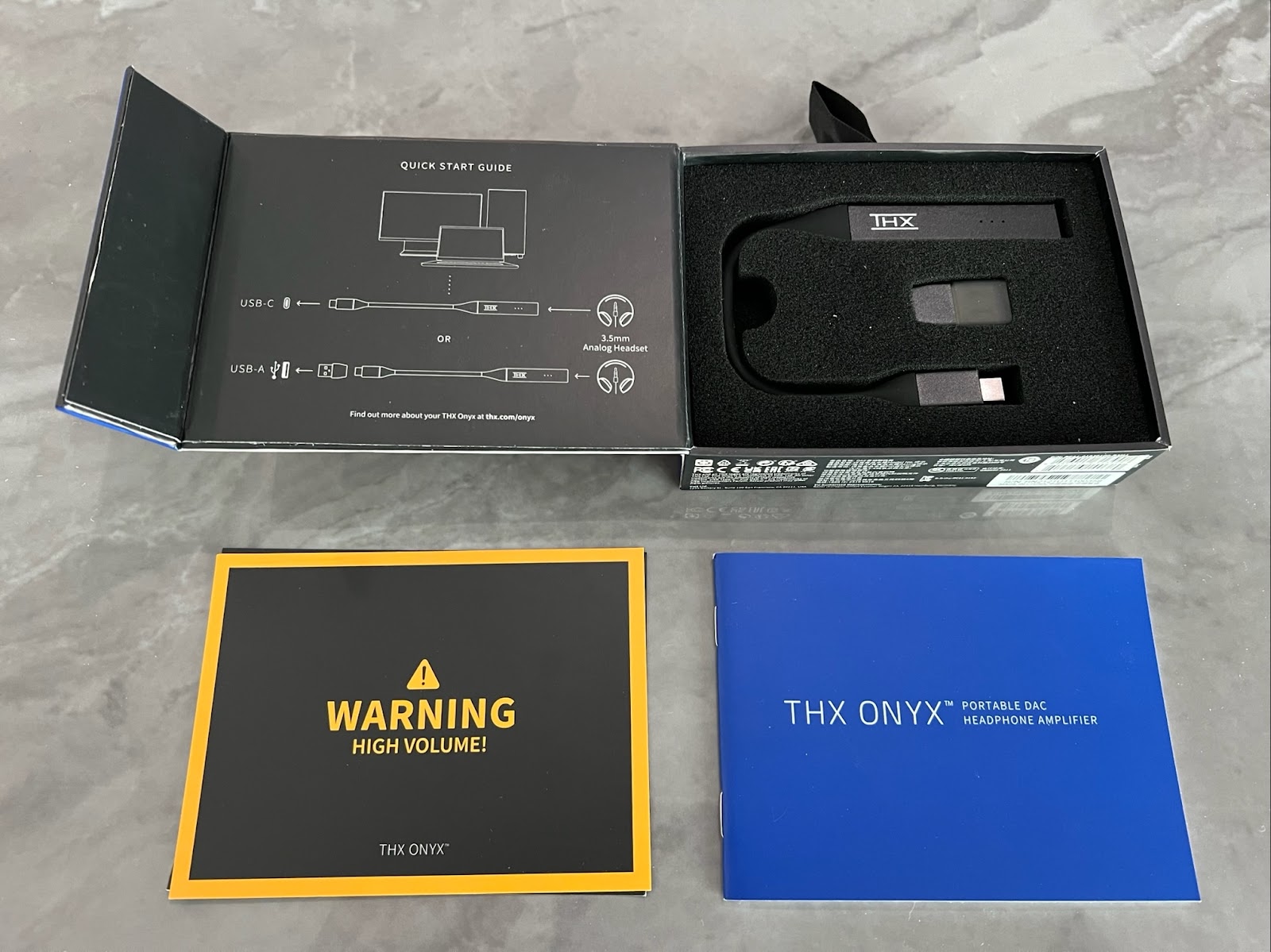
Unboxing, Build, and Features
Taking the Onyx out of the box reveals a rather large and well constructed dongle DAC, coming in at around 8 inches long. One of the immediately noticeable features of the product is the soft-touch rubber feeling cable sleeve which connects to the actual unit with a built-in strain relief. There are also magnets in the unit end and the USB connection end, which enable the folding over of the cable for easy transportation or storage. The Onyx connects via USB-C, and a USB-C to USB-A adapter is also included in the box. This makes for an easy connection to computers and Android devices.
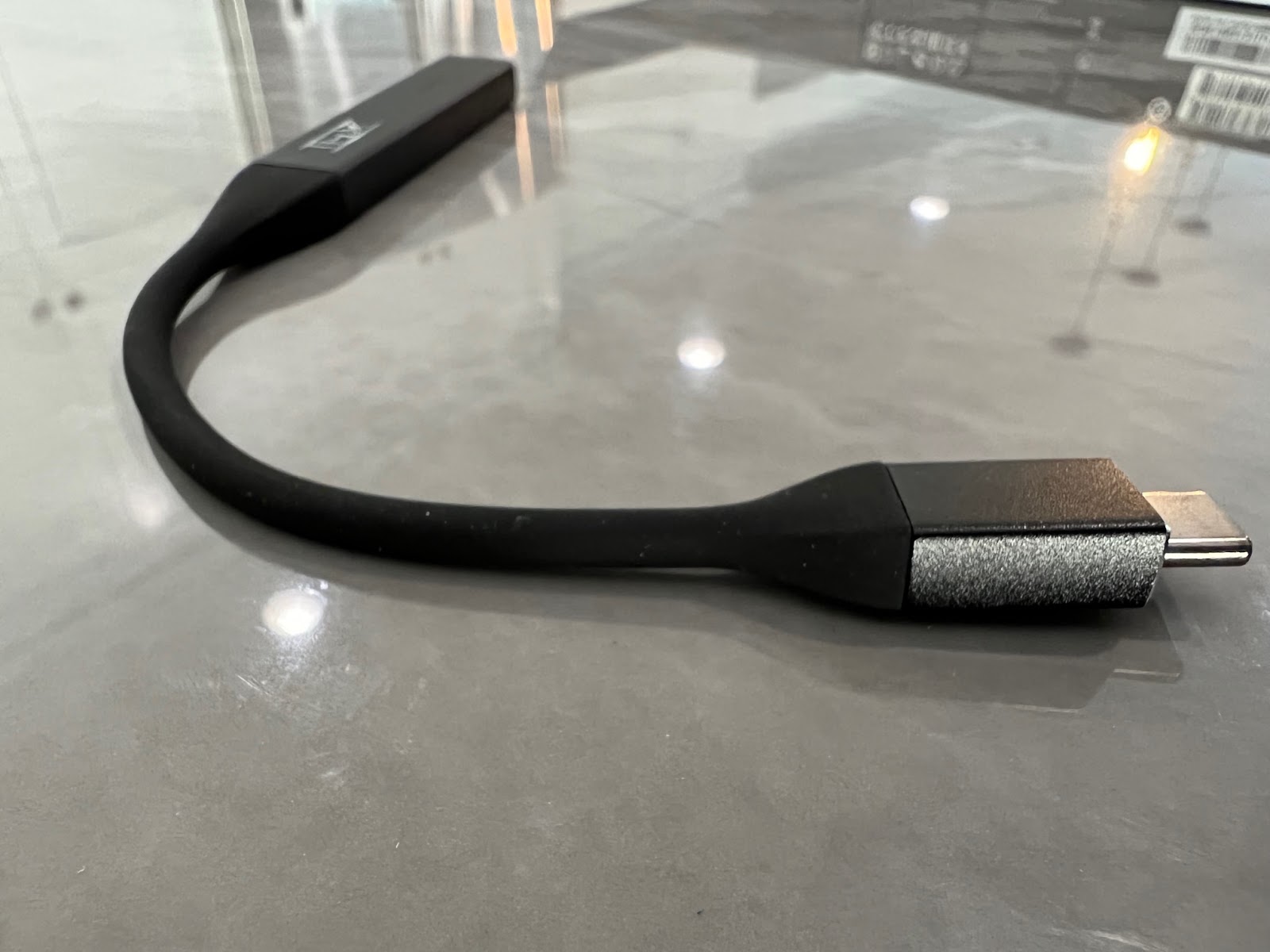
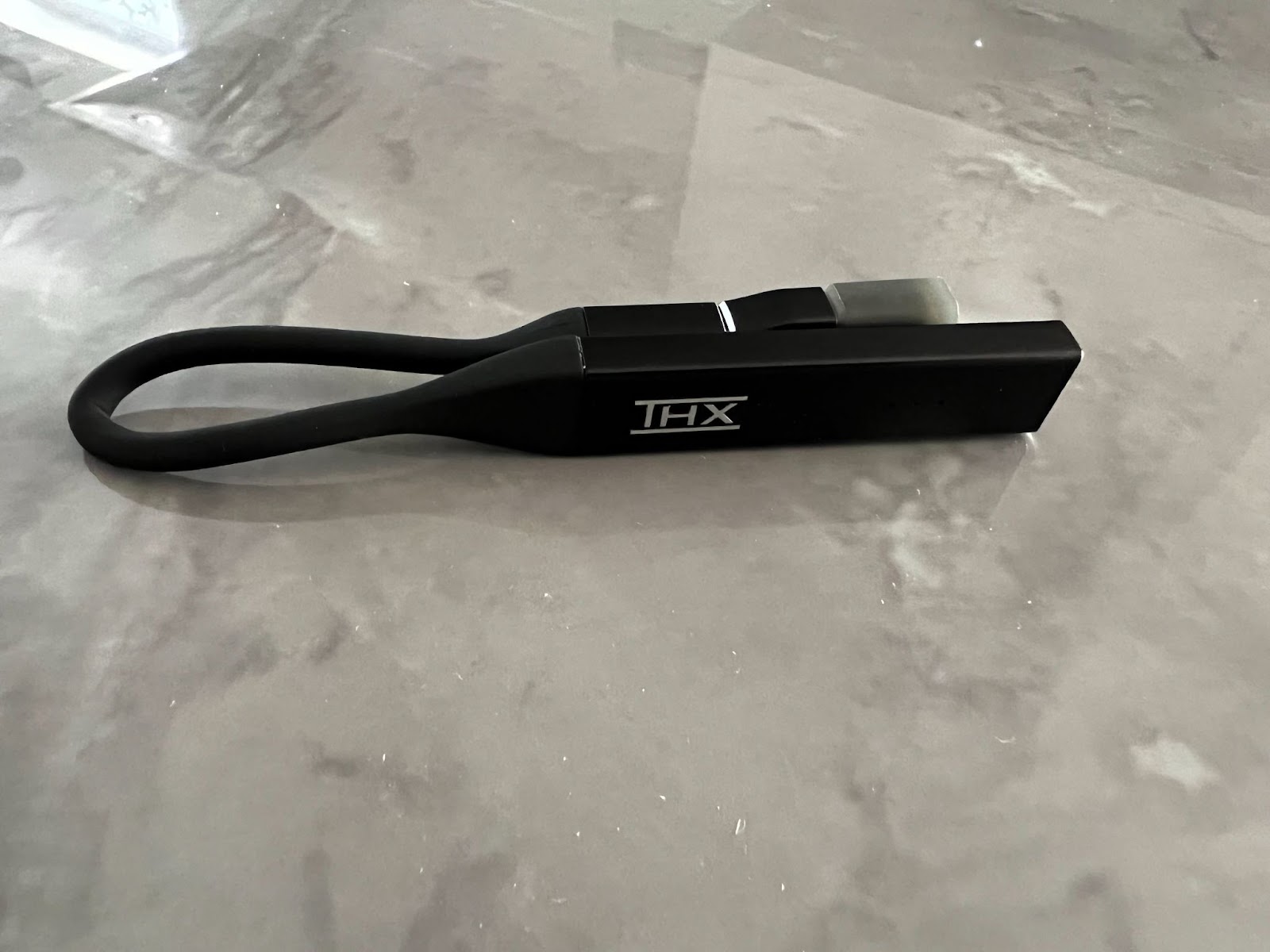
Apple iPhone users will need to add a Lightning to USB camera adapter along with the included USB-C to USB-A adapter, and while this is somewhat convoluted, it works perfectly well and was my preferred method of using the Onyx.
The Onyx uses the ESS ERS9281PRO DAC chip for its D/A conversion and uses its in-house THX AAA amplifier technology to help deliver enough power to drive higher impedance headphones. And while I exclusively used IEM’s with the Onyx, I can confirm that it can drive my more demanding IEMs with authority and plenty of headroom.
The Onyx features a set of 3 status indicators that are color coded based on the audio signal being passed through. Blue indicator lights are Standard quality 44.1 or 48 kHz PCM, Yellow lights indicate High resolution files over 48 kHz PCM, Red lights indicate DSD files, and Orange lights indicate MQA files, which is currently the highest supported format. The Onyx is capable of sending audio up to 32-bit/384kHz.

I tested out the Onyx in a couple of configurations. The first was connecting to my laptop directly with the USB-C connection. The second was to my iPhone which requires the use of the included USB-C to USB-A adapter as well as the Apple Lightning to USB camera connection kit. In both cases my primary IEM was the qdc Anole V14.
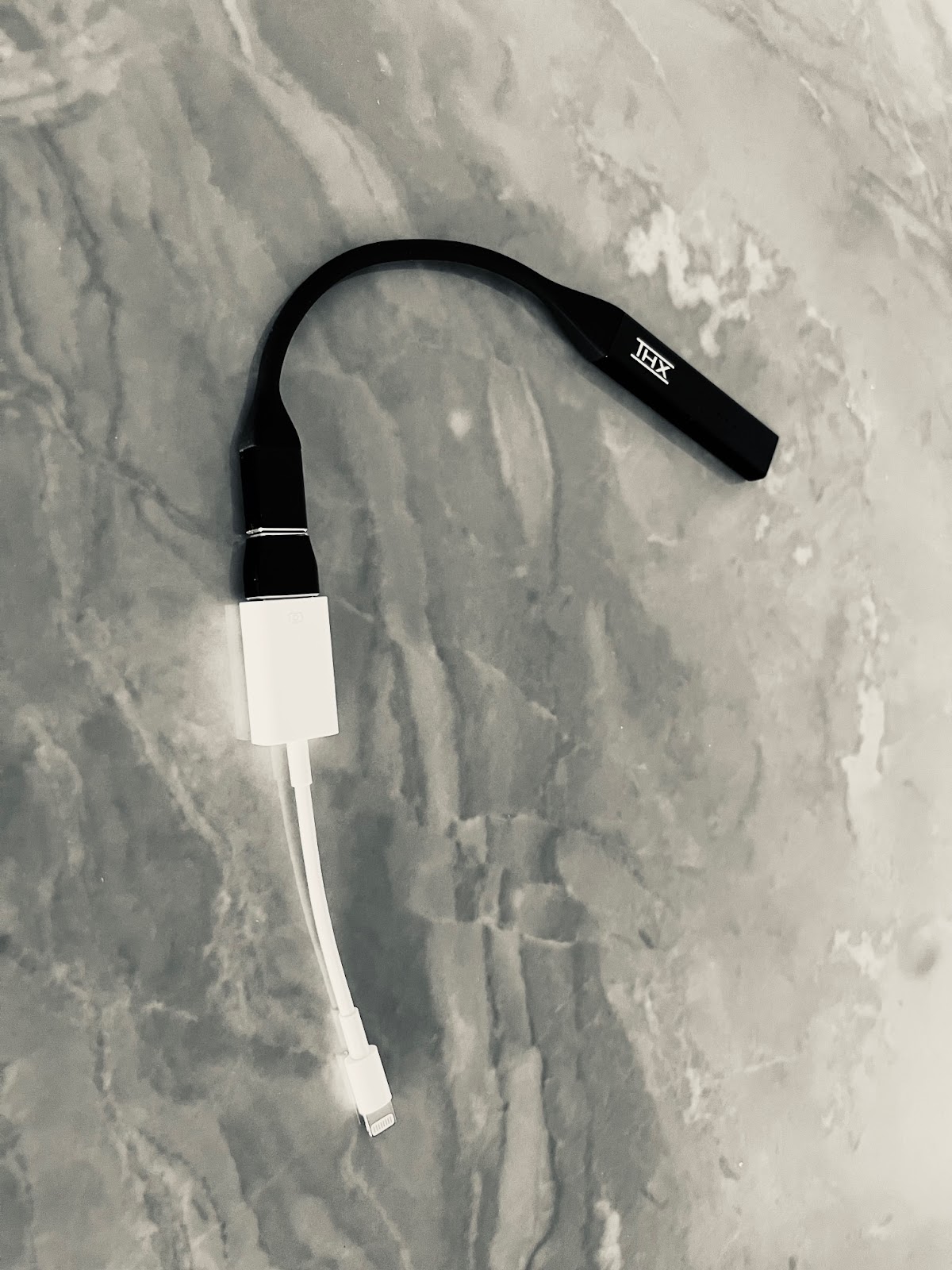
Sound Quality
In evaluating the sound quality of the THX Onyx, it was important to keep in context both the stated goal of the product as well as its price point of $199. The goal of the Onyx and dongle DACs in general, is to improve the sound over the existing internal DAC and headphone amplification of a computer or mobile device. In both of my use cases, the Onyx provided a cleaner and clearer musical experience and reminded me of some of the better portable DAC/Amp products I’ve heard over the years. With a sound signature on the neutral side and the AAA amplification stage providing gobs of headroom, I found the improved sound quality to be excellent, especially for the price point.
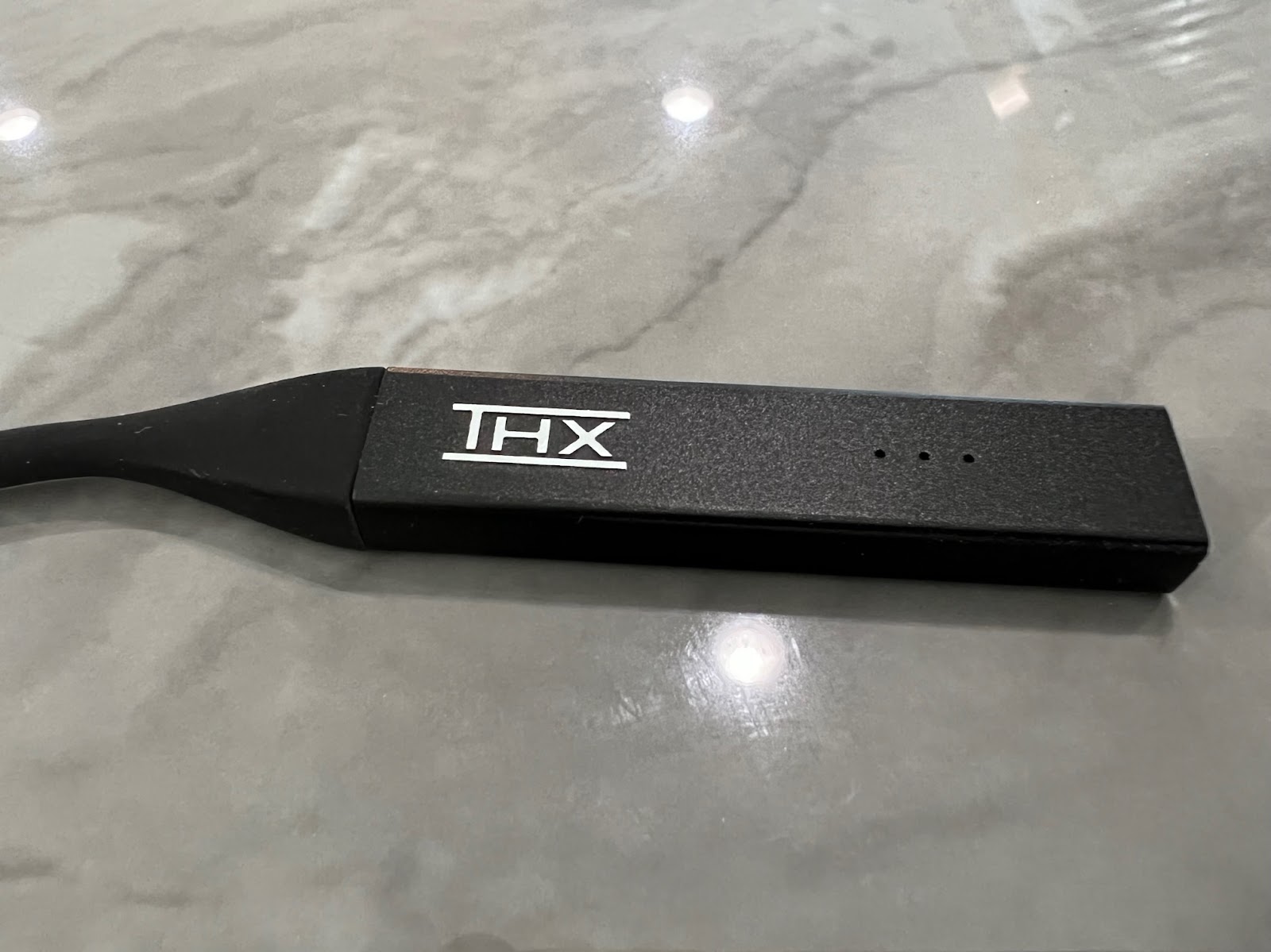
Conclusion
The $199 THX Onyx is a great value and an easy recommendation for anyone looking for a dongle DAC to improve the sound quality from their mobile devices. It combines a balanced and transparent sound signature, along with a powerful amplification stage that will be able to drive all of your IEMs and most full size headphones with plenty of headroom. This is a must audition for anyone in the market for a dongle DAC. Highly recommended!
THX. A legendary company founded in 1983 by George Lucas. THX became known for developing high fidelity audio/visual reproduction standards for movie theaters, with the goal of helping filmmakers translate their work to the big screen in the best way possible. THX certification became known as the gold standard in the audio/visual industry.
More recently, THX developed its AAA (Achromatic Audio Amplifier) technology for use in headphone audio products with a stated goal of providing the highest fidelity audio with extremely low levels of noise, distortion, and power consumption. I distinctly remember hearing the first prototype THX AAA headphone amplifier at CES several years ago and it was one of my personal highlights of the show that year.
I later had the chance to extensively use the Benchmark HPA4 headphone amplifier which uses THX AAA technology and the HPA4 remains one of my all time favorite solid state headphone amplifiers, regardless of price.
So it was with great anticipation that I found out about the THX Onyx earlier this year. The first consumer product directly from THX.
The THX Onyx is a portable DAC/AMP and is part of a slew of dongle DAC products that have hit the market over the past couple of years. The purpose of the dongle DAC is to provide the user with better sound quality as compared to using a direct connection with a laptop or smartphone. With most recent smartphones ditching the headphone jack altogether, the dongle DAC provides a direct USB-C connection. The Onyx stands out from the crowd by its utilization of THX’s AAA technology and by its relatively high price of $199, as compared to many more affordable dongle DAC’s. Let’s find out how it performs.
Unboxing, Build, and Features
Taking the Onyx out of the box reveals a rather large and well constructed dongle DAC, coming in at around 8 inches long. One of the immediately noticeable features of the product is the soft-touch rubber feeling cable sleeve which connects to the actual unit with a built-in strain relief. There are also magnets in the unit end and the USB connection end, which enable the folding over of the cable for easy transportation or storage. The Onyx connects via USB-C, and a USB-C to USB-A adapter is also included in the box. This makes for an easy connection to computers and Android devices.
Apple iPhone users will need to add a Lightning to USB camera adapter along with the included USB-C to USB-A adapter, and while this is somewhat convoluted, it works perfectly well and was my preferred method of using the Onyx.
The Onyx uses the ESS ERS9281PRO DAC chip for its D/A conversion and uses its in-house THX AAA amplifier technology to help deliver enough power to drive higher impedance headphones. And while I exclusively used IEM’s with the Onyx, I can confirm that it can drive my more demanding IEMs with authority and plenty of headroom.
The Onyx features a set of 3 status indicators that are color coded based on the audio signal being passed through. Blue indicator lights are Standard quality 44.1 or 48 kHz PCM, Yellow lights indicate High resolution files over 48 kHz PCM, Red lights indicate DSD files, and Orange lights indicate MQA files, which is currently the highest supported format. The Onyx is capable of sending audio up to 32-bit/384kHz.
I tested out the Onyx in a couple of configurations. The first was connecting to my laptop directly with the USB-C connection. The second was to my iPhone which requires the use of the included USB-C to USB-A adapter as well as the Apple Lightning to USB camera connection kit. In both cases my primary IEM was the qdc Anole V14.
Sound Quality
In evaluating the sound quality of the THX Onyx, it was important to keep in context both the stated goal of the product as well as its price point of $199. The goal of the Onyx and dongle DACs in general, is to improve the sound over the existing internal DAC and headphone amplification of a computer or mobile device. In both of my use cases, the Onyx provided a cleaner and clearer musical experience and reminded me of some of the better portable DAC/Amp products I’ve heard over the years. With a sound signature on the neutral side and the AAA amplification stage providing gobs of headroom, I found the improved sound quality to be excellent, especially for the price point.
Conclusion
The $199 THX Onyx is a great value and an easy recommendation for anyone looking for a dongle DAC to improve the sound quality from their mobile devices. It combines a balanced and transparent sound signature, along with a powerful amplification stage that will be able to drive all of your IEMs and most full size headphones with plenty of headroom. This is a must audition for anyone in the market for a dongle DAC. Highly recommended!
H T T
First, you omitted the DAC from your statement. Apple Music hi-res lossless can’t be reproduced with the Apple dongle. Also, Because music, ears, and brains are much more sophisticated and complex than limited measurements. Don’t just take my word for it. Buy or borrow an Onyx, RU6, S2, W2, etc. and hear for yourself and make your own judgments.
Joaquin Dinero
These types of devices are mainly about increasing the power over the stock hp out. More power = bigger fuller sound = sounding "better" subjectively.
Pro-Jules
incorrect.
Pros: Excellent levels of resolution, clarity, bass response, and slam.
Cons: Might be slightly bass-heavy for some.
Introduction
The past few years have seen improved performance in IEMs as transducer technology continues to advance with multiple flagship level IEMs starting to combine different types of transducers in their products. Earlier this year, and with little fanfare, the Anole V14 from qdc was released to the public at the 2021 Shanghai International Headphone Show. This new flagship of the qdc brand is the successor, and technological evolution, of the highly popular Anole VX. The VX has remained one of my favorite flagship IEM’s since first hearing it back in 2018.
For those not yet in the know, Shenzhen-based qdc is one of the largest and most technologically advanced IEM manufacturers in China. The company mainly caters to the Chinese domestic market in professional and consumer audio applications.
During our visit to China for the inaugural CanJam Shanghai show back in 2018, Jude and I got to spend some time with qdc at their headquarters in Shenzhen. The facility was highly impressive and featured a full anechoic chamber as well as some of the most advanced audio testing equipment available at the time.


The Anole VX featured 10 balanced armature drivers along with the unique feature of having 3 tuning switches for low, mid, and high frequencies.
The V14 ($2,738 MSRP) ups the ante with 14 drivers, including 10 newly customized balanced armature drivers, and 4 EST electrostatic drivers. And due to the electrostatic drivers providing more extension, there are now 4 tuning switches for low, mid, high, and ultra high frequencies.
On paper and based on this driver configuration, my expectation going in to this review was that the V14 would sound like a VX with more lower end emphasis and a smoother top end. Let’s find out.
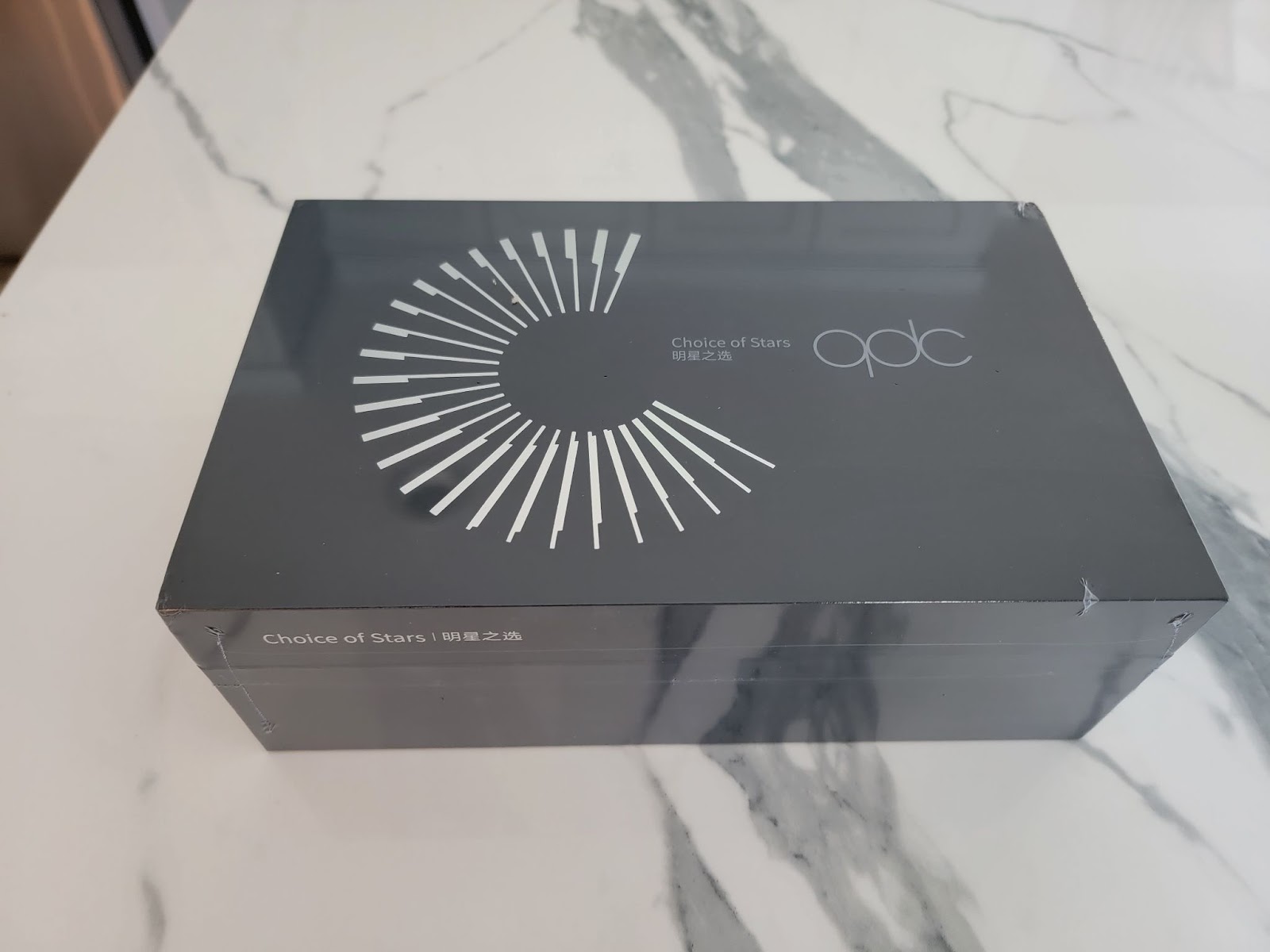
Unboxing and First Impressions
The V14 comes packaged in a robust and well designed presentation box, which upon opening elevates to present the contents inside. The first impression is of a luxury product that is decidedly low-key, with the design choice of a darker color which upon first glance looks like a fairly flat black with gold branding and design accents.
The package includes a beautifully designed carrying case which is felt-lined and leather-wrapped. It also opens and closes seamlessly using a magnetic lid. A choice of 3 adapters is included with a 2.5mm, 3.5mm, and 4.4. Pentacon adapter in the box, giving users flexibility to use with their player of choice. Also included is a set of qdc eartips, ¼” adapter, airplane adapter, care instructions, and a handy reference card for the tuning switches with suggested configurations based on the genre type.
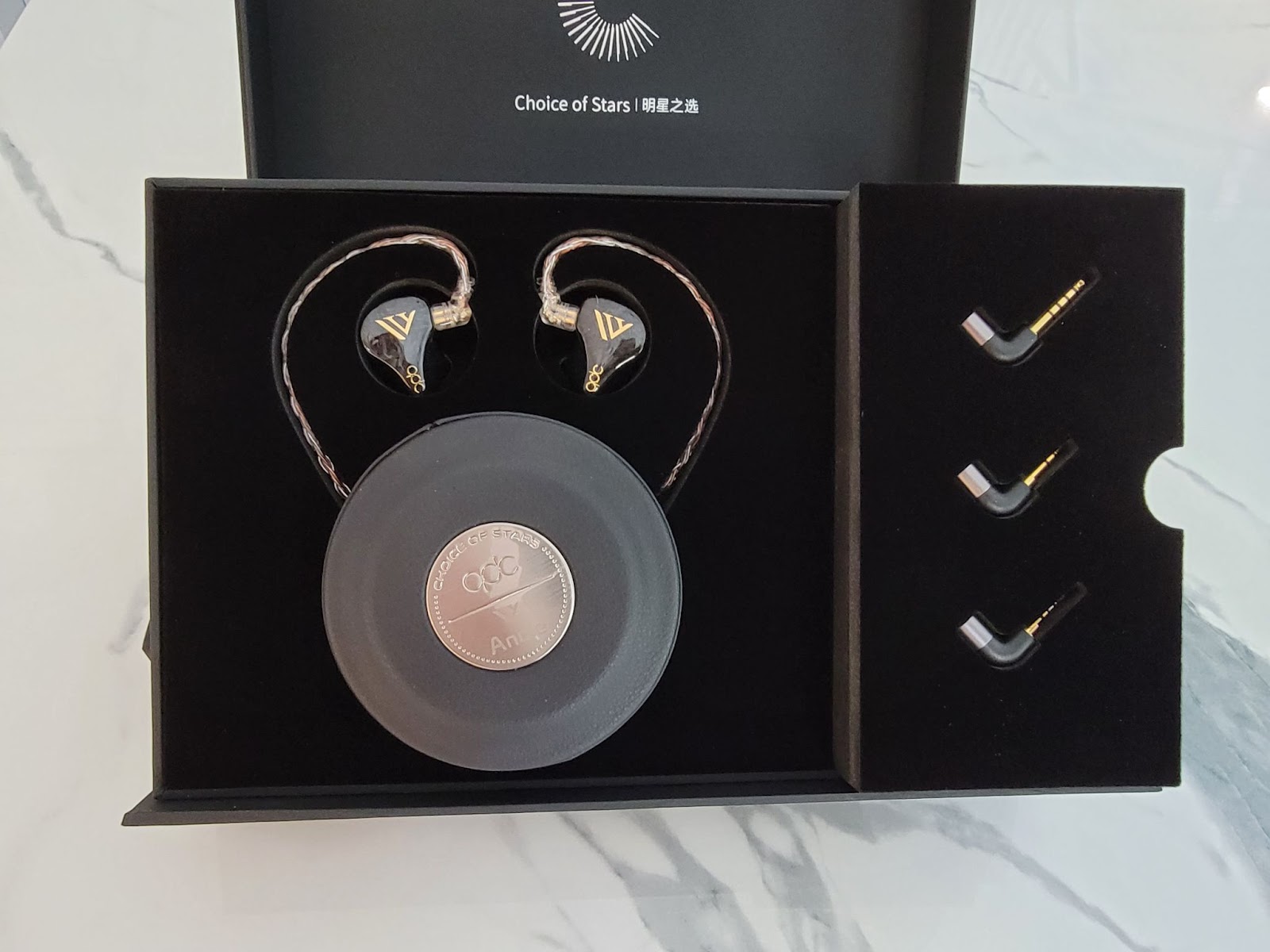
While the Anole VX impressed visually with its shimmery silver that gave the effect of seeing crushed aluminum foil inside the earcups, the V14 takes a more subtle and low key design approach. The faceplate of the V14 is made of 3D fluorescent material which after exposure to sunlight, will change into a green color. Shining a flashlight for a few seconds on to the V14 faceplate revealed a beautiful shade of green, with visually striking design inlays.
The headphone cable is a 12 core, braided silver/copper hybrid cable, which looks identical but is slightly beefier compared to the 8 core cable included with the Anole VX. And while some will undoubtedly look to explore after market cable options, the cable is ergonomically well designed, light, and folds easily without getting tangled.
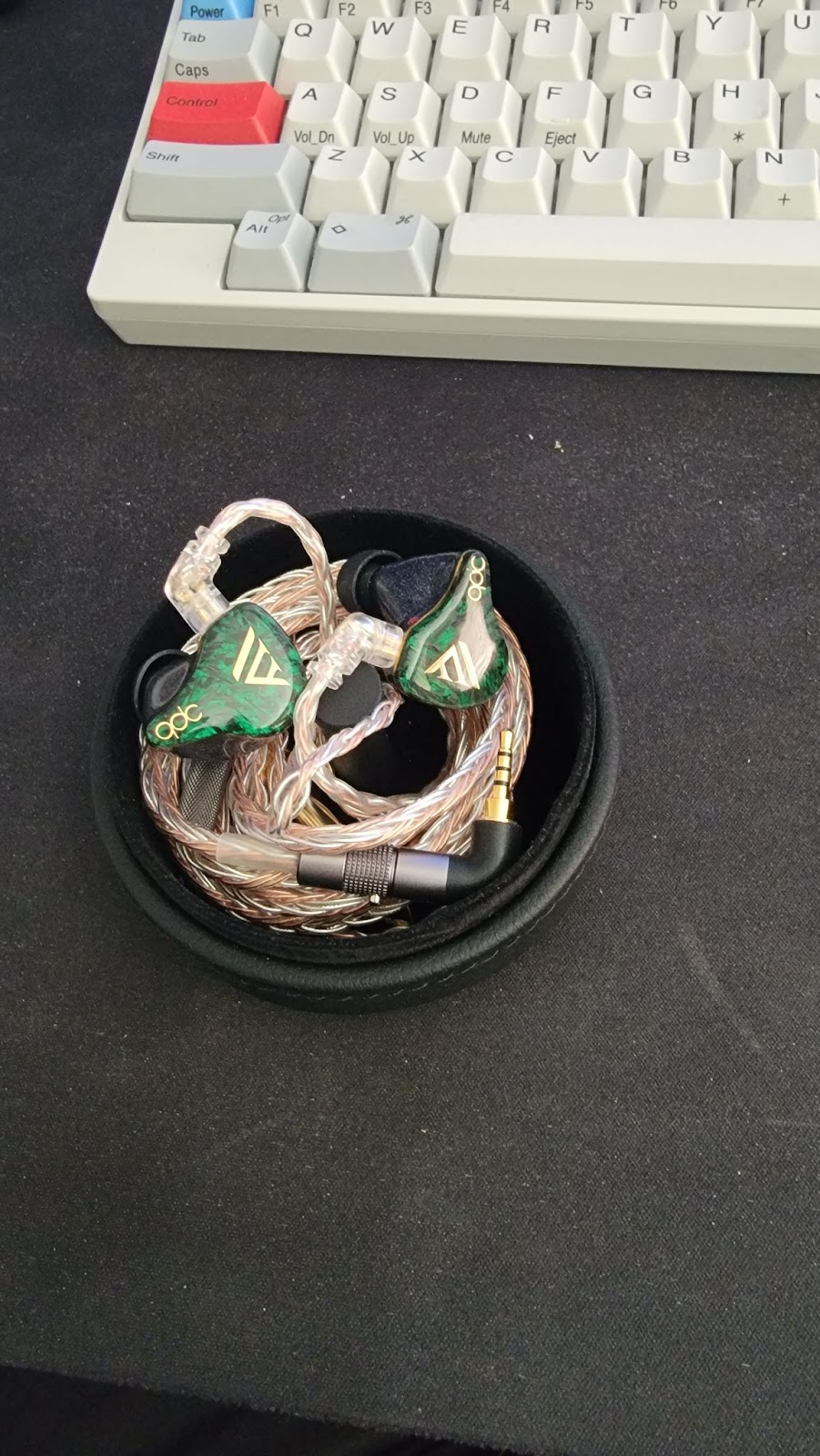
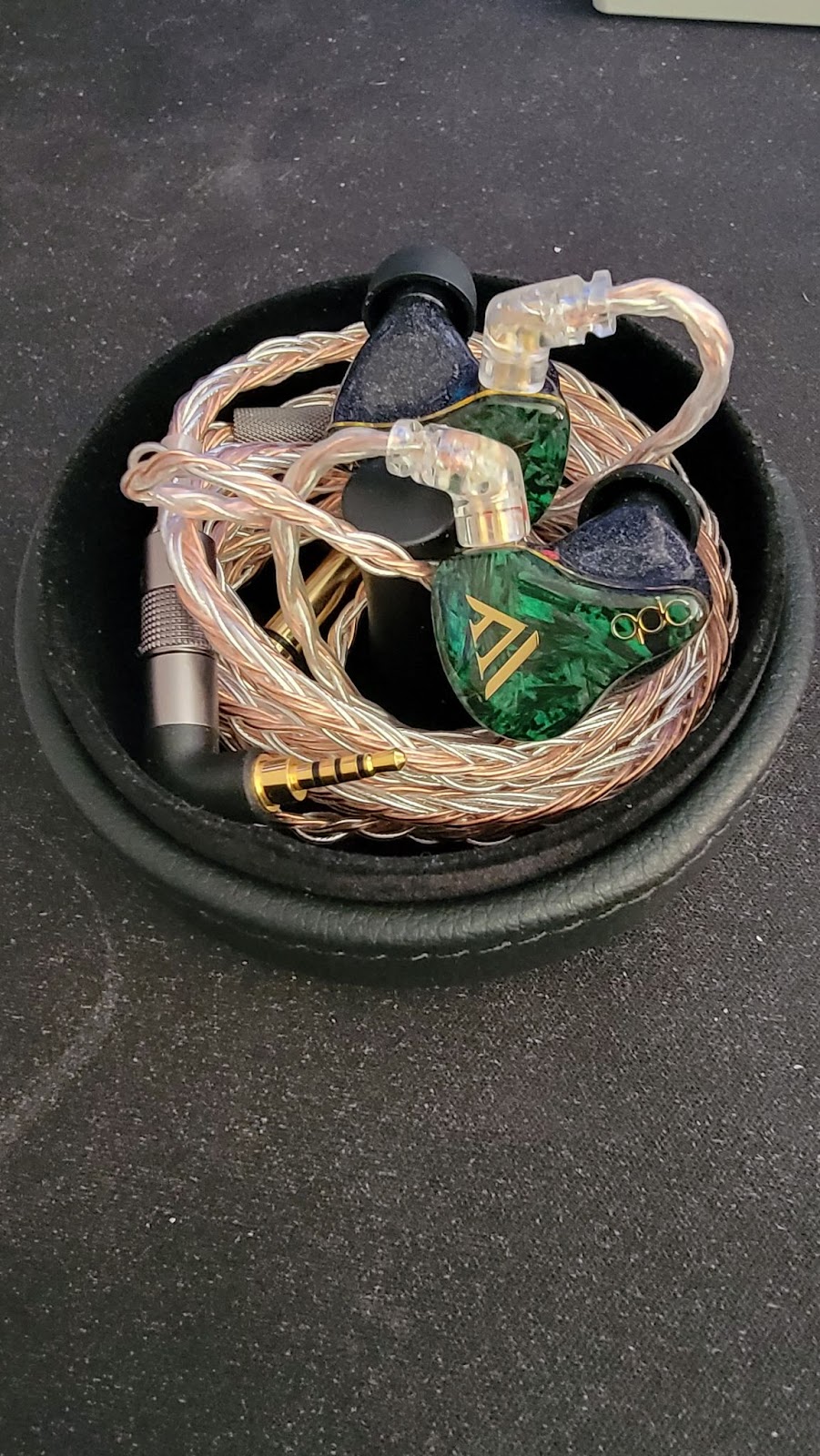
Setup
My primary configuration when using the V14 is with an Astell+Kern SP1000 Copper with the 2.5mm balanced adapter. In order to determine how the V14 scales in different configurations, I also used a THX Onyx dongle dac/headphone amplifier with the 3.5mm adapter and the dCS Bartok (in -20, low gain mode) with the ¼” adapter. Most listening impressions were with the tuning switches turned off. Although the tuning switches may appeal for certain genres, I usually try to listen to the baseline in order to get a better handle on the overall sound signature of the IEM.
Sound Impressions
The V14 is a highly resolving, engaging, and visceral listening experience. The sound signature takes all of the great elements of the Anole VX - neutral with a slight touch of warmth - and dials things up a notch. Most notably with a slightly enhanced bass response and a slightly more detailed top end. The mids are also slightly forward with great presence and intimacy.
While I would still characterize the V14 on the warm side of a neutral sound signature, the enhanced bass quality and quantity, engaging and slightly forward mids, and crystal clear and airy highs make the V14 a particularly compelling listening experience with the rock/metal/EDM genres as this IEM slams particularly well, while remaining composed and overall well balanced.
The V14 also scales extremely well and sounds absolutely sublime running in low gain mode out of the dCS Bartok. There is more air and space around instruments and the overall image is even more focused and three dimensional. The V14 manages to be musical and engaging without being fatiguing and can seamlessly tap into bass slam and visceral impact when called upon, and at the same time sound airy and delicate.

Comparisons
The following is a brief comparison of the differences between the V14 and a few other qdc IEMs:
qdc Anole VX (Universals)
The ten balanced armature driver Anole VX, remains one of my favorite flagship IEMs of the past few years and is close to my ideal sound signature with its neutral reference character with a touch of warmth. The V14 retains a similar sound signature with a slightly elevated bass response, and a more detailed top end. The result is an even more engaging listen which may suit certain genres. The VX is still more of a neutral reference sound, with the V14 a more engaging and enjoyable take on a neutral reference sound.
qdc DMagic 3d (Universals)
The qdc Dmagic 3d is a neutral triple dynamic driver IEM that puts the listener several rows back as compared to the front row listening experience of the V14. I can listen to the Dmagic 3d for hours without a hint of fatigue as everything just sounds coherent and retains good levels of musicality. The V14 sounds bigger and fuller with a higher level of overall resolution.
Conclusion
The V14 is a worthy successor to the Anole VX and is a fantastic flagship suitable for a wide range of listeners. It takes the neutral but slightly warm signature of the VX and takes it up a notch in terms of dynamics, microdetail, and bass response while maintaining a beautiful level of transparency and clarity. For my personal listening tastes, the V14 is a worthy upgrade to the VX and is a must-audition for those looking for an engaging and balanced sound, with slam, and extreme clarity. A boosted and supercharged VX.
The past few years have seen improved performance in IEMs as transducer technology continues to advance with multiple flagship level IEMs starting to combine different types of transducers in their products. Earlier this year, and with little fanfare, the Anole V14 from qdc was released to the public at the 2021 Shanghai International Headphone Show. This new flagship of the qdc brand is the successor, and technological evolution, of the highly popular Anole VX. The VX has remained one of my favorite flagship IEM’s since first hearing it back in 2018.
For those not yet in the know, Shenzhen-based qdc is one of the largest and most technologically advanced IEM manufacturers in China. The company mainly caters to the Chinese domestic market in professional and consumer audio applications.
During our visit to China for the inaugural CanJam Shanghai show back in 2018, Jude and I got to spend some time with qdc at their headquarters in Shenzhen. The facility was highly impressive and featured a full anechoic chamber as well as some of the most advanced audio testing equipment available at the time.
The Anole VX featured 10 balanced armature drivers along with the unique feature of having 3 tuning switches for low, mid, and high frequencies.
The V14 ($2,738 MSRP) ups the ante with 14 drivers, including 10 newly customized balanced armature drivers, and 4 EST electrostatic drivers. And due to the electrostatic drivers providing more extension, there are now 4 tuning switches for low, mid, high, and ultra high frequencies.
On paper and based on this driver configuration, my expectation going in to this review was that the V14 would sound like a VX with more lower end emphasis and a smoother top end. Let’s find out.
Unboxing and First Impressions
The V14 comes packaged in a robust and well designed presentation box, which upon opening elevates to present the contents inside. The first impression is of a luxury product that is decidedly low-key, with the design choice of a darker color which upon first glance looks like a fairly flat black with gold branding and design accents.
The package includes a beautifully designed carrying case which is felt-lined and leather-wrapped. It also opens and closes seamlessly using a magnetic lid. A choice of 3 adapters is included with a 2.5mm, 3.5mm, and 4.4. Pentacon adapter in the box, giving users flexibility to use with their player of choice. Also included is a set of qdc eartips, ¼” adapter, airplane adapter, care instructions, and a handy reference card for the tuning switches with suggested configurations based on the genre type.
While the Anole VX impressed visually with its shimmery silver that gave the effect of seeing crushed aluminum foil inside the earcups, the V14 takes a more subtle and low key design approach. The faceplate of the V14 is made of 3D fluorescent material which after exposure to sunlight, will change into a green color. Shining a flashlight for a few seconds on to the V14 faceplate revealed a beautiful shade of green, with visually striking design inlays.
The headphone cable is a 12 core, braided silver/copper hybrid cable, which looks identical but is slightly beefier compared to the 8 core cable included with the Anole VX. And while some will undoubtedly look to explore after market cable options, the cable is ergonomically well designed, light, and folds easily without getting tangled.
Setup
My primary configuration when using the V14 is with an Astell+Kern SP1000 Copper with the 2.5mm balanced adapter. In order to determine how the V14 scales in different configurations, I also used a THX Onyx dongle dac/headphone amplifier with the 3.5mm adapter and the dCS Bartok (in -20, low gain mode) with the ¼” adapter. Most listening impressions were with the tuning switches turned off. Although the tuning switches may appeal for certain genres, I usually try to listen to the baseline in order to get a better handle on the overall sound signature of the IEM.
Sound Impressions
The V14 is a highly resolving, engaging, and visceral listening experience. The sound signature takes all of the great elements of the Anole VX - neutral with a slight touch of warmth - and dials things up a notch. Most notably with a slightly enhanced bass response and a slightly more detailed top end. The mids are also slightly forward with great presence and intimacy.
While I would still characterize the V14 on the warm side of a neutral sound signature, the enhanced bass quality and quantity, engaging and slightly forward mids, and crystal clear and airy highs make the V14 a particularly compelling listening experience with the rock/metal/EDM genres as this IEM slams particularly well, while remaining composed and overall well balanced.
The V14 also scales extremely well and sounds absolutely sublime running in low gain mode out of the dCS Bartok. There is more air and space around instruments and the overall image is even more focused and three dimensional. The V14 manages to be musical and engaging without being fatiguing and can seamlessly tap into bass slam and visceral impact when called upon, and at the same time sound airy and delicate.

Comparisons
The following is a brief comparison of the differences between the V14 and a few other qdc IEMs:
qdc Anole VX (Universals)
The ten balanced armature driver Anole VX, remains one of my favorite flagship IEMs of the past few years and is close to my ideal sound signature with its neutral reference character with a touch of warmth. The V14 retains a similar sound signature with a slightly elevated bass response, and a more detailed top end. The result is an even more engaging listen which may suit certain genres. The VX is still more of a neutral reference sound, with the V14 a more engaging and enjoyable take on a neutral reference sound.
qdc DMagic 3d (Universals)
The qdc Dmagic 3d is a neutral triple dynamic driver IEM that puts the listener several rows back as compared to the front row listening experience of the V14. I can listen to the Dmagic 3d for hours without a hint of fatigue as everything just sounds coherent and retains good levels of musicality. The V14 sounds bigger and fuller with a higher level of overall resolution.
Conclusion
The V14 is a worthy successor to the Anole VX and is a fantastic flagship suitable for a wide range of listeners. It takes the neutral but slightly warm signature of the VX and takes it up a notch in terms of dynamics, microdetail, and bass response while maintaining a beautiful level of transparency and clarity. For my personal listening tastes, the V14 is a worthy upgrade to the VX and is a must-audition for those looking for an engaging and balanced sound, with slam, and extreme clarity. A boosted and supercharged VX.
Last edited:
jwbrent
Nice write up. I owned the VX and loved it as well, but I sold it to fund the V14 which I like even more. One of my favorites in my collection. 
KojiCO
Seriously looking forward to bringing these little babies in for review
The VX to date stands alone as one of my all-time favourites not only for the universal fit that fits like custom, but the exceptional tonal balance and the magic they have done with ba drivers
For a long time they were the only thing I could keep next to Susvara without it **** itself
Obviously not to the same league but it could stay in the same room without shivering
Here’s my in-depth review if you find interests in the VX as well
ANOLE VX FROM QDC REVIEW | An IEM from the Gods
The VX to date stands alone as one of my all-time favourites not only for the universal fit that fits like custom, but the exceptional tonal balance and the magic they have done with ba drivers
For a long time they were the only thing I could keep next to Susvara without it **** itself
Obviously not to the same league but it could stay in the same room without shivering
Here’s my in-depth review if you find interests in the VX as well
ANOLE VX FROM QDC REVIEW | An IEM from the Gods
Wasaabi
I think qdc's Anole family got a similar sound style, each of them meets my taste.
Pros: - Natural, organic sound with incredible transparency, detail, and dynamic range
- Lifelike timbre
- Excellent built-in headphone amplifier and streamer
- Upgradeable and future proof dCS Ring DAC
- Extremely high end build quality
- Lifelike timbre
- Excellent built-in headphone amplifier and streamer
- Upgradeable and future proof dCS Ring DAC
- Extremely high end build quality
Cons: - High price of entry
- Large and heavy footprint
- No included remote control
- Large and heavy footprint
- No included remote control
Introduction
The past decade has been somewhat of a golden age for headphone audio enthusiasts. In addition to the plethora of new companies and products on the scene, the level of innovation and performance has also significantly gained pace. It’s not a stretch to say that the sound quality we can achieve with our headphone audio rigs today is something that we could only dream about just a few short years ago.
One of the areas that has seen such dramatic change has been digital audio. I remember the excitement surrounding the first asynchronous USB DACs and the feeling that digital audio was finally coming of age and would someday be able to approach the performance level of vinyl playback. I also remember hearing about Cambridge, UK based dCS and was familiar that they were the first company to introduce asynchronous USB to a standalone DAC, called the Debussy, back in 2008.

Traditionally known in the hi-fi world for their proprietary, and fully upgradable, dCS Ring DAC, dCS is also known for its position at the upper echelon of the high end audio market. For reference, the full stack Vivaldi digital audio playback system (DAC, Transport, Clock, Streamer) costs over $115,000 with the Vivaldi DAC alone costing $35,000. In developing the Bartok, dCS set out to design a standalone, one box solution that would be able to provide a large dose of trickled down performance of the full stack Vivaldi system in a package that would appeal to a variety of use cases, including streaming and headphone audio listening.
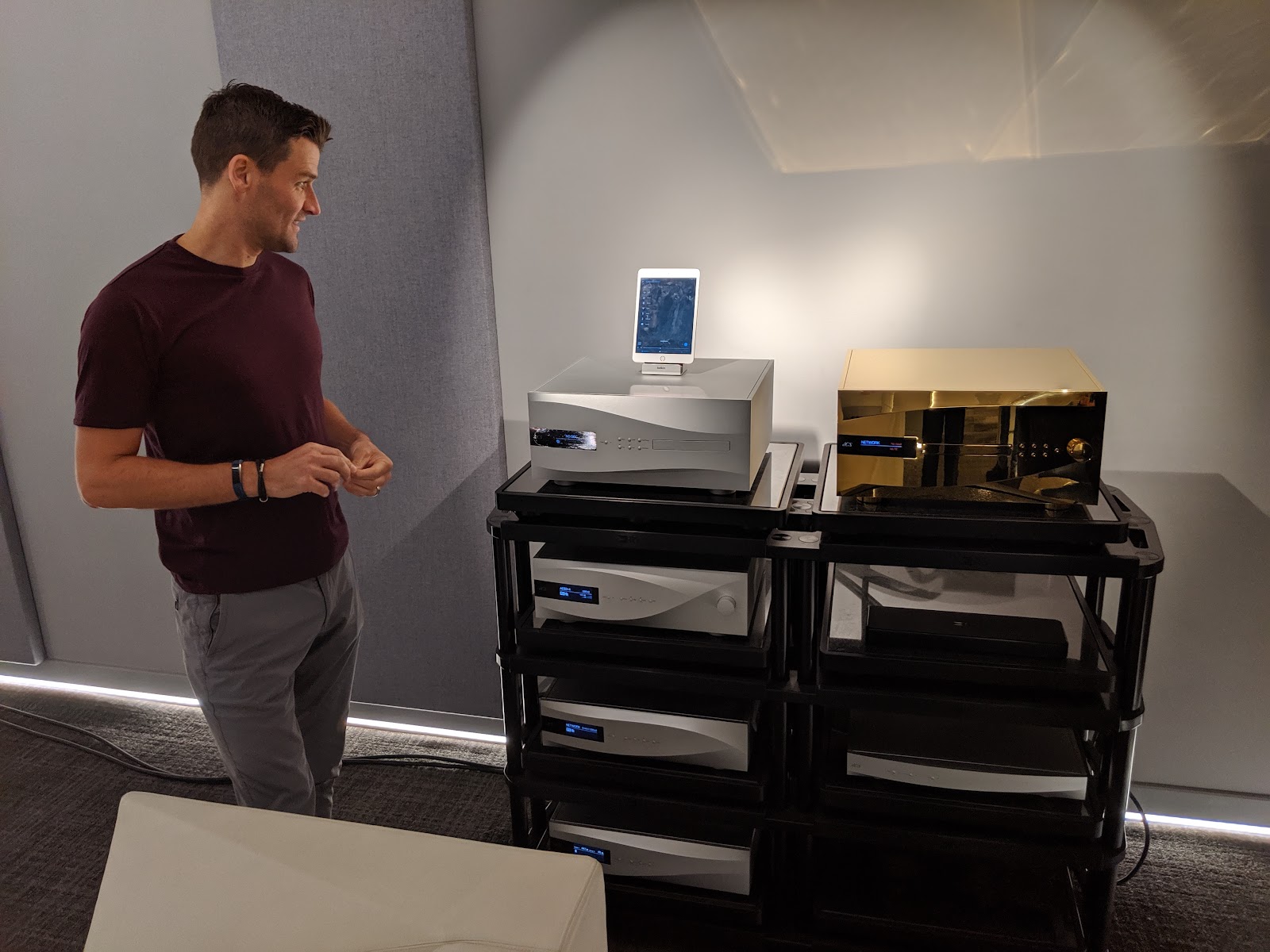
Over the years, we’ve seen several two channel audio companies dip their feet in the water with dedicated private listening rooms at various CanJam shows around the world. And until recently, it seemed that the primary goal was to introduce head-fiers to the world of two channel audio with the rationale being that headphone enthusiasts would eventually “graduate” to two channel systems when they were able to. And yet, there seems to be a recognition of the high end enthusiast headphone community as its own niche market. A market that is asking for products with more innovation and better performance along with truly high end and aspirational products that also imbue a luxury lifestyle and strong pride of ownership.
The dCS Bartok would fit into this category and would squarely aim to appeal to the headphone enthusiast looking for an end game DAC to build a rig around or someone looking for a one box solution as the Bartok includes an excellent built-in headphone amplifier and streamer.
The Bartok was released in 2019 and can be purchased either as a DAC only version (US MSRP $14,500) and as a DAC with Headphone Amplifier version (US MSRP $17,250). The subject of this review is the DAC with Headphone Amplifier version and encompasses:

After spending several months with the Bartok in my home system in 2020, I’m better able to share my longer term impressions.
Unboxing and First Impressions
The Bartok is shipped double boxed with a white dCS box containing the Bartok protected by an exterior shipping box. The unit is well cushioned in the box with foam and comes wrapped in a black fabric drawstring bag. There is an excellent and detailed 54 page user manual along with Quick Menu guide and Mosaic control one sheets.
The first noticeable thing when lifting the Bartok up for the first time is its heft and physical size. It's a weighty beast coming in at 36.8 pounds (16.7 kilos) with dimensions of 17.5” x 17” x 4.6” (444mm x 430mm x 115mm). The large dimensions of the unit make it ideally suited for a dedicated audio rack.
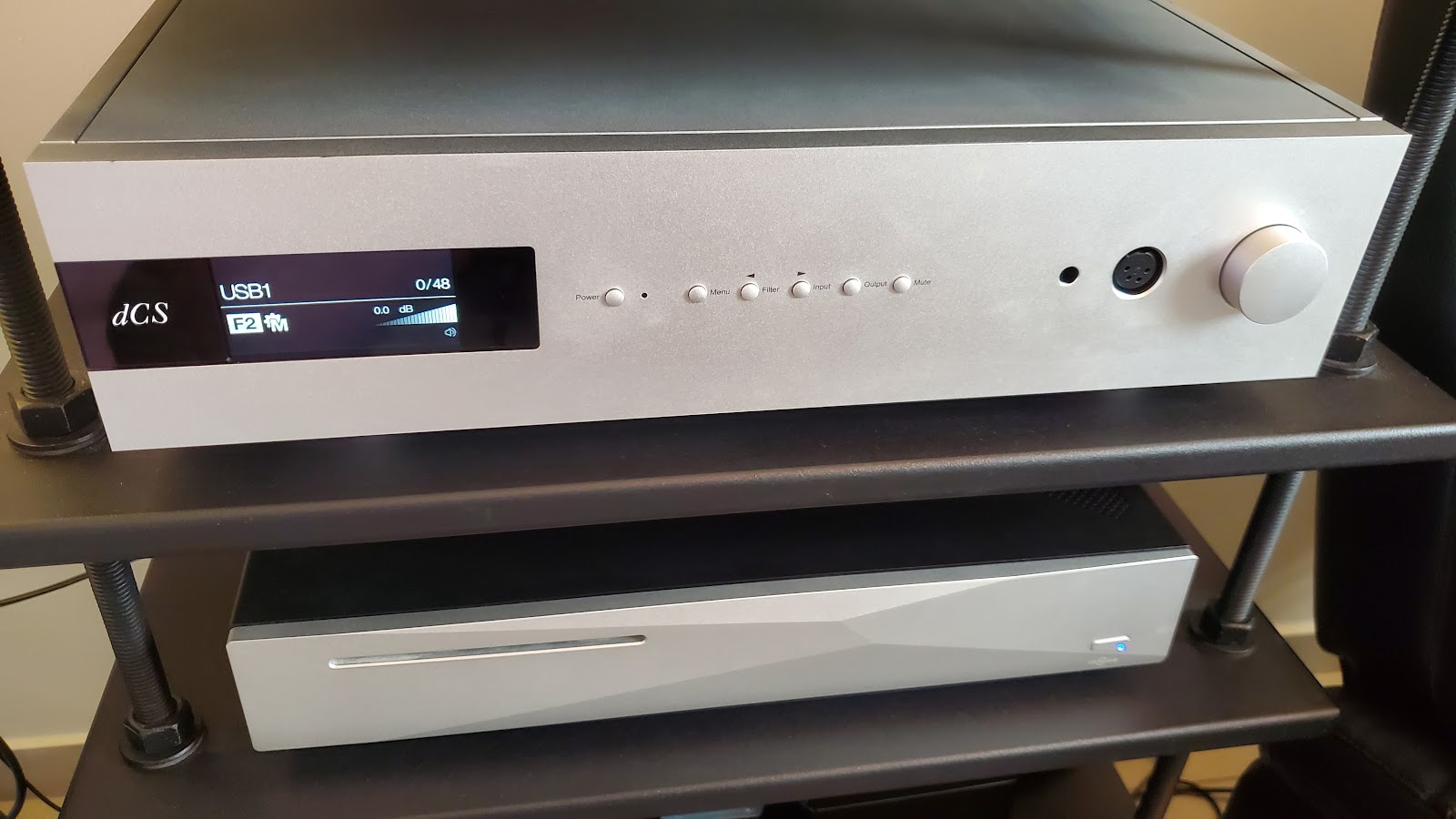
The Bartok is beautifully finished in thick, machined aluminum and feels incredibly well made and rock solid. It eschews the more sculpted fascia of its higher end dCS siblings and instead opts for a flat front panel with a hi-res screen on the left, 6 small metal buttons, two headphone outputs (one balanced, one single ended), and a silky smooth rotary volume control on the right. Although dCS does sell a dedicated remote control as an add-on option, all of the controls can be easily accessed either through the front panel menu system or the Mosaic app. There is also the possibility to connect a universal remote control and I was able to connect a Harmony 700 that was lying around with relative ease, although in my application it wasn’t fully necessary as my audio rack is placed within arms reach of my desk.
Setup
The Bartok serves as the hub of a digital audio music playback system. Like many others, I listen to music and media from a variety of sources including playback of lossless audio files stored on my computer’s hard drives, streaming of audio files from Qobuz, as well as content consumption from YouTube and digital audio playback from my Smart TV apps such as Netflix, and Amazon Prime Video. With the Bartok I can seamlessly switch the input source for my given application and for music specifically, I can use the Bartok as a Roon endpoint to manage both my hard drive based music files as well as my Qobuz streaming.
The back panel of the Bartok contains the connections for balanced and unbalanced analogue audio outputs as well as S/PIDF (coaxial and TOSLINK), AES, and USB inputs for connection to the computer and/or formatted flash drive or NAS drive. There are also Ethernet and IEC connectors as well as connectors for adding an external Master Clock to get even closer to the performance level of the dCS Rossini and Vivaldi platforms.

To set up the Bartok in my system, I connected a USB cable to my PC and this connection called “USB 1” is the connection used when listening to music stored on my PC’s hard drives and consuming content from my PC system, which in my case is mainly YouTube.
Connecting an Ethernet cable to my router, I’m then able to use the Mosaic or Roon apps to control my stored music files as well as my Qobuz streaming. When using the Bartok in this manner, the input will switch automatically to “Network”.
For watching movies and shows on my TV, I have an optical cable connected to my TV and the “SPIDF3” connection on the Bartok.
I also have a set of RCA interconnects between the analogue audio outputs on the Bartok and the Auris Headonia 2A3 headphone amplifier. I can engage the Headonia by pressing the Output button on the front panel of the Bartok which toggles between the internal headphone out and the analogue outputs.
My listening impressions were mostly done using the Hifiman Susvara and Abyss Diana Phi, and to test out IEM’s, the Vision Ears Elysium and qdc Dmagic 3D. For the Susvara specifically, I also added the Auris Audio Headonia 2A3 headphone amplifier to compare with the Bartok’s internal headphone output stage. Finally, I compared the Bartok’s built in streamer to the Innuos Zenith MK3, a highly regarded, high end music server.
Sound Impressions
The dCS Ring DAC incorporated in the Bartok uses the same Ring DAC board found in the Rossini and Vivaldi DACs, albeit using a single power supply with a second power supply performing duties for the headphone amplifier. The Ring DAC uses a network of programmable FPGAs that are running proprietary dCS software that performs the digital to analog conversion as well as the digital filtering. One of the key advantages of the Ring DAC is its upgradeability via firmware updates.
Listening to the Bartok is absolutely breathtaking. dCS are somehow able to combine transparency and dynamic range along with beautifully rendered timbre, to deliver an incredibly realistic sound experience. And it does so in a relaxed and easy-to-listen-to-for-hours fashion. Music is conveyed with a broad palette of “color” and an impeccable sense of timing which results in the Bartok sounding organic and natural. And if the goal of a DAC is to bring us as close to the music as possible with the least amount of digital “noise”, the Bartok manages to accomplish this with aplomb and finesse
Using the dCS Bartok internal headphone amplifier
The headphone amplifier of the Bartok is an in-house designed Class A headphone output stage that uses an all discrete transistor design along with its own dedicated power supply. dCS manages to balance voltage and current requirements such that the Bartok can handle both high and low impedance headphones.
Depending on headphone used, the Bartok has 4 gain positions, from 0 (loudest), to -10, -20, and -30. In this case, I use the Susvara and the Diana Phi at 0 and -10, with the IEMs being at -20 and -30. The Bartok has (6) digital filters that provide slight, but perceptible differences in how the music is presented and these filters enable the end user to better match to their own personal preference. There is also a crossfeed filter and a recently updated Expanse filter options that provide 2 additional filters for headphone users. Although my personal preference is to listen without any of the crossfeed options, it's great to have the flexibility and with certain types of recordings, it's a welcome option to have.
The Bartok’s headphone amplifier is able to drive most headphones extremely well, and even with the hard-to-drive Susvara, the Bartok sounds incredibly smooth, fast, and tight, with very good dynamics. The Diana Phi is an especially great match with the Bartok’s internal headphone amplifier and I found myself switching between 0 and -10 depending on mood and music genre.
It was also a revelatory experience listening to the Vision Ears Elysium and qdc Dmagic 3D IEMs out of the Bartok. With both IEMs at a gain setting of -20 I still had plenty of volume range and both IEMs scaled significantly higher through the Bartok than out of the Astell&Kern SP1000, that I generally use for IEMs. Transparency, speed, dynamic range all increased along with a deeper and wider soundstage. Both IEMs sounded better than I had ever heard them and had zero background noise, with a completely black background.
Using Auris Headonia as external headphone amplifier
The Auris Audio Headonia 2A3 tube headphone amplifier (US MSRP $9,899) is a great pairing for the Hifiman Susvara. When using the dCS Bartok as a DAC only there are four gain settings for the analog outs and these settings are 6V (loudest), 2V, .6V, and .2V. When listening with the Susvara, I keep the setting at 6V which gives me a comfortable to very loud volume range of between 2 and 4 (out of 10) on the Headonia volume knob.
Adding the Headonia presents a slightly more three dimensional musical image that is simultaneously both larger and more diffuse, while at the same time adding a little more emphasis on the midrange and increased dynamics and slam. On the other hand the Bartok’s headphone amplifier shines with a slightly more intimate, faster, and tighter sound against a perfectly black background which is intoxicating.
Overall, the headphone output in the dCS Bartok is an excellent solid state amplifier in its own right. Many transparent solid state headphone amps sound excellent on a short listen but induce listener fatigue over time. The Benchmark HPA4 is one of my favorite solid state amps that is both transparent, dynamic, and non-fatiguing. And the Bartok’s headphone amplifier is very similar in this regard.

Comparing Streamers
I also compared the built in streamer of the Bartok with the excellent Innuos Zenith MK3 (US MSRP $4249) running both units with Roon as an endpoint. And while there are some minor differences in how music is presented, it’s somewhat of an exercise in splitting hairs between the two when comparing sound quality. The Bartok streamer works flawlessly with both music stored on my PC’s hard drives and in streaming my Qobuz files. One of the big differences between the two is that the Innuos unit has onboard hard drive storage and can also rip CDs directly to its internal storage. In the end, I believe that the added convenience of the Bartok’s built-in streamer would likely negate the need for a separate streamer for sound quality purposes alone, unless specific additional features are required.
Conclusion
The dCS Bartok is a truly spectacular product. Essentially, this distilled version of the flagship Vivaldi and Rossini digital audio platforms, provides a one-box solution for digital audio playback using the same upgradeable dCS Ring DAC as its flagship siblings. It’s not a surprise that the Bartok DAC is a stellar performer and worthy of consideration for any end game headphone (or two channel) audio rig. The real surprise is the quality and refinement of the headphone output stage and the streaming capabilities of the dCS Bartok which largely negate the need for additional components and cables.
Headphone enthusiasts are increasingly spoiled for choice with companies like dCS pushing the envelope of what’s possible in digital audio playback. It’s also great to see a high end audio company like dCS get more involved in the headphone audio space, with their development of the headphone output stage in the Bartok.
The Bartok should be on a (very) short list for anyone looking for an end game DAC and gets my highest possible recommendation.
The past decade has been somewhat of a golden age for headphone audio enthusiasts. In addition to the plethora of new companies and products on the scene, the level of innovation and performance has also significantly gained pace. It’s not a stretch to say that the sound quality we can achieve with our headphone audio rigs today is something that we could only dream about just a few short years ago.
One of the areas that has seen such dramatic change has been digital audio. I remember the excitement surrounding the first asynchronous USB DACs and the feeling that digital audio was finally coming of age and would someday be able to approach the performance level of vinyl playback. I also remember hearing about Cambridge, UK based dCS and was familiar that they were the first company to introduce asynchronous USB to a standalone DAC, called the Debussy, back in 2008.
Traditionally known in the hi-fi world for their proprietary, and fully upgradable, dCS Ring DAC, dCS is also known for its position at the upper echelon of the high end audio market. For reference, the full stack Vivaldi digital audio playback system (DAC, Transport, Clock, Streamer) costs over $115,000 with the Vivaldi DAC alone costing $35,000. In developing the Bartok, dCS set out to design a standalone, one box solution that would be able to provide a large dose of trickled down performance of the full stack Vivaldi system in a package that would appeal to a variety of use cases, including streaming and headphone audio listening.
Over the years, we’ve seen several two channel audio companies dip their feet in the water with dedicated private listening rooms at various CanJam shows around the world. And until recently, it seemed that the primary goal was to introduce head-fiers to the world of two channel audio with the rationale being that headphone enthusiasts would eventually “graduate” to two channel systems when they were able to. And yet, there seems to be a recognition of the high end enthusiast headphone community as its own niche market. A market that is asking for products with more innovation and better performance along with truly high end and aspirational products that also imbue a luxury lifestyle and strong pride of ownership.
The dCS Bartok would fit into this category and would squarely aim to appeal to the headphone enthusiast looking for an end game DAC to build a rig around or someone looking for a one box solution as the Bartok includes an excellent built-in headphone amplifier and streamer.
The Bartok was released in 2019 and can be purchased either as a DAC only version (US MSRP $14,500) and as a DAC with Headphone Amplifier version (US MSRP $17,250). The subject of this review is the DAC with Headphone Amplifier version and encompasses:
- The dCS Ring DAC, which is the very same one found in all dCS DACs including the flagship Vivaldi.
- A Streamer that can be used with the main streaming services and as a Roon endpoint.
- An in-house designed Class A headphone output stage that uses an all discrete transistor design along with its own dedicated power supply.
- An app called Mosaic that enables full control over the digital audio system.
After spending several months with the Bartok in my home system in 2020, I’m better able to share my longer term impressions.
Unboxing and First Impressions
The Bartok is shipped double boxed with a white dCS box containing the Bartok protected by an exterior shipping box. The unit is well cushioned in the box with foam and comes wrapped in a black fabric drawstring bag. There is an excellent and detailed 54 page user manual along with Quick Menu guide and Mosaic control one sheets.
The first noticeable thing when lifting the Bartok up for the first time is its heft and physical size. It's a weighty beast coming in at 36.8 pounds (16.7 kilos) with dimensions of 17.5” x 17” x 4.6” (444mm x 430mm x 115mm). The large dimensions of the unit make it ideally suited for a dedicated audio rack.
The Bartok is beautifully finished in thick, machined aluminum and feels incredibly well made and rock solid. It eschews the more sculpted fascia of its higher end dCS siblings and instead opts for a flat front panel with a hi-res screen on the left, 6 small metal buttons, two headphone outputs (one balanced, one single ended), and a silky smooth rotary volume control on the right. Although dCS does sell a dedicated remote control as an add-on option, all of the controls can be easily accessed either through the front panel menu system or the Mosaic app. There is also the possibility to connect a universal remote control and I was able to connect a Harmony 700 that was lying around with relative ease, although in my application it wasn’t fully necessary as my audio rack is placed within arms reach of my desk.
Setup
The Bartok serves as the hub of a digital audio music playback system. Like many others, I listen to music and media from a variety of sources including playback of lossless audio files stored on my computer’s hard drives, streaming of audio files from Qobuz, as well as content consumption from YouTube and digital audio playback from my Smart TV apps such as Netflix, and Amazon Prime Video. With the Bartok I can seamlessly switch the input source for my given application and for music specifically, I can use the Bartok as a Roon endpoint to manage both my hard drive based music files as well as my Qobuz streaming.
The back panel of the Bartok contains the connections for balanced and unbalanced analogue audio outputs as well as S/PIDF (coaxial and TOSLINK), AES, and USB inputs for connection to the computer and/or formatted flash drive or NAS drive. There are also Ethernet and IEC connectors as well as connectors for adding an external Master Clock to get even closer to the performance level of the dCS Rossini and Vivaldi platforms.
To set up the Bartok in my system, I connected a USB cable to my PC and this connection called “USB 1” is the connection used when listening to music stored on my PC’s hard drives and consuming content from my PC system, which in my case is mainly YouTube.
Connecting an Ethernet cable to my router, I’m then able to use the Mosaic or Roon apps to control my stored music files as well as my Qobuz streaming. When using the Bartok in this manner, the input will switch automatically to “Network”.
For watching movies and shows on my TV, I have an optical cable connected to my TV and the “SPIDF3” connection on the Bartok.
I also have a set of RCA interconnects between the analogue audio outputs on the Bartok and the Auris Headonia 2A3 headphone amplifier. I can engage the Headonia by pressing the Output button on the front panel of the Bartok which toggles between the internal headphone out and the analogue outputs.
My listening impressions were mostly done using the Hifiman Susvara and Abyss Diana Phi, and to test out IEM’s, the Vision Ears Elysium and qdc Dmagic 3D. For the Susvara specifically, I also added the Auris Audio Headonia 2A3 headphone amplifier to compare with the Bartok’s internal headphone output stage. Finally, I compared the Bartok’s built in streamer to the Innuos Zenith MK3, a highly regarded, high end music server.
Sound Impressions
The dCS Ring DAC incorporated in the Bartok uses the same Ring DAC board found in the Rossini and Vivaldi DACs, albeit using a single power supply with a second power supply performing duties for the headphone amplifier. The Ring DAC uses a network of programmable FPGAs that are running proprietary dCS software that performs the digital to analog conversion as well as the digital filtering. One of the key advantages of the Ring DAC is its upgradeability via firmware updates.
Listening to the Bartok is absolutely breathtaking. dCS are somehow able to combine transparency and dynamic range along with beautifully rendered timbre, to deliver an incredibly realistic sound experience. And it does so in a relaxed and easy-to-listen-to-for-hours fashion. Music is conveyed with a broad palette of “color” and an impeccable sense of timing which results in the Bartok sounding organic and natural. And if the goal of a DAC is to bring us as close to the music as possible with the least amount of digital “noise”, the Bartok manages to accomplish this with aplomb and finesse
Using the dCS Bartok internal headphone amplifier
The headphone amplifier of the Bartok is an in-house designed Class A headphone output stage that uses an all discrete transistor design along with its own dedicated power supply. dCS manages to balance voltage and current requirements such that the Bartok can handle both high and low impedance headphones.
Depending on headphone used, the Bartok has 4 gain positions, from 0 (loudest), to -10, -20, and -30. In this case, I use the Susvara and the Diana Phi at 0 and -10, with the IEMs being at -20 and -30. The Bartok has (6) digital filters that provide slight, but perceptible differences in how the music is presented and these filters enable the end user to better match to their own personal preference. There is also a crossfeed filter and a recently updated Expanse filter options that provide 2 additional filters for headphone users. Although my personal preference is to listen without any of the crossfeed options, it's great to have the flexibility and with certain types of recordings, it's a welcome option to have.
The Bartok’s headphone amplifier is able to drive most headphones extremely well, and even with the hard-to-drive Susvara, the Bartok sounds incredibly smooth, fast, and tight, with very good dynamics. The Diana Phi is an especially great match with the Bartok’s internal headphone amplifier and I found myself switching between 0 and -10 depending on mood and music genre.
It was also a revelatory experience listening to the Vision Ears Elysium and qdc Dmagic 3D IEMs out of the Bartok. With both IEMs at a gain setting of -20 I still had plenty of volume range and both IEMs scaled significantly higher through the Bartok than out of the Astell&Kern SP1000, that I generally use for IEMs. Transparency, speed, dynamic range all increased along with a deeper and wider soundstage. Both IEMs sounded better than I had ever heard them and had zero background noise, with a completely black background.
Using Auris Headonia as external headphone amplifier
The Auris Audio Headonia 2A3 tube headphone amplifier (US MSRP $9,899) is a great pairing for the Hifiman Susvara. When using the dCS Bartok as a DAC only there are four gain settings for the analog outs and these settings are 6V (loudest), 2V, .6V, and .2V. When listening with the Susvara, I keep the setting at 6V which gives me a comfortable to very loud volume range of between 2 and 4 (out of 10) on the Headonia volume knob.
Adding the Headonia presents a slightly more three dimensional musical image that is simultaneously both larger and more diffuse, while at the same time adding a little more emphasis on the midrange and increased dynamics and slam. On the other hand the Bartok’s headphone amplifier shines with a slightly more intimate, faster, and tighter sound against a perfectly black background which is intoxicating.
Overall, the headphone output in the dCS Bartok is an excellent solid state amplifier in its own right. Many transparent solid state headphone amps sound excellent on a short listen but induce listener fatigue over time. The Benchmark HPA4 is one of my favorite solid state amps that is both transparent, dynamic, and non-fatiguing. And the Bartok’s headphone amplifier is very similar in this regard.
Comparing Streamers
I also compared the built in streamer of the Bartok with the excellent Innuos Zenith MK3 (US MSRP $4249) running both units with Roon as an endpoint. And while there are some minor differences in how music is presented, it’s somewhat of an exercise in splitting hairs between the two when comparing sound quality. The Bartok streamer works flawlessly with both music stored on my PC’s hard drives and in streaming my Qobuz files. One of the big differences between the two is that the Innuos unit has onboard hard drive storage and can also rip CDs directly to its internal storage. In the end, I believe that the added convenience of the Bartok’s built-in streamer would likely negate the need for a separate streamer for sound quality purposes alone, unless specific additional features are required.
Conclusion
The dCS Bartok is a truly spectacular product. Essentially, this distilled version of the flagship Vivaldi and Rossini digital audio platforms, provides a one-box solution for digital audio playback using the same upgradeable dCS Ring DAC as its flagship siblings. It’s not a surprise that the Bartok DAC is a stellar performer and worthy of consideration for any end game headphone (or two channel) audio rig. The real surprise is the quality and refinement of the headphone output stage and the streaming capabilities of the dCS Bartok which largely negate the need for additional components and cables.
Headphone enthusiasts are increasingly spoiled for choice with companies like dCS pushing the envelope of what’s possible in digital audio playback. It’s also great to see a high end audio company like dCS get more involved in the headphone audio space, with their development of the headphone output stage in the Bartok.
The Bartok should be on a (very) short list for anyone looking for an end game DAC and gets my highest possible recommendation.
Last edited:
S
S0undJunk1e
I always wonder how something at this level actually handles poor or compressed recordings. Does it improve them? Or does it make them sound worse by comparison?
rkt31
Members may please check this recording of tt2+HMS+ahb2+wharfedale evo 4.2. analog out could have also been recorded but that wouldn't have portrayed the overall set up. https://www.head-fi.org/threads/hug...nics-the-official-thread.879425/post-16383097
alexsv
Great Review!
Pros: Musicality, Full Body, Extended and Airy Highs, Outstanding ergonomics and comfort
Cons: High price
Introduction
We’re now in a golden age of in-ear-monitor (IEM) design as new driver design technologies continue to enter the market. This, in turn, is resulting in a plethora of new products (and companies) entering this growing segment of the headphone audio industry. Among the recent innovations has been the release of off-the-shelf electrostatic in-ear drivers which has enabled IEM manufacturers to develop hybrid IEM products that use a combination of electrostatic, dynamic, and balanced armature drivers in their IEM’s, most commonly, electrostatic drivers for highs, and dynamic and balanced armature drivers for mids and lows.
Earlier this year at CanJam Singapore 2019, I got the chance to hear several of these new hybrid IEM offerings including the AAW Canary, FIR M5, Jomo Trinity, Noble Khan, and Vision Ear’s new Elysium. And although they all have some differences in tuning and design philosophy, it seems clear that another technological step forward for the hobby has been taken.
Vision Ears, an artisan company based in Cologne, Germany, has already made a big splash in the headphone audio industry over the past few years with the VE Series and more recently in 2018 with the ERLKönig, one of last years flagship IEM releases. The ERLKönig pushed boundaries with its silver shell, 13 drivers, and a four-way adjustable tuning switch on each earpiece. For 2019, Vision Ears launched their new €2900 flagship earphone, Elysium, at CanJam Singapore. Right before the show ended, I was able to finally get an audition, with Marcel, from Vision Ears, then taking my ear impressions. Fast forward a few months, and the custom Elysium arrived.
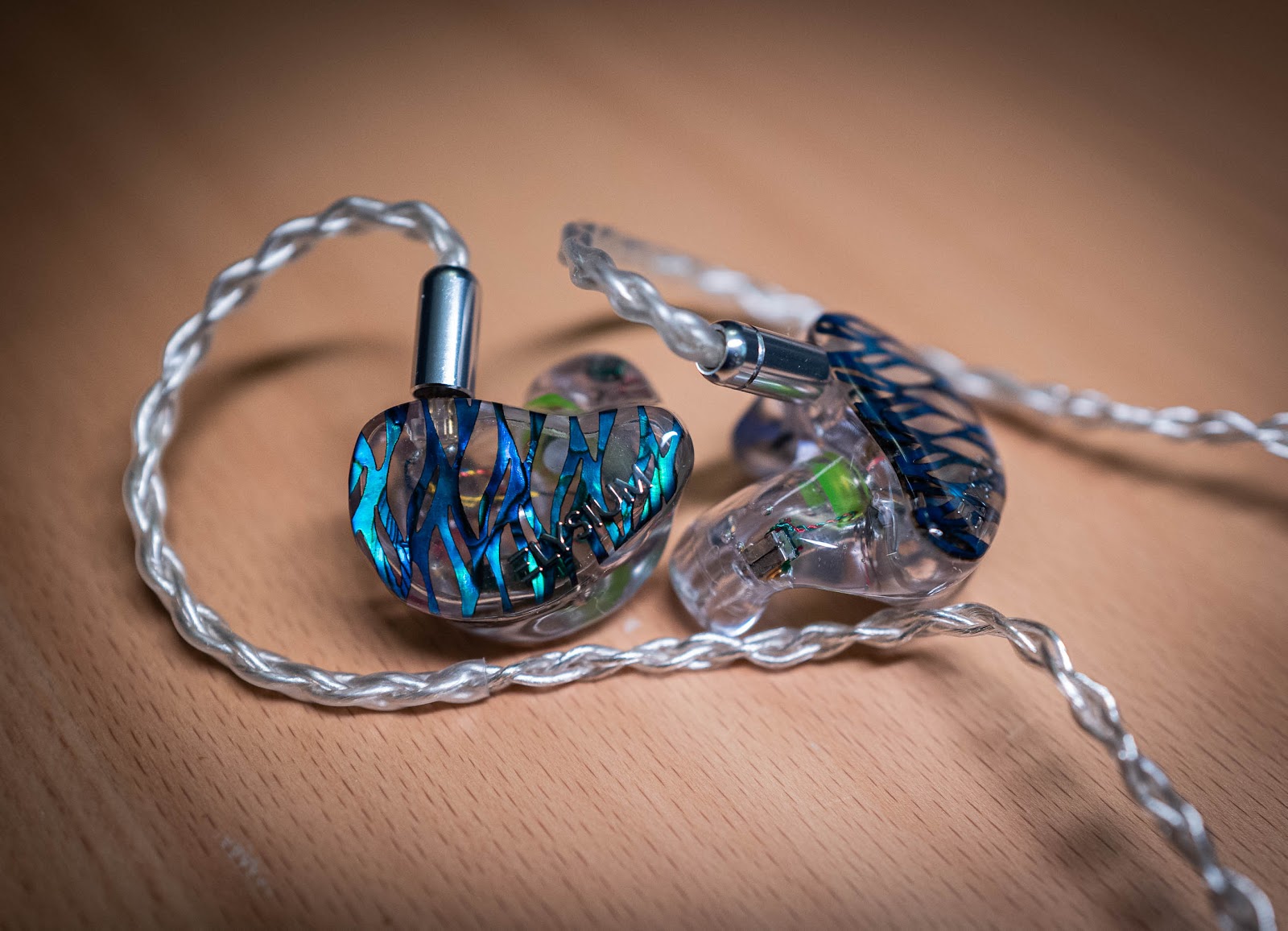
Packaging, Build Quality, and Ergonomics
It’s great to see companies paying attention to the fine details, and the packaging and overall unboxing experience with the Vision Ears Elysium is highly impressive. A large and beautifully designed outer box with a magnetic latch opens up to reveal an interior shelf which then elevates to reveal the Elysium in its carrying case one one side as well as accessories and paperwork on the other. The personalized nameplate is a nice touch and a reminder that this is a bespoke, luxury product. Very well done.
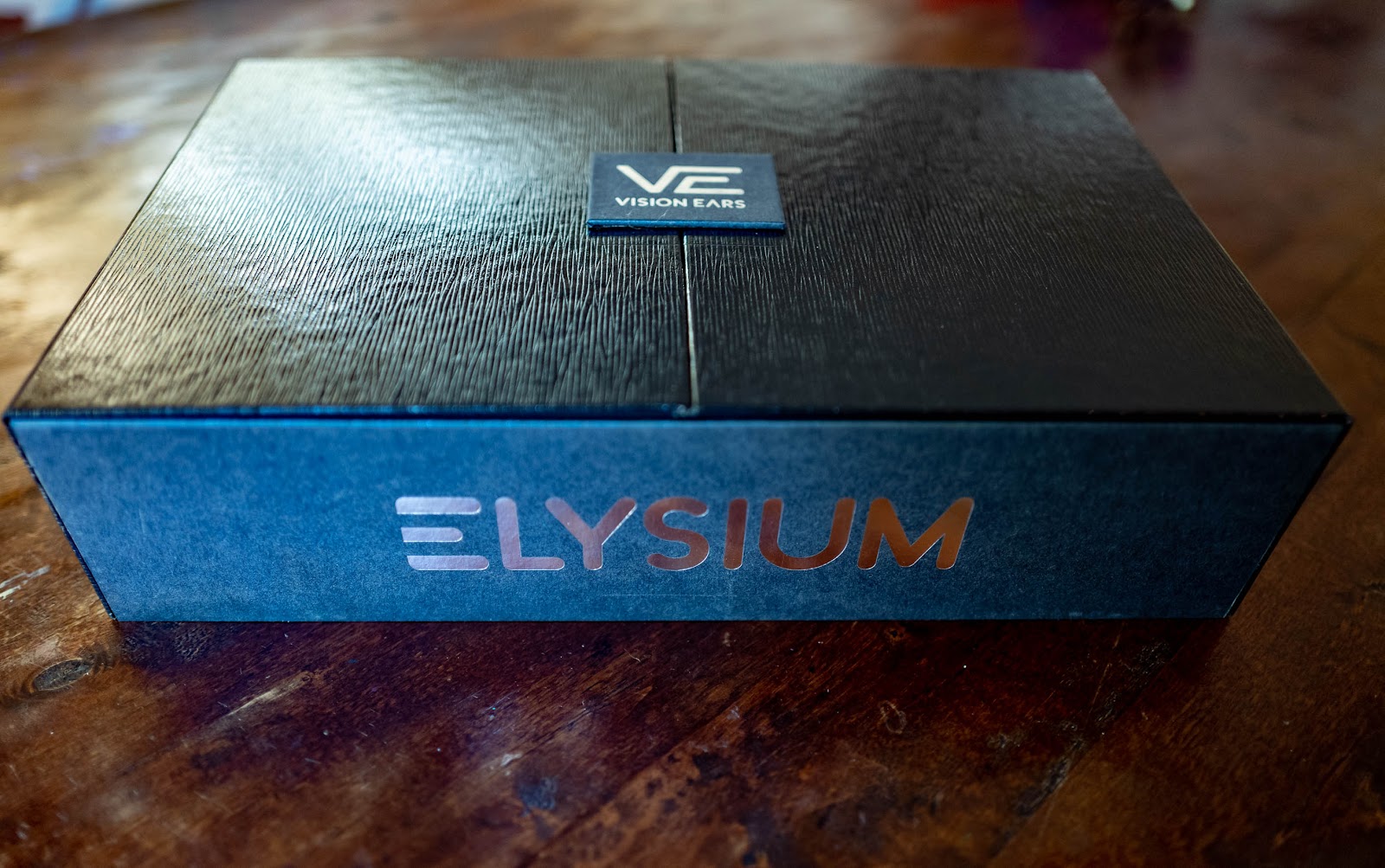
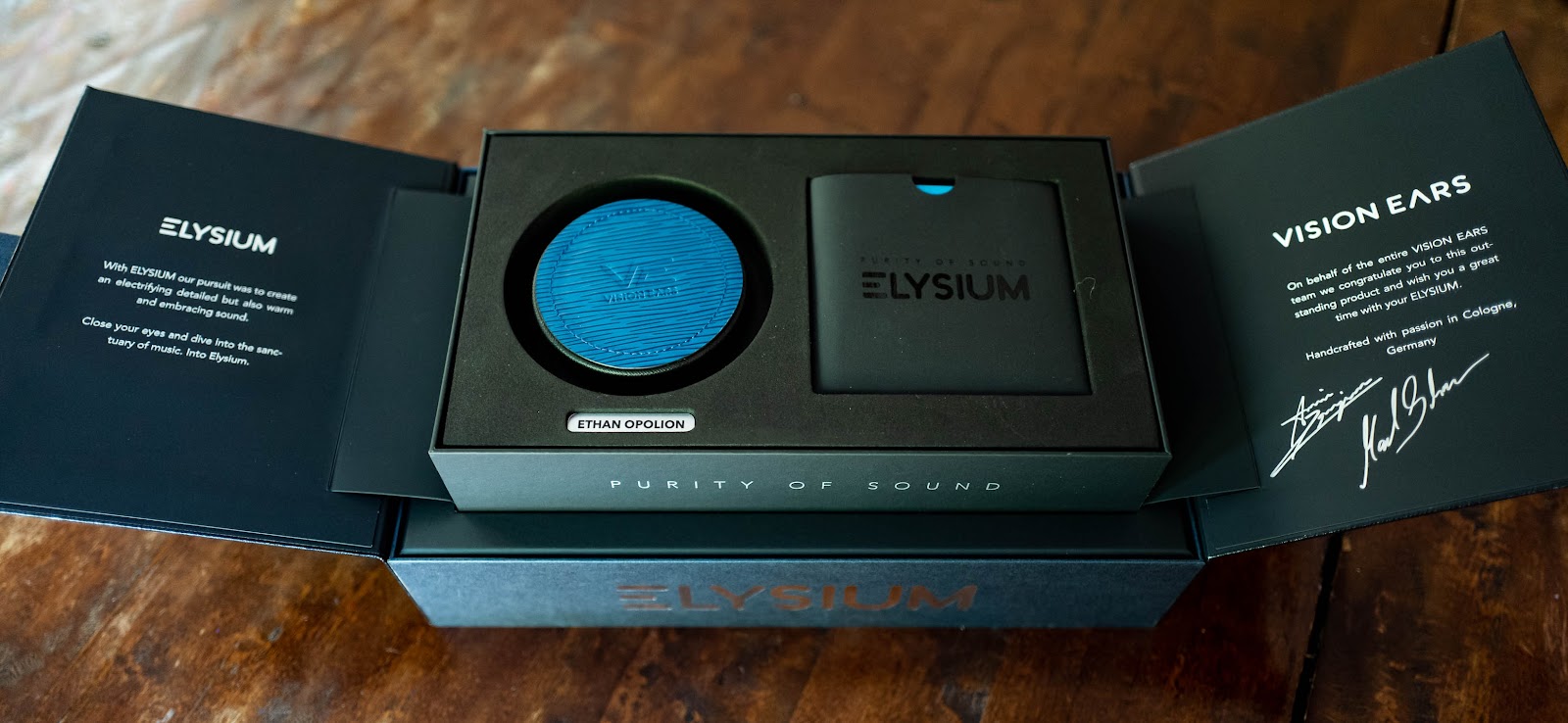
The package includes a ¼” inch adapter, cleaning brush, and Vision Ears branded cleaning fluid to help keep the surface areas of the Elysium looking their best. A beautiful two-tone leather puck case is included, with the top portion having a blue ripple effect. The case is flexible, with just the right amount of resistance in opening and closing, and is one of the best IEM cases I’ve ever used.
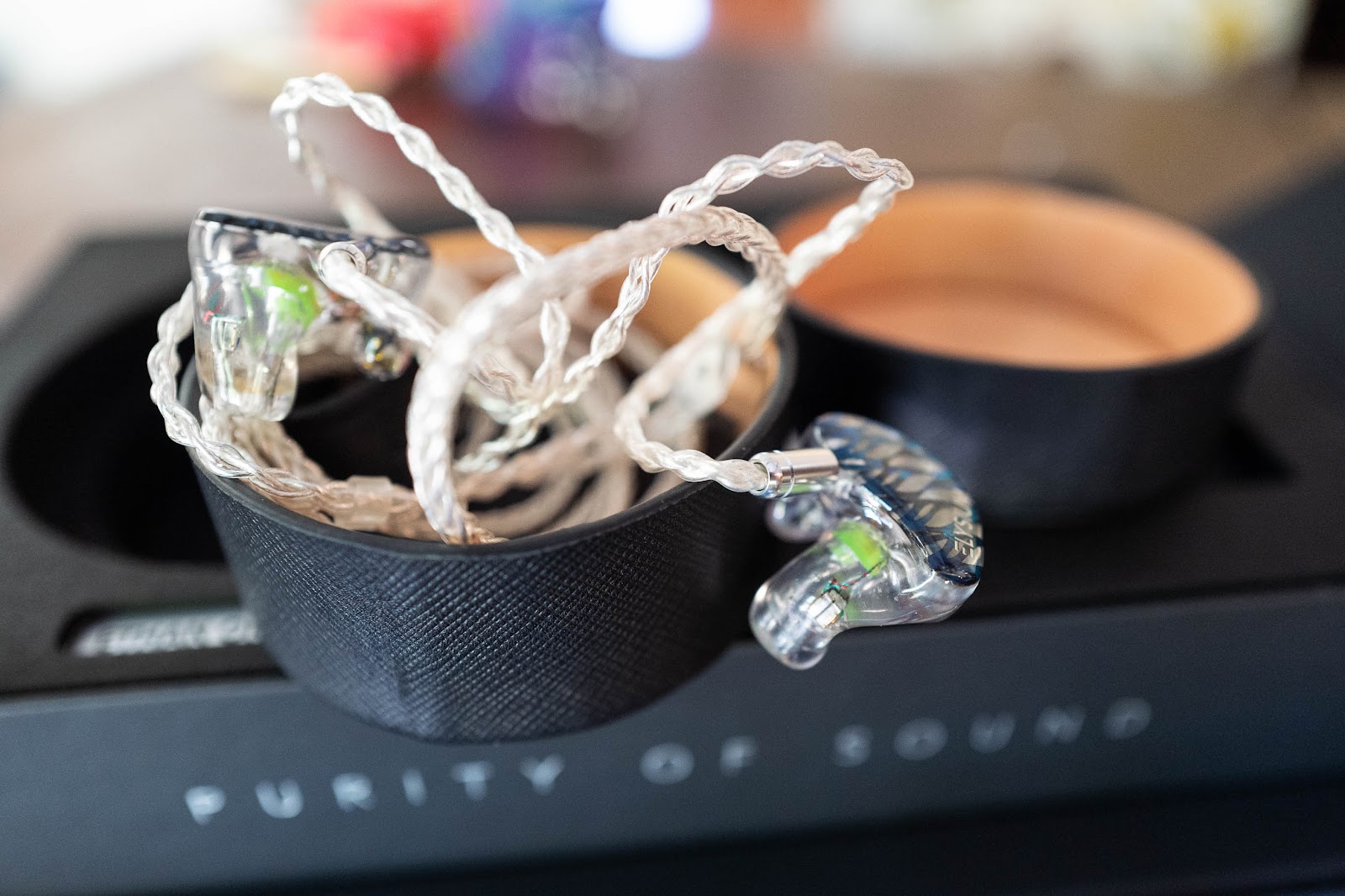
Aesthetically, the Elysium is a lovely piece, with the faceplate having swooping blue and green stripes over a transparent shell with the underside fully revealing the green-colored HALC (High Precision Acoustics Leveling Chamber) chamber, which is a proprietary design to Vision Ears, designed to tune the dynamic driver.
The Elysium is a four driver hybrid design, using a dual electrostatic tweeter for the highs, a single dynamic driver with HALC for mids, and a single balanced armature driver for the lows. This design eschews the more traditional hybrid setup of using dynamic drivers for lows and balanced armature drivers for mids. The supplied cable is a well built 8 wire SPC (silver plated copper) design. The cable is ergonomic, does not tangle, and comes with a nice VE embossed splitter.
Finally, the fit and finish of the Elysium is sublime. I had heard that Marcel was extremely gifted in the art of taking ear impressions and can only concur. The Elysium is the most comfortable and best fitting CIEM in my collection.
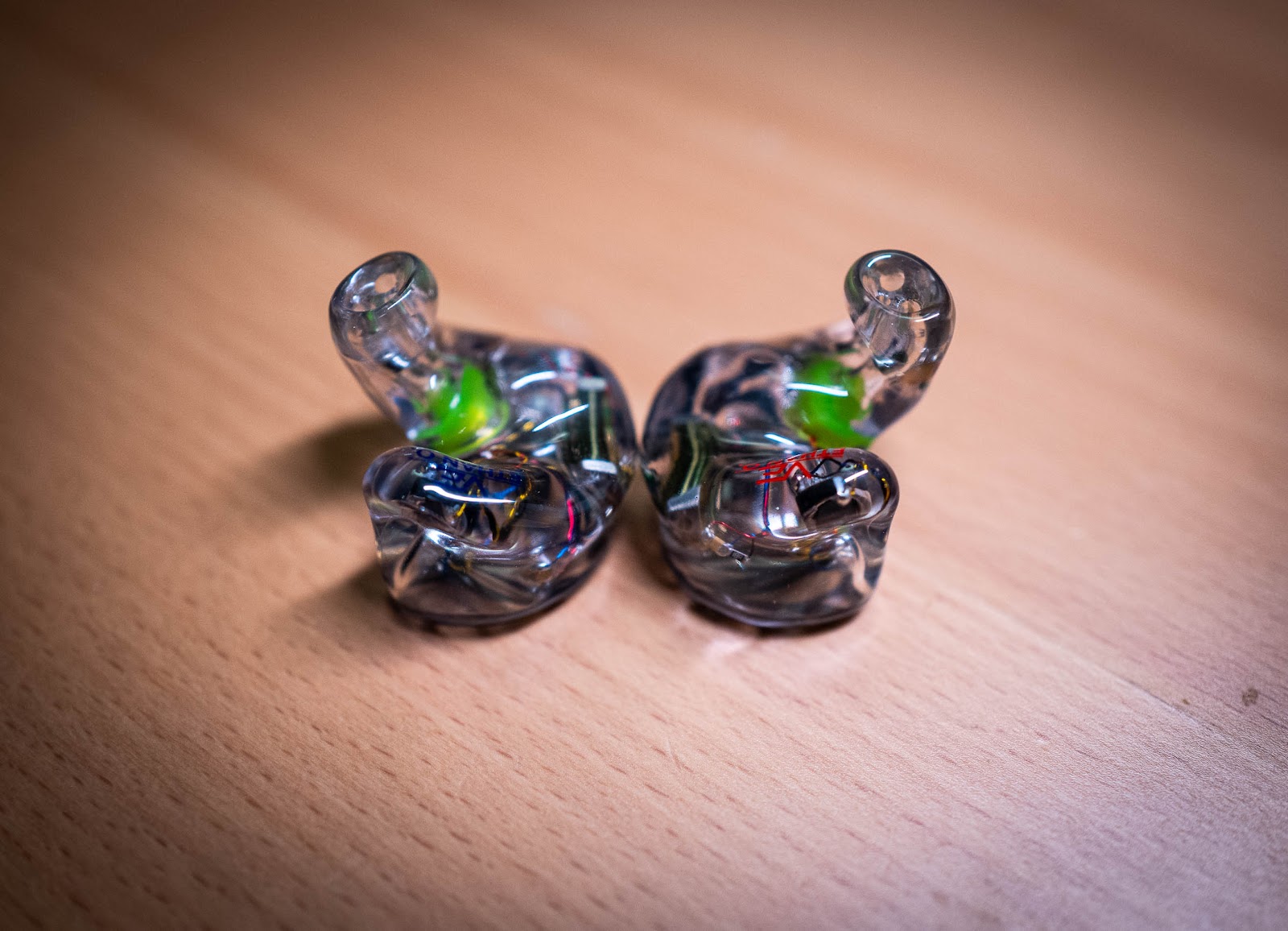
Sound Impressions
The Elysium is being used with the Astell&Kern SP1000 copper, Chord Hugo 2, and the Benchmark HPA4 desktop headphone amplifier, which allows it to scale to even greater heights. Some of the hybrid IEMs that I’ve previously heard have had their challenges with the integration of the electrostatic drivers, as these typically require a higher level of power. Not so with the Elysium.
The Elysium has a mid-centric sound signature with fantastic headroom and an open and airy soundstage. It’s a smooth, musical presentation but does not sound dark or overly warm. I would describe the sound signature as natural, with enough treble sparkle without being fatiguing, and a rich bass texture that provides an excellent level of harmonic balance. The highs are open, airy, and detailed in a non-fatiguing way. The timbre of vocals and instruments is just outstanding, among the finest I’ve heard in any IEM.
All of this results in an earphone that can be listened to for hours without fatigue and where musical enjoyment takes center stage. The Elysium has the ability to remove some of the sharp edges of less than perfect recordings but at the same time can truly shine with the best ones.
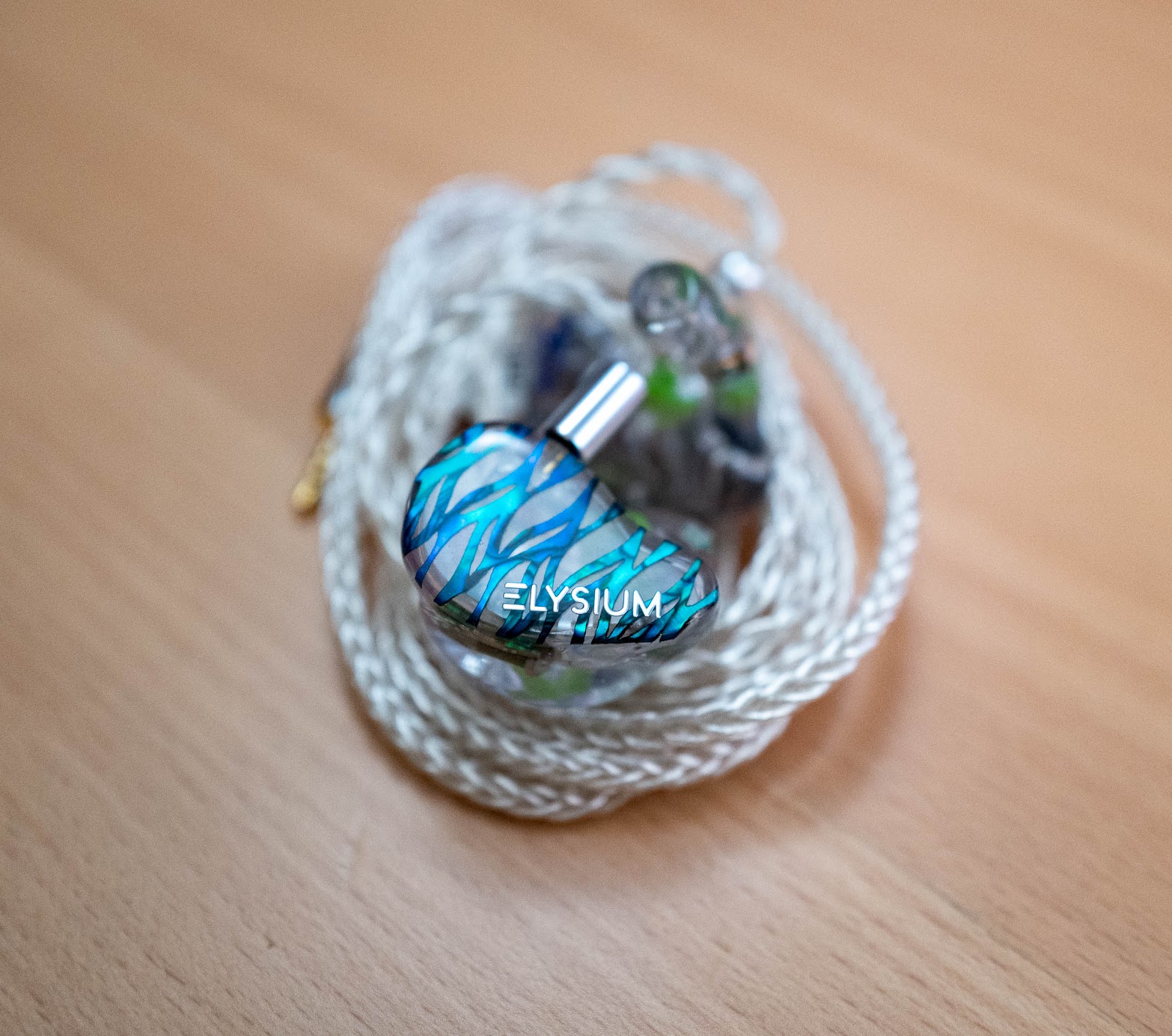
Sounds Impression Comparisons with other IEM/CIEM’s
Here is a brief comparison of the sonic differences between the Elysium and a few other IEM’s on hand.
AAW Canary (Universals)
The AAW Canary is another great hybrid IEM that was introduced at CanJam Singapore 2019. The Canary has a different driver configuration than the Elysium and uses two (2) dynamic drivers for lows, four (4) balanced armature drivers for mids and highs, and two (2) electrostatic super tweeters. The Canary has a slight V shaped sound signature with an even more extended and airier top end than the Elysium. Where the Elysium shines over the Canary is in the mids, and especially vocals. The Elysium sounds a little more natural and balanced to my ears although the Canary is no slouch and is another fantastic hybrid IEM with a different tuning and design philosophy that could be preferable to some listeners.
qdc Anole VX (Universals)
The Anole VX from Chinese manufacturer, qdc, has been one of the most talked about flagship IEM’s recently and is one of my personal references. It’s a 12 driver balanced armature design with a neutral sound signature that is just slightly warm, enabling a highly natural and engaging performance while retaining great musicality. The VX has a slightly shallower soundstage than the Elysium yet still is extremely layered and three-dimensional. The Elysium is the more relaxed and musical listen of the two, with the VS sounding more incisive with a flatter and more neutral frequency response.
64 Audio Tio Fourte (Universals)
The 64 Audio Tia Fourte has been one of the top flagship IEM’s over the past few years and was one of the first IEM’s that pushed boundaries in the market with their Tia driver technology. The Tia Fourte has a very wide soundstage, wider than the Elysium but less soundstage depth. Both IEMs have great dynamic range with the Elysium sounding fuller and more balanced than the Tia Fourte. The mids and vocals shine on the Elysium and sound more recessed on the Tia Fourte.
Conclusion
The Vision Ears Elysium is a fantastic hybrid driver technology earphone and one of the best headphone audio products released in 2019. The guys at Vision Ears have really found the sweet spot in their tuning of Elysium and the overall package of sound quality, ergonomics, and pride of ownership is outstanding.
It has an ideal blend of musicality and transparency, with a natural tonality and smoothness to the sound signature that just hits the sweet spot. It is also incredibly comfortable, enabling long and fatigue free listening sessions.
The Elysium is a must add to your shortlist if you are looking for a flagship custom IEM. Highly and enthusiastically recommended!
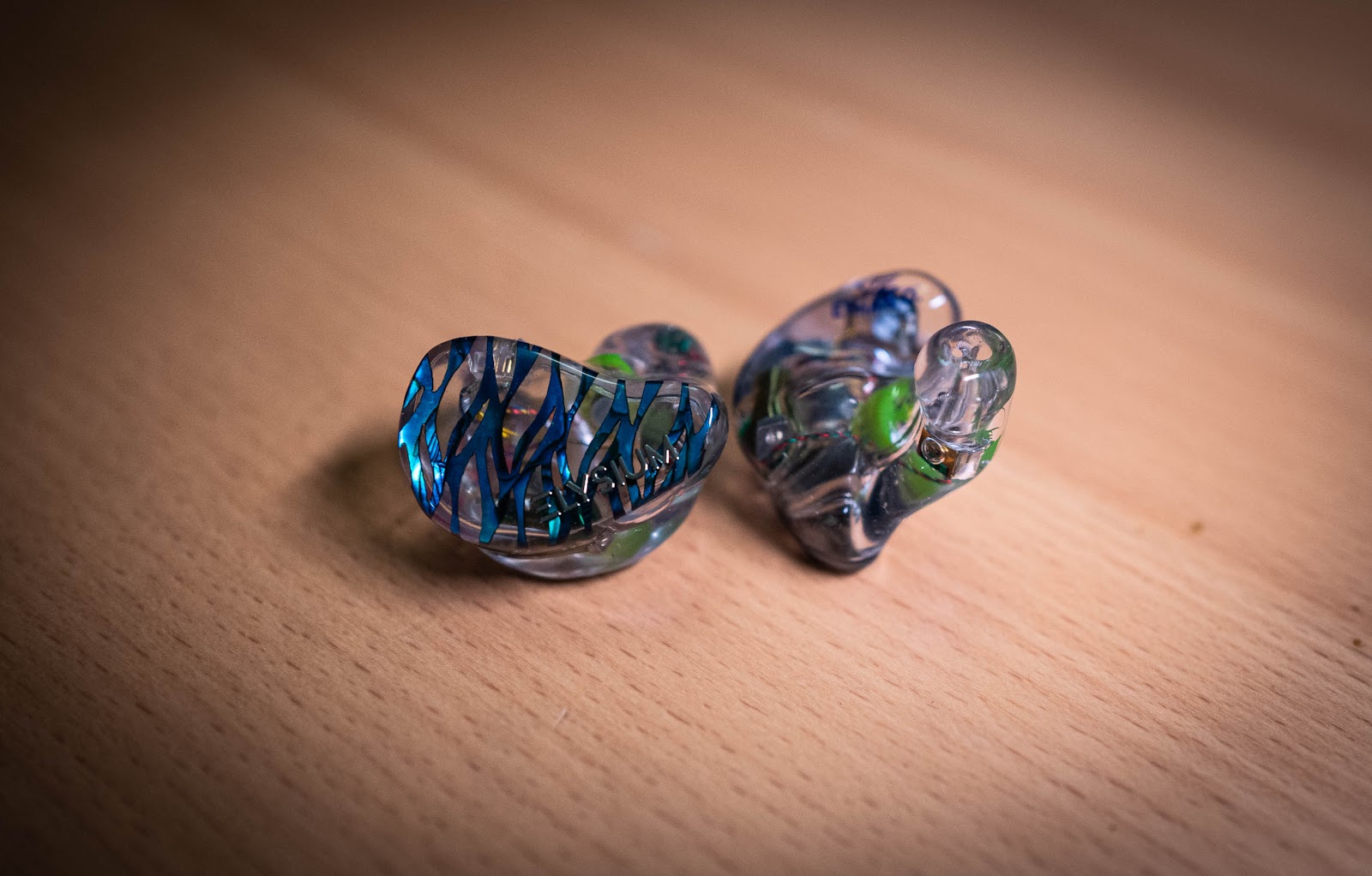
We’re now in a golden age of in-ear-monitor (IEM) design as new driver design technologies continue to enter the market. This, in turn, is resulting in a plethora of new products (and companies) entering this growing segment of the headphone audio industry. Among the recent innovations has been the release of off-the-shelf electrostatic in-ear drivers which has enabled IEM manufacturers to develop hybrid IEM products that use a combination of electrostatic, dynamic, and balanced armature drivers in their IEM’s, most commonly, electrostatic drivers for highs, and dynamic and balanced armature drivers for mids and lows.
Earlier this year at CanJam Singapore 2019, I got the chance to hear several of these new hybrid IEM offerings including the AAW Canary, FIR M5, Jomo Trinity, Noble Khan, and Vision Ear’s new Elysium. And although they all have some differences in tuning and design philosophy, it seems clear that another technological step forward for the hobby has been taken.
Vision Ears, an artisan company based in Cologne, Germany, has already made a big splash in the headphone audio industry over the past few years with the VE Series and more recently in 2018 with the ERLKönig, one of last years flagship IEM releases. The ERLKönig pushed boundaries with its silver shell, 13 drivers, and a four-way adjustable tuning switch on each earpiece. For 2019, Vision Ears launched their new €2900 flagship earphone, Elysium, at CanJam Singapore. Right before the show ended, I was able to finally get an audition, with Marcel, from Vision Ears, then taking my ear impressions. Fast forward a few months, and the custom Elysium arrived.
Packaging, Build Quality, and Ergonomics
It’s great to see companies paying attention to the fine details, and the packaging and overall unboxing experience with the Vision Ears Elysium is highly impressive. A large and beautifully designed outer box with a magnetic latch opens up to reveal an interior shelf which then elevates to reveal the Elysium in its carrying case one one side as well as accessories and paperwork on the other. The personalized nameplate is a nice touch and a reminder that this is a bespoke, luxury product. Very well done.
The package includes a ¼” inch adapter, cleaning brush, and Vision Ears branded cleaning fluid to help keep the surface areas of the Elysium looking their best. A beautiful two-tone leather puck case is included, with the top portion having a blue ripple effect. The case is flexible, with just the right amount of resistance in opening and closing, and is one of the best IEM cases I’ve ever used.
Aesthetically, the Elysium is a lovely piece, with the faceplate having swooping blue and green stripes over a transparent shell with the underside fully revealing the green-colored HALC (High Precision Acoustics Leveling Chamber) chamber, which is a proprietary design to Vision Ears, designed to tune the dynamic driver.
The Elysium is a four driver hybrid design, using a dual electrostatic tweeter for the highs, a single dynamic driver with HALC for mids, and a single balanced armature driver for the lows. This design eschews the more traditional hybrid setup of using dynamic drivers for lows and balanced armature drivers for mids. The supplied cable is a well built 8 wire SPC (silver plated copper) design. The cable is ergonomic, does not tangle, and comes with a nice VE embossed splitter.
Finally, the fit and finish of the Elysium is sublime. I had heard that Marcel was extremely gifted in the art of taking ear impressions and can only concur. The Elysium is the most comfortable and best fitting CIEM in my collection.
Sound Impressions
The Elysium is being used with the Astell&Kern SP1000 copper, Chord Hugo 2, and the Benchmark HPA4 desktop headphone amplifier, which allows it to scale to even greater heights. Some of the hybrid IEMs that I’ve previously heard have had their challenges with the integration of the electrostatic drivers, as these typically require a higher level of power. Not so with the Elysium.
The Elysium has a mid-centric sound signature with fantastic headroom and an open and airy soundstage. It’s a smooth, musical presentation but does not sound dark or overly warm. I would describe the sound signature as natural, with enough treble sparkle without being fatiguing, and a rich bass texture that provides an excellent level of harmonic balance. The highs are open, airy, and detailed in a non-fatiguing way. The timbre of vocals and instruments is just outstanding, among the finest I’ve heard in any IEM.
All of this results in an earphone that can be listened to for hours without fatigue and where musical enjoyment takes center stage. The Elysium has the ability to remove some of the sharp edges of less than perfect recordings but at the same time can truly shine with the best ones.
Sounds Impression Comparisons with other IEM/CIEM’s
Here is a brief comparison of the sonic differences between the Elysium and a few other IEM’s on hand.
AAW Canary (Universals)
The AAW Canary is another great hybrid IEM that was introduced at CanJam Singapore 2019. The Canary has a different driver configuration than the Elysium and uses two (2) dynamic drivers for lows, four (4) balanced armature drivers for mids and highs, and two (2) electrostatic super tweeters. The Canary has a slight V shaped sound signature with an even more extended and airier top end than the Elysium. Where the Elysium shines over the Canary is in the mids, and especially vocals. The Elysium sounds a little more natural and balanced to my ears although the Canary is no slouch and is another fantastic hybrid IEM with a different tuning and design philosophy that could be preferable to some listeners.
qdc Anole VX (Universals)
The Anole VX from Chinese manufacturer, qdc, has been one of the most talked about flagship IEM’s recently and is one of my personal references. It’s a 12 driver balanced armature design with a neutral sound signature that is just slightly warm, enabling a highly natural and engaging performance while retaining great musicality. The VX has a slightly shallower soundstage than the Elysium yet still is extremely layered and three-dimensional. The Elysium is the more relaxed and musical listen of the two, with the VS sounding more incisive with a flatter and more neutral frequency response.
64 Audio Tio Fourte (Universals)
The 64 Audio Tia Fourte has been one of the top flagship IEM’s over the past few years and was one of the first IEM’s that pushed boundaries in the market with their Tia driver technology. The Tia Fourte has a very wide soundstage, wider than the Elysium but less soundstage depth. Both IEMs have great dynamic range with the Elysium sounding fuller and more balanced than the Tia Fourte. The mids and vocals shine on the Elysium and sound more recessed on the Tia Fourte.
Conclusion
The Vision Ears Elysium is a fantastic hybrid driver technology earphone and one of the best headphone audio products released in 2019. The guys at Vision Ears have really found the sweet spot in their tuning of Elysium and the overall package of sound quality, ergonomics, and pride of ownership is outstanding.
It has an ideal blend of musicality and transparency, with a natural tonality and smoothness to the sound signature that just hits the sweet spot. It is also incredibly comfortable, enabling long and fatigue free listening sessions.
The Elysium is a must add to your shortlist if you are looking for a flagship custom IEM. Highly and enthusiastically recommended!
Frankie D
Third Eye, how does the bass of the Elysium compare to the bass of the Anole VX in your opinion? Please let us know all of your thoughts in this area. Tks.
Introduction
What is the best headphone amplifier for the hard-to-drive Hifiman Susvara? For those not familiar, the Susvara and its Hifiman predecessor, the HE-6, are notoriously hard-to-drive planar magnetic headphones with some enthusiasts going down the path of using dedicated speaker amplifiers to drive them. Prior to this review, I had been using the DNA Stratus 2A3 headphone amplifier as my primary amp for the Susvara as well as my other headphones. With it’s 1.8 watts per channel, the Stratus does a great job with all of my headphones but when it came to the Susvara, I was not convinced that their full potential was being met in terms of dynamic range and musical weight as my normal listening level would usually be near the edge of the amp’s volume pot. To put this into context, we’re talking about unlocking the last elusive sliver of performance potential.
Auris Audio, a company founded in 2013 and based in Serbia, began exhibiting at CanJam shows a few years ago. Auris specializes in dedicated vacuum tube amplifiers for headphones as well as other electronics and speakers for 2 channel use. The HA-2SE was Auris Audio’s first foray into the headphone audio market with the Nirvana, Headonia, and the recently released Euterpe rounding out the product line for headphones amps. All of the products share a distinct design aesthetic and combine gorgeous woodwork with natural leather that look more like pieces of luxury art than electronic components.

I’ve always been impressed with the sound quality of Auris’s offerings during my brief listening sessions at the various CanJam’s around the world, but it wasn’t until my visit to the Axpona show in Chicago earlier this year, that I was able to spend a little more time with the amplifiers, and specifically, the Headonia driving the Hifiman Susvara.
Miki Trosic, CEO of Auris Audio, explained to me that the Headonia 2A3 amp was designed from the ground up specifically with the Susvara in mind and then proceeded to plug in two Susvara’s simultaneously to prove the point. Needless to say, it was a very impressive demo and several weeks later I received the Headonia for a full review.

Unboxing, Setup, and Build Quality
The Headonia arrived double boxed and well packaged. Opening the box reveals the amplifier, a set of 4 spikes, paperwork, a milled aluminum remote control, and a pair of Auris branded gloves, which is a nice touch. The stock tubes that ship with the amp are a set of Electro Harmonix Gold 2A3s along with a set of generic ECC81 tubes.
The Headonia is a large and imposing piece weighing in at 53 lbs with dimensions of 17.7” x 15.7” x 10.6” (inches) and is available in two color options, black or white. This amplifier features flawless and beautiful woodwork, with both the top and bottom solid wood plates sandwiching the leather wrapped chassis. Even upon close inspection, all of the seams are perfect and the overall build quality is extremely impressive and shows a high level of detail and execution. It is a luxury piece in every sense of the word.
Looking at the back of the Headonia, we have 4 sets of analog inputs. There are no balanced inputs on the Headonia as this is a single ended amplifier. Next to analog inputs there are tube balancing pots for the right and left channels, and the AC power connector.

Moving to the front of the unit, the amplifier has 2 headphone outputs, one single ended, and the other with a 4 pin balanced connector. On the top of the unit, there is an input selector knob labeled L1 through L4 for the analog inputs and two impedance selector knobs for each of the headphone outputs. This enables the user to dial in the appropriate impedance setting for the headphone being used and has 32/80/150/300/600 Ohm settings. Which in turn, makes the Headonia ideal for driving various types of headphones, along with the ability to do so simultaneously. Behind the the top selector knobs, there is a small protective gate which protects access to the four tube sockets.
Finally, front and center is the volume control knob which is nice to operate manually along with the ability to control the volume using a supplied remote control. The remote feels premium in the hand as its made from solid aluminum and can control the volume as well as providing a mute function.

On the bottom of the Headonia, there are spikes to keep the unit elevated as well as a pair of air vents for cooling. There is also a blue LED status indicator to show when the unit is switched on and in operation. I found this unobtrusive and elegant looking but it’s worth noting that this cannot be switched off. During my time using the Headonia, the unit remains cool to the touch with the only heat emanating from the tubes themselves during operation. I’ve also left the unit running all day long with the same result.
The overall build quality of the Headonia is very impressive. Operating the various selector knobs and even plugging headphones into the unit’s outputs exudes a level of confidence and satisfaction that is usually only experienced with select high end components.
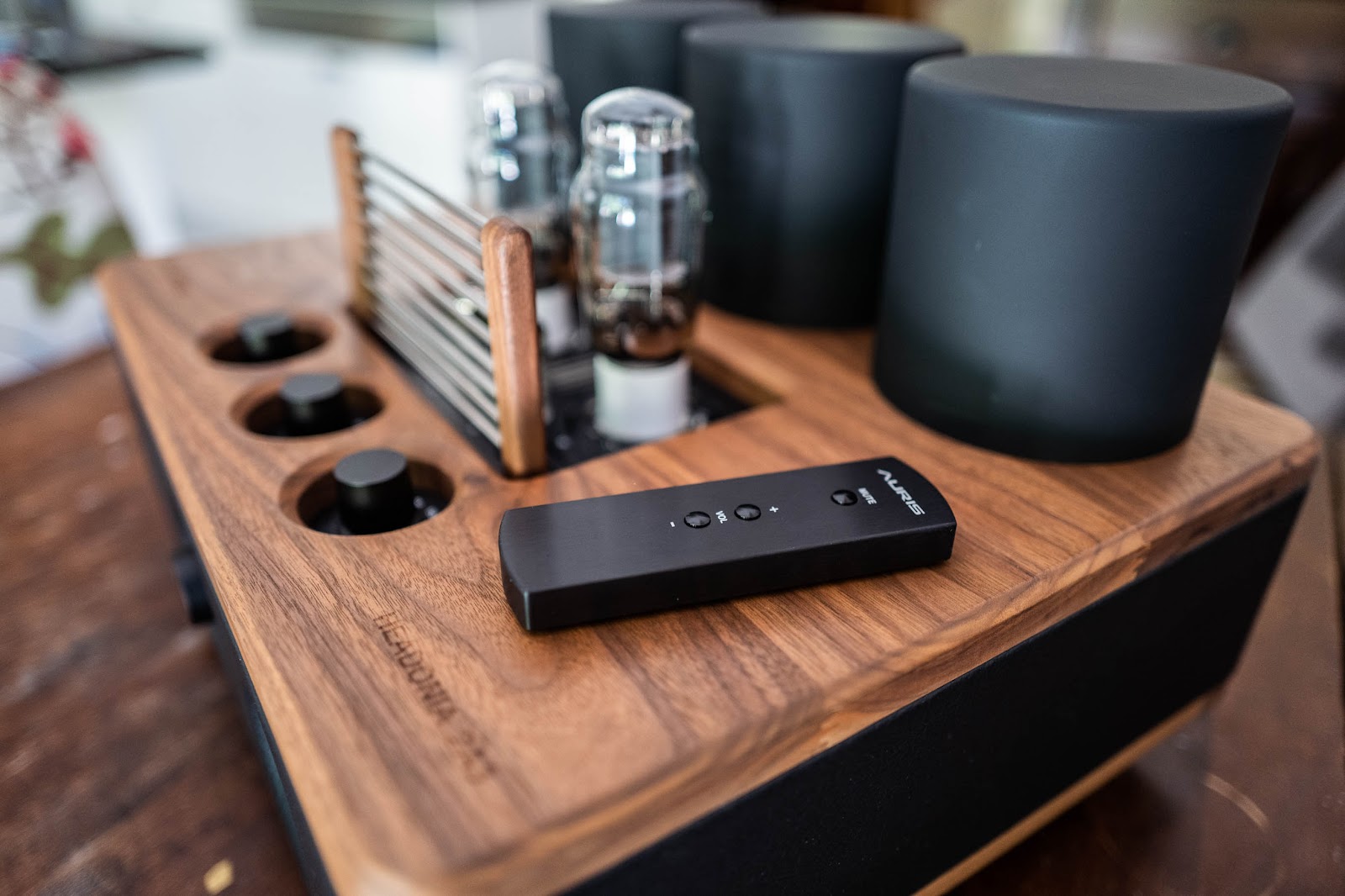
Sound Impressions
The primary system used to evaluate the Headonia was the Innuos Zenith MKIII music server, along with the Benchmark DAC3 B, and Hifiman Susvara headphones using the Kimer Axios Hb cable terminated in 4 pin XLR. Amps used as comparisons were the Benchmark HPA 4 and DNA Stratus as Headphone amps. Other headphones used were the Hifiman HE6, Abyss Diana Phi and MrSpeakers Ether 2. With regards to the tubes used in the Headonia, I found the stock tubes to be very good, only changing out the 2A3’s to a set of Sophia Electric 2A3s that I had on hand. The Sophia’s traded off a very slight decrease in overall impact for a larger increase in overall transparency and resolution.
The sound from the Headonia/Susvara is immensely powerful yet fully controlled, highly transparent and detailed while simultaneously being as smooth as velvet. The level of dynamic range is quite astonishing and I found myself fully immersed in hearing things in some of my favorite music that I had not heard before. The soundstage is huge in both width and depth and is a completely immersive experience.
The amplifier has a linear, neutral sound signature with some slight tube warmth but never crosses into the traditional “tubey” type of sound signature. The dynamic range and overall control of the amplifier is fantastic with lower volume passages coming through as pristinely as the more powerful ones. This is a goldilocks type of sound that is organic, natural, and incredibly immersive. And it does this with a wide variety of headphones, letting each headphone’s unique sound characteristics shine through.
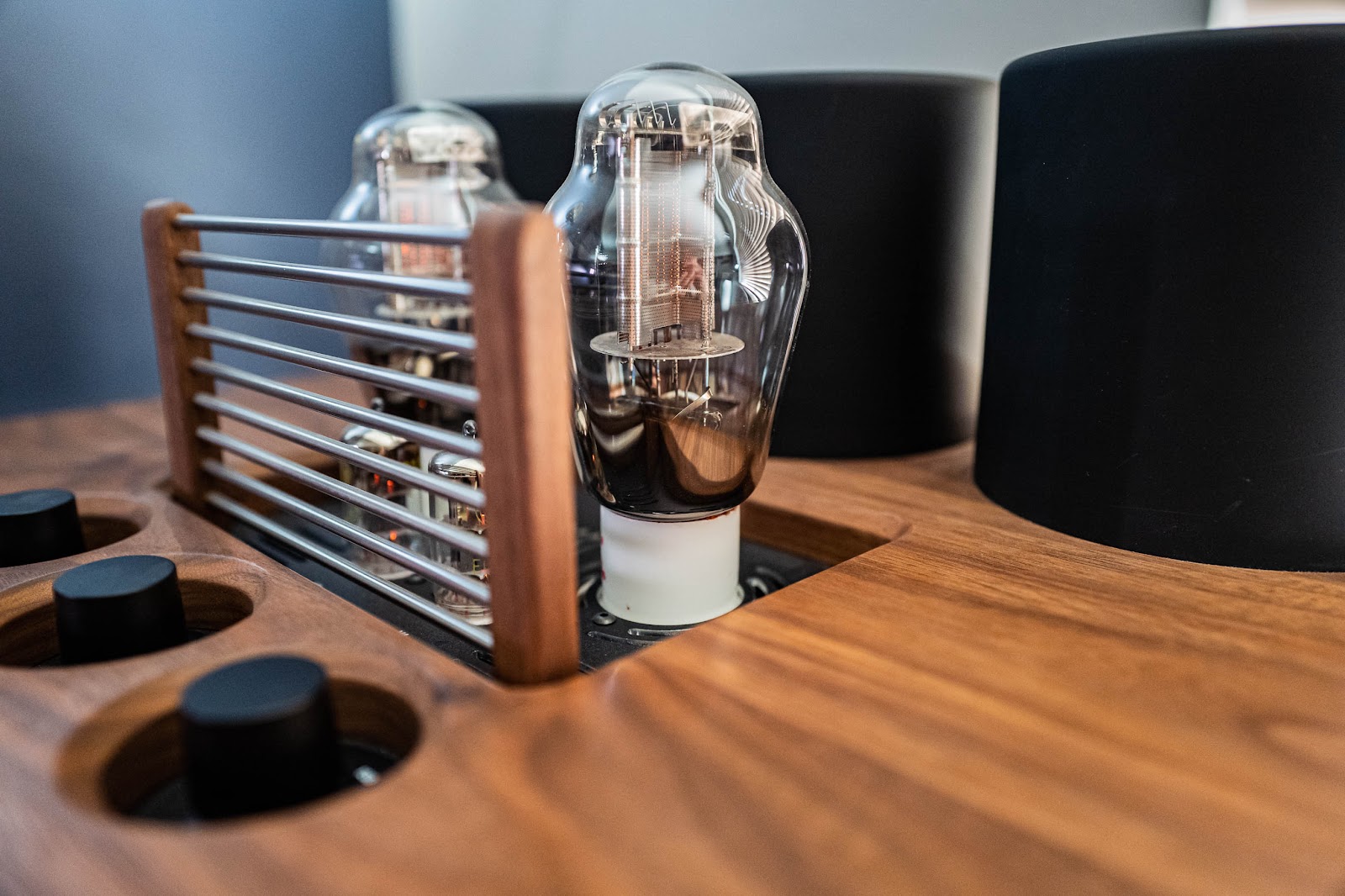
Comparisons
Benchmark Media Systems HPA4
The Benchmark HPA4 is a reference solid state amplifier featuring THX’s Achromatic Audio Amplifier (AAA) technology. In conjunction with Benchmark’s DAC3 B the HPA4 produces a highly transparent and uncolored sound which sounds incredible with a wide variety of headphones and earphones, especially with higher quality source material.
In this comparison, the Headonia has a slightly larger soundstage and overall sounds fuller in the lower registers with more weight to strings and vocals. On the flipside, the HPA4 sounds slightly more transparent at perhaps a slight expense of musicality.
DNA Stratus
With the Headonia having 3 watts per channel on tap, I expected a higher level of performance using the Susvara than the 1.8 watt per channel DNA Stratus 2A3 amp and I was not surprised to hear additional headroom with the Headonia. With the Stratus, my volume range was 7-10 (out of 10) and with the Headonia it’s 4-7 (out of 10). What did surprise me was that the Headonia retains much of what I love about the Stratus in terms of its resolution and finesse and builds upon it with a more solid foundation. The Headonia is the bigger sounding amp here when using the Susvara.

Conclusion
The Headonia is among the best pieces of headphone audio gear that I’ve heard at any price and is a true end-of-the-line flagship tube amplifier. It absolutely shined with every headphone that I could throw at it without breaking a sweat and could even do so driving two headphones at the same time. To my ears, it’s an optimal match with the Susvara driving it with powerful authority and finesse. Tubes impart their own sense of magic and I can strongly recommend auditioning the Headonia for those looking for a flagship headphone amplifier to drive all of their non-electrostatic headphones, and specifically, Hifiman Susvara owners looking for an endgame amp.

What is the best headphone amplifier for the hard-to-drive Hifiman Susvara? For those not familiar, the Susvara and its Hifiman predecessor, the HE-6, are notoriously hard-to-drive planar magnetic headphones with some enthusiasts going down the path of using dedicated speaker amplifiers to drive them. Prior to this review, I had been using the DNA Stratus 2A3 headphone amplifier as my primary amp for the Susvara as well as my other headphones. With it’s 1.8 watts per channel, the Stratus does a great job with all of my headphones but when it came to the Susvara, I was not convinced that their full potential was being met in terms of dynamic range and musical weight as my normal listening level would usually be near the edge of the amp’s volume pot. To put this into context, we’re talking about unlocking the last elusive sliver of performance potential.
Auris Audio, a company founded in 2013 and based in Serbia, began exhibiting at CanJam shows a few years ago. Auris specializes in dedicated vacuum tube amplifiers for headphones as well as other electronics and speakers for 2 channel use. The HA-2SE was Auris Audio’s first foray into the headphone audio market with the Nirvana, Headonia, and the recently released Euterpe rounding out the product line for headphones amps. All of the products share a distinct design aesthetic and combine gorgeous woodwork with natural leather that look more like pieces of luxury art than electronic components.
I’ve always been impressed with the sound quality of Auris’s offerings during my brief listening sessions at the various CanJam’s around the world, but it wasn’t until my visit to the Axpona show in Chicago earlier this year, that I was able to spend a little more time with the amplifiers, and specifically, the Headonia driving the Hifiman Susvara.
Miki Trosic, CEO of Auris Audio, explained to me that the Headonia 2A3 amp was designed from the ground up specifically with the Susvara in mind and then proceeded to plug in two Susvara’s simultaneously to prove the point. Needless to say, it was a very impressive demo and several weeks later I received the Headonia for a full review.
Unboxing, Setup, and Build Quality
The Headonia arrived double boxed and well packaged. Opening the box reveals the amplifier, a set of 4 spikes, paperwork, a milled aluminum remote control, and a pair of Auris branded gloves, which is a nice touch. The stock tubes that ship with the amp are a set of Electro Harmonix Gold 2A3s along with a set of generic ECC81 tubes.
The Headonia is a large and imposing piece weighing in at 53 lbs with dimensions of 17.7” x 15.7” x 10.6” (inches) and is available in two color options, black or white. This amplifier features flawless and beautiful woodwork, with both the top and bottom solid wood plates sandwiching the leather wrapped chassis. Even upon close inspection, all of the seams are perfect and the overall build quality is extremely impressive and shows a high level of detail and execution. It is a luxury piece in every sense of the word.
Looking at the back of the Headonia, we have 4 sets of analog inputs. There are no balanced inputs on the Headonia as this is a single ended amplifier. Next to analog inputs there are tube balancing pots for the right and left channels, and the AC power connector.
Moving to the front of the unit, the amplifier has 2 headphone outputs, one single ended, and the other with a 4 pin balanced connector. On the top of the unit, there is an input selector knob labeled L1 through L4 for the analog inputs and two impedance selector knobs for each of the headphone outputs. This enables the user to dial in the appropriate impedance setting for the headphone being used and has 32/80/150/300/600 Ohm settings. Which in turn, makes the Headonia ideal for driving various types of headphones, along with the ability to do so simultaneously. Behind the the top selector knobs, there is a small protective gate which protects access to the four tube sockets.
Finally, front and center is the volume control knob which is nice to operate manually along with the ability to control the volume using a supplied remote control. The remote feels premium in the hand as its made from solid aluminum and can control the volume as well as providing a mute function.
On the bottom of the Headonia, there are spikes to keep the unit elevated as well as a pair of air vents for cooling. There is also a blue LED status indicator to show when the unit is switched on and in operation. I found this unobtrusive and elegant looking but it’s worth noting that this cannot be switched off. During my time using the Headonia, the unit remains cool to the touch with the only heat emanating from the tubes themselves during operation. I’ve also left the unit running all day long with the same result.
The overall build quality of the Headonia is very impressive. Operating the various selector knobs and even plugging headphones into the unit’s outputs exudes a level of confidence and satisfaction that is usually only experienced with select high end components.
Sound Impressions
The primary system used to evaluate the Headonia was the Innuos Zenith MKIII music server, along with the Benchmark DAC3 B, and Hifiman Susvara headphones using the Kimer Axios Hb cable terminated in 4 pin XLR. Amps used as comparisons were the Benchmark HPA 4 and DNA Stratus as Headphone amps. Other headphones used were the Hifiman HE6, Abyss Diana Phi and MrSpeakers Ether 2. With regards to the tubes used in the Headonia, I found the stock tubes to be very good, only changing out the 2A3’s to a set of Sophia Electric 2A3s that I had on hand. The Sophia’s traded off a very slight decrease in overall impact for a larger increase in overall transparency and resolution.
The sound from the Headonia/Susvara is immensely powerful yet fully controlled, highly transparent and detailed while simultaneously being as smooth as velvet. The level of dynamic range is quite astonishing and I found myself fully immersed in hearing things in some of my favorite music that I had not heard before. The soundstage is huge in both width and depth and is a completely immersive experience.
The amplifier has a linear, neutral sound signature with some slight tube warmth but never crosses into the traditional “tubey” type of sound signature. The dynamic range and overall control of the amplifier is fantastic with lower volume passages coming through as pristinely as the more powerful ones. This is a goldilocks type of sound that is organic, natural, and incredibly immersive. And it does this with a wide variety of headphones, letting each headphone’s unique sound characteristics shine through.
Comparisons
Benchmark Media Systems HPA4
The Benchmark HPA4 is a reference solid state amplifier featuring THX’s Achromatic Audio Amplifier (AAA) technology. In conjunction with Benchmark’s DAC3 B the HPA4 produces a highly transparent and uncolored sound which sounds incredible with a wide variety of headphones and earphones, especially with higher quality source material.
In this comparison, the Headonia has a slightly larger soundstage and overall sounds fuller in the lower registers with more weight to strings and vocals. On the flipside, the HPA4 sounds slightly more transparent at perhaps a slight expense of musicality.
DNA Stratus
With the Headonia having 3 watts per channel on tap, I expected a higher level of performance using the Susvara than the 1.8 watt per channel DNA Stratus 2A3 amp and I was not surprised to hear additional headroom with the Headonia. With the Stratus, my volume range was 7-10 (out of 10) and with the Headonia it’s 4-7 (out of 10). What did surprise me was that the Headonia retains much of what I love about the Stratus in terms of its resolution and finesse and builds upon it with a more solid foundation. The Headonia is the bigger sounding amp here when using the Susvara.
Conclusion
The Headonia is among the best pieces of headphone audio gear that I’ve heard at any price and is a true end-of-the-line flagship tube amplifier. It absolutely shined with every headphone that I could throw at it without breaking a sweat and could even do so driving two headphones at the same time. To my ears, it’s an optimal match with the Susvara driving it with powerful authority and finesse. Tubes impart their own sense of magic and I can strongly recommend auditioning the Headonia for those looking for a flagship headphone amplifier to drive all of their non-electrostatic headphones, and specifically, Hifiman Susvara owners looking for an endgame amp.
Introduction
A friend once told me the old audiophile adage “everything matters”. For Head-Fiers, a common topic of conversation has traditionally revolved around the level of importance attributed to individual pieces making up the audio chain. This usually translates to how to best to divide the pie between the headphones, headphone amplifier, DAC, with source and cables also factoring in to the equation.
As audiophiles transitioned from albums to CD’s and and increasingly over the past few years to music files and streaming, a common goal amongst audio enthusiasts remains the pursuit of the most faithful reproduction of the recording in order to get as close to the music as possible. Many today are using streaming services such as Tidal and Qobuz, and/or are using their lossless music files stored on an external hard drive. To this end, companies are developing dedicated music server and streaming products that attempt to solve the most common problem of computer based music systems, that of noisy USB connections, jitter, and other electrical noise.
The objective of music servers is to reduce the noise floor as much as possible and to provide a clear improvement over a direct USB connection to a computer. Or even better, to remove the computer and external hard drive altogether and have a dedicated device that provides a complete digital transport solution.
As people increasingly interact with their phones and tablets, forward thinking companies are developing products that users can interface with regardless of device being used. One of the biggest highlights at CanJam NYC 2019 was a company from Portugal called Innuos. Over the past couple of years, Innuos has been making waves with their Music Servers that come in 3 basic levels, ZENMINI, ZEN, and ZENITH as well as their flagship product, the Statement. This review is focused on the Zenith MK3, although the setup, user interface, and CD drive operation is the same across all of the Innuos product lines.
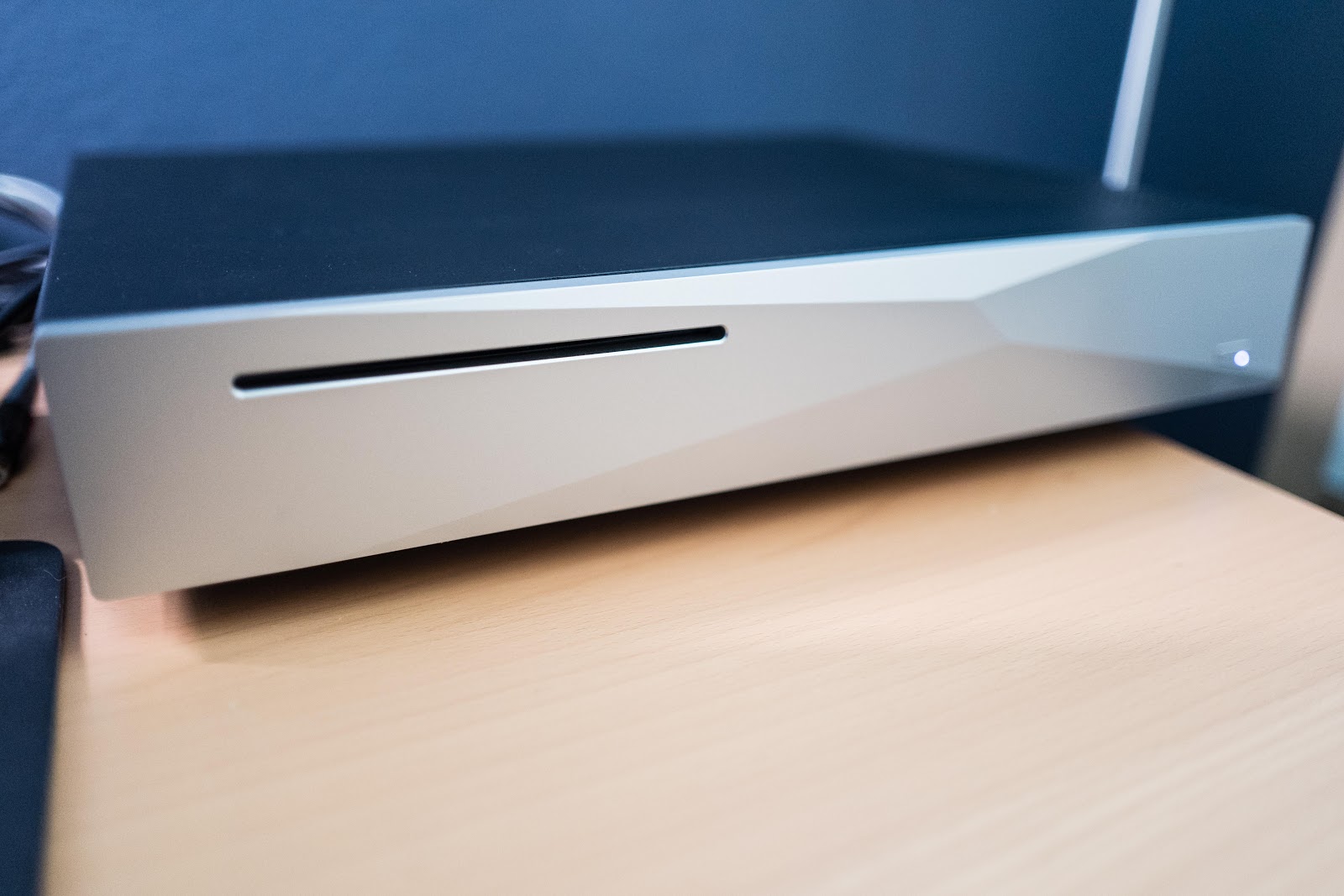
The Innuos Zenith MK3 is a high end music server (MSRP: $4249) that enables the complete management of a music library that is stored on internal SSD storage as well as the streaming of popular audiophile music services like Tidal and Qobuz. In other words, this is a dedicated computer for your music library that has a quad-core CPU, 8GB or RAM, a size configurable internal SSD drive to store music, a CD drive to rip CD’s into the SSD drive, and also streams music service such as Tidal or Qobuz. The Zenith MK3 is then operated on your computer (via Roon or Windows compatible app), or tablet/mobile device with approved apps for iOs (iPeng) or Android (Orange Squeeze).
Setup
Opening the box reveals a full rack size component measuring 16.5” wide, 12.5” deep, 2.75” tall and weighing in at a hefty 20 lbs. The unit has a sturdy, high quality build with a sculpted, silver faceplate that has a CD drive slot on the top left side and a single power button on the bottom right. The power button also incorporates a single LED status indicator which can also be configured to display different LED colors to suit user preferences, a small but nice touch.
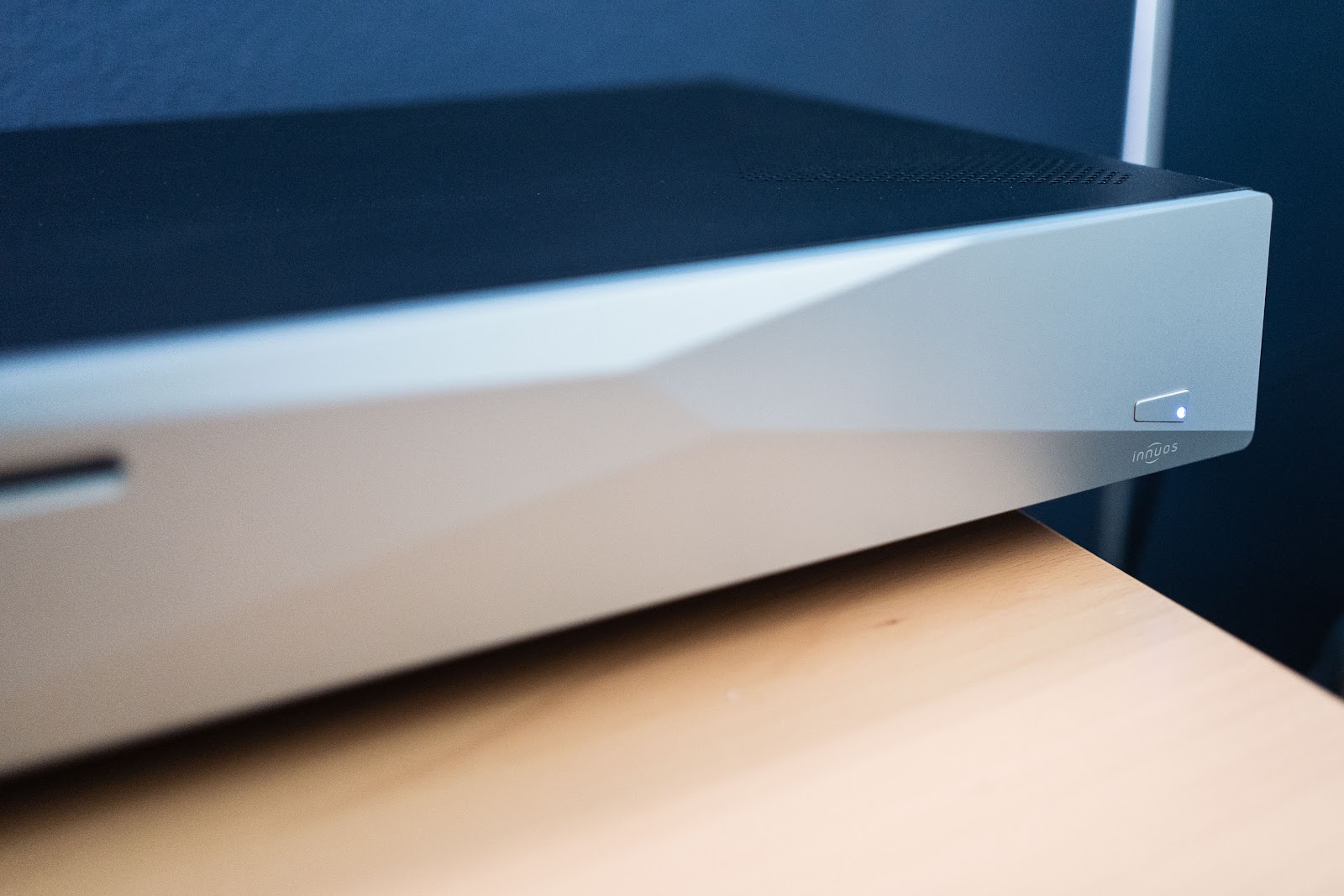
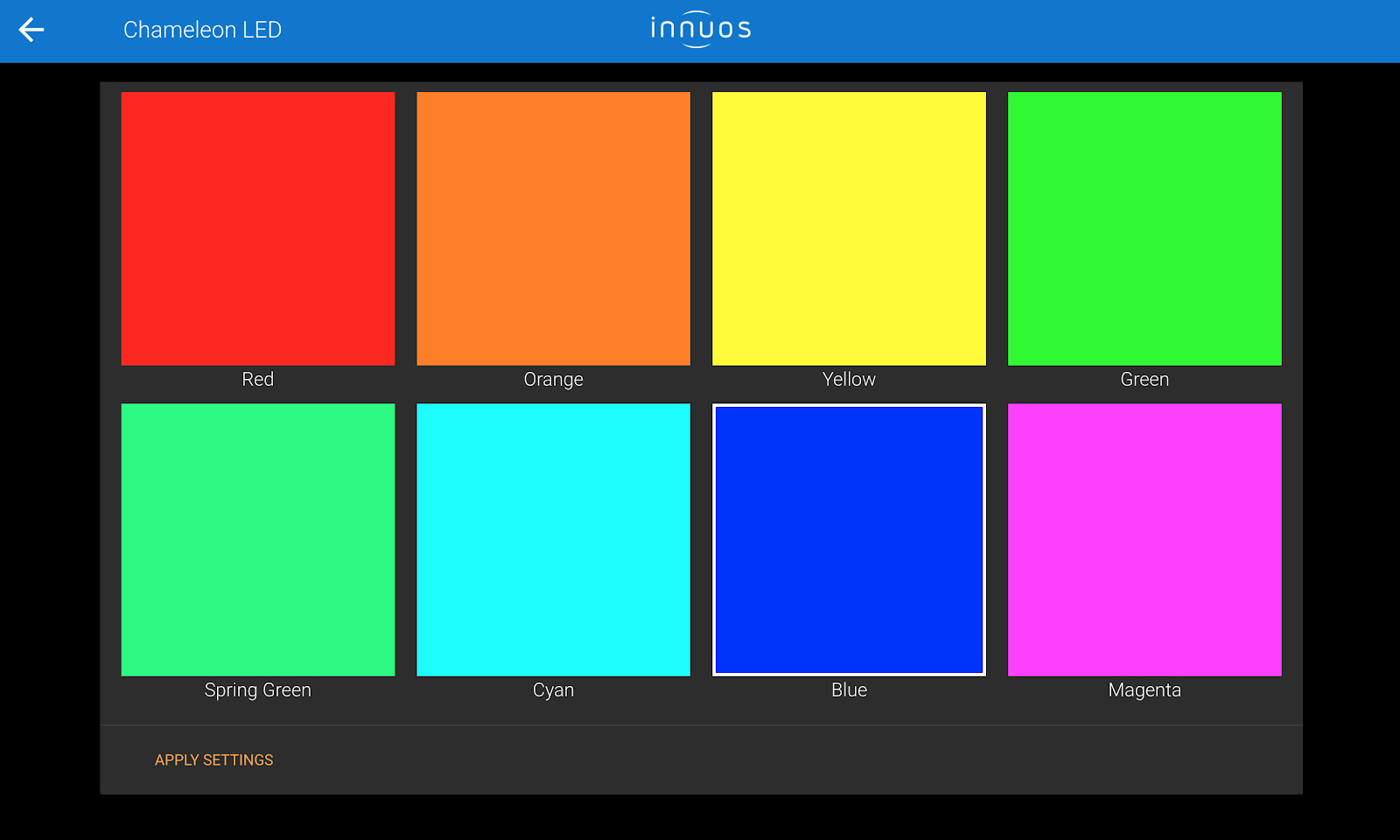
The Zenith MK3 was simple to set up with a few cable connections and is configured online at my.innuos.com. It requires a wired Network cable connection which connects the LAN port on the Innuos unit to a router or mesh wifi satellite. Then the DAC is connected via USB to the DAC port on the Innuos. Finally, the power cable is attached and the unit can be powered on and configured.
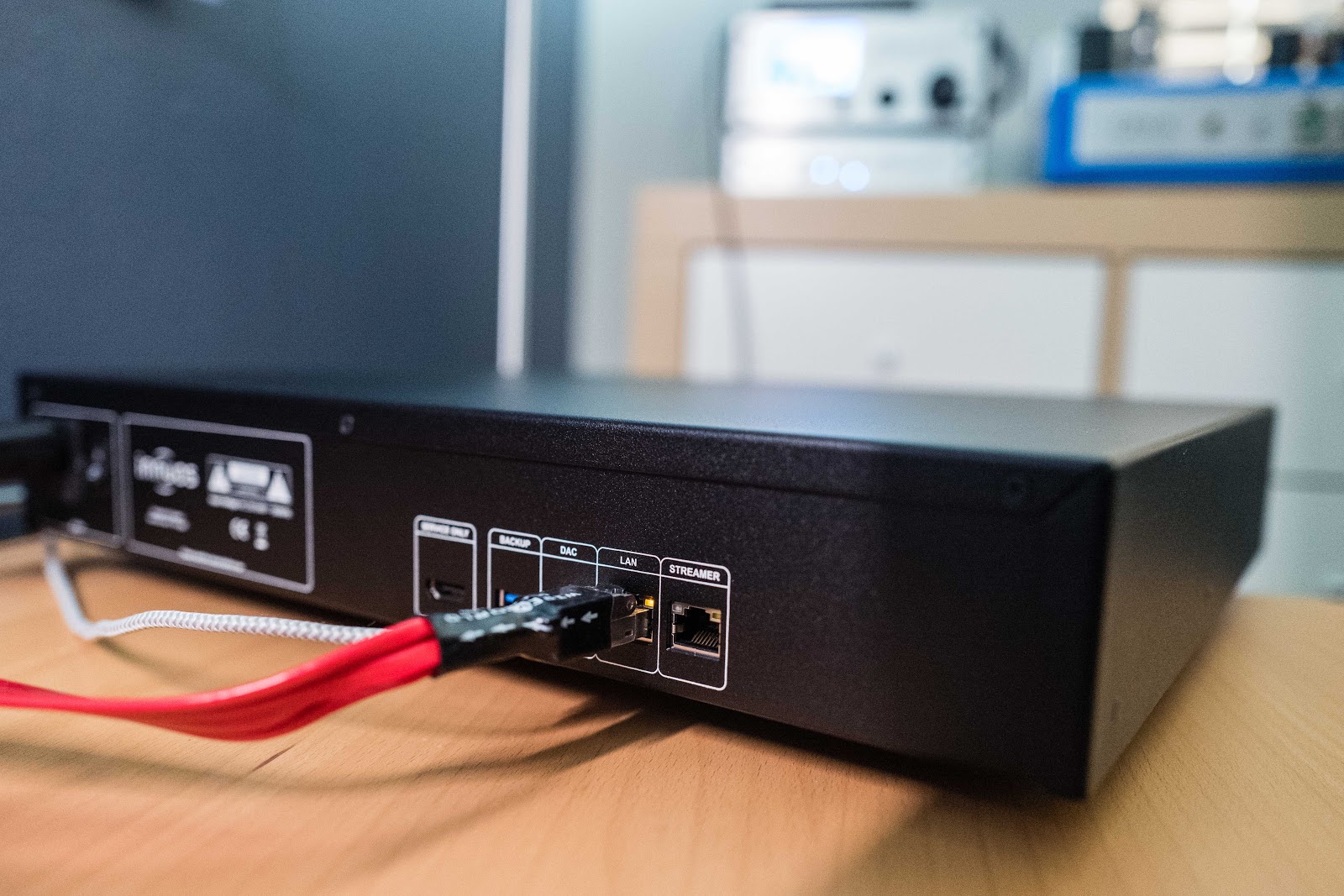
The Innuos Dashboard at my.innuos.com is the homepage to manage the music library, configure music subscription services and to make changes to the unit’s settings. Once the connections have been made and the unit powered on, the unit will automatically connect and show the online status of the unit.

The next step is to add music to the library. This is done by using the Import Menu which enables the transfer of music files from external hard drives or using the Disk Ripper function to rip CD’s into the unit’s internal solid state drive. In both cases, this is a seamless and fast process. Lastly, music streaming services can be configured in the Settings menu where I added my user credentials for Tidal and Qobuz.
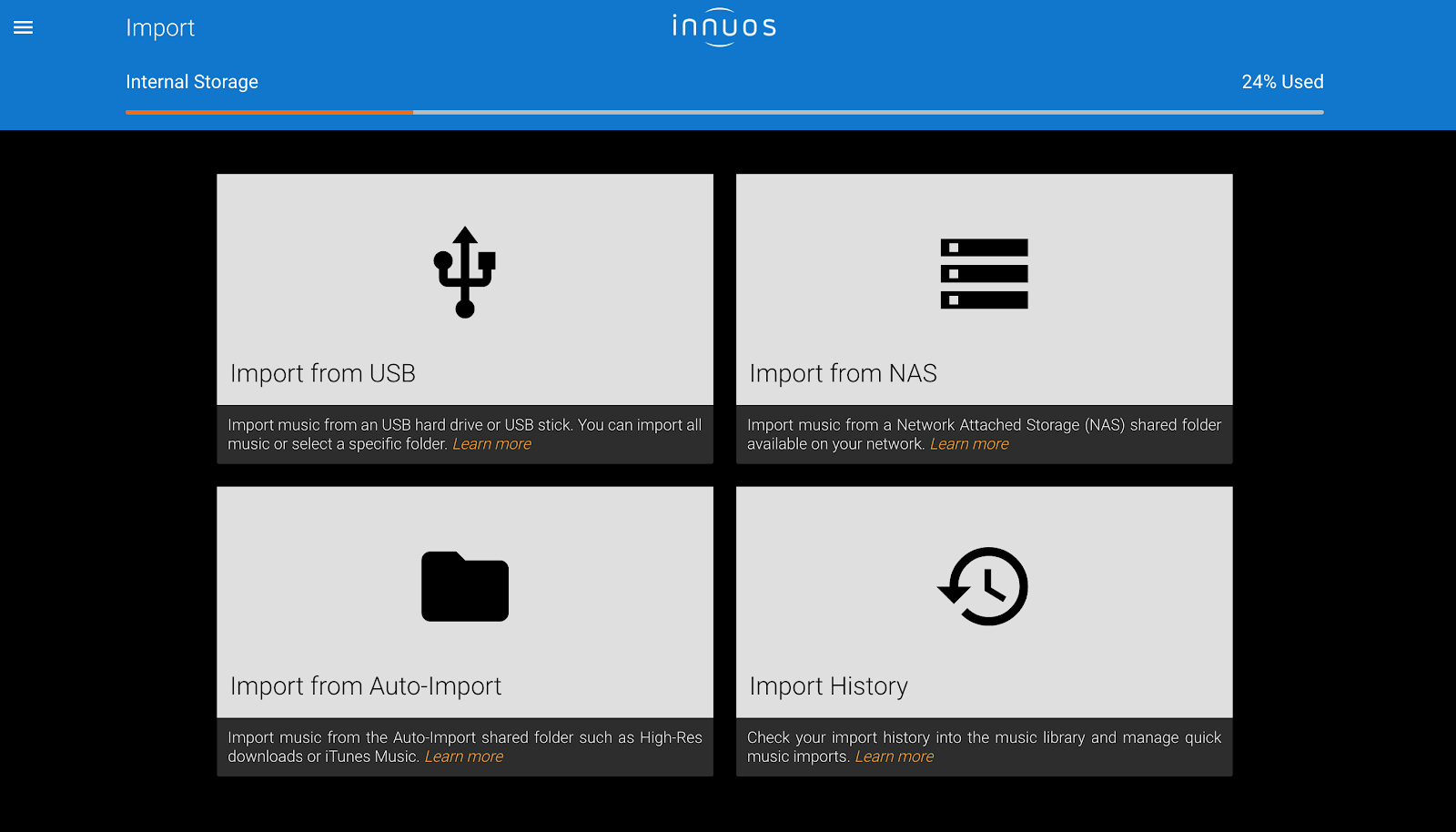
There are two main ways to use the Zenith MK3 both of which can be easily toggled in the Music Server Settings on the my.innuos.com homepage. The first is using Roon to manage the music library, the main benefit of this approach is the ability to use Roon’s highly advanced user interface. The second method is using the integrated Squeezebox player that can be controlled remotely on a mobile device using iPeng (for iOS devices) and Orange Squeeze (for Android devices). For the moment, using your desktop computer is limited to Windows users, with dedicated Innuos app/playback software in the works to fill this gap.

To sum up, all of your music, whether your own music files or your subscription based services can now be managed from one source and one user interface. Very cool.

Sound Impressions
Managing your entire music library from a mobile device makes for a fluid and convenient user experience but how does it sound and is there really an improvement over using a regular computer/external hard drive solution or other lower cost streaming solutions?
Before integrating the Zenith MK3 into my system, I was running Roon using a Sonore microRendu streamer with an upgraded Uptone Audio LPS-1 power supply. This system is a clear upgrade over a traditional DAC to USB connection with my computer with better dynamics, and a more focused image coming across. The music sounds less “stressed” and more free flowing enabling longer listening sessions without fatigue. This is mainly due to the reduction in jitter and noise that streaming solution provide.
The system used to evaluate the Innuos unit was a Chord Electronics Hugo 2 feeding the Benchmark HPA4 line amplifier using its headphone amplifier and at times feeding the DNA Stratus 2A3 headphone amplifier. Headphones used were the Hifiman Susvara and HE1000SE, Abyss Diana Phi, and MrSpeakers Ether 2.
Replacing the Sonore microRendu steamer with the Innuos Zenith MK3 takes the improvement gains from the microRendu streamer and expands on it in a significant way. Everything sounds cleaner, more in focus, snappier, with an even blacker background due to the low noise floor. Music sounds smoother but without the loss of resolution or detail. It just sounds more real. The difference was not subtle for me and was comparable to the sound quality gains from going from a budget DAC to a higher end DAC.
I used the unit in two types of configurations. The first was using Roon as the endpoint so the entire interface and remote is handled within the Roon environment. This method offers the best user experience as Roon can be seamlessly operated on your desktop or mobile device with the polish associated with the Roon user interface.
The second configuration was using the Innuos software and Orange Squeeze as a remote interface on my Android mobile device. This setup offers a slightly more organic sound that can be described as even smoother and more natural sounding. Switching between the two configurations is seamless and done via the Music Server Integration menu in the Settings tab on the Innuos homepage.
Overall, I preferred the slightly more organic nature of the sound signature using the internal Innuos configuration over the Roon configuration but preferred the user interface and overall experience of using the Roon configuration. Innuos is planning to release its own player and app later this year so that solution will likely be the best of both worlds.
Conclusion
Going in to this review, I was already aware of the advantages of using a music server and yet my experience with the Innuos Zenith MK3 has been revelatory. The convenience of having your entire music library and streaming services incorporated into one unit with the ability to control remotely with a mobile device is substantial. More importantly, there are significant sound quality gains to be had by using a digital transport solution like the Innuos MK3 with a lower noise floor and a more organic, natural sound that sounds more focused and unconstrained at the same time. I would highly recommend auditioning the Innuos line of music servers and for those looking to incorporate a music server into their system, be sure to add Innuos to your shortlist.
A friend once told me the old audiophile adage “everything matters”. For Head-Fiers, a common topic of conversation has traditionally revolved around the level of importance attributed to individual pieces making up the audio chain. This usually translates to how to best to divide the pie between the headphones, headphone amplifier, DAC, with source and cables also factoring in to the equation.
As audiophiles transitioned from albums to CD’s and and increasingly over the past few years to music files and streaming, a common goal amongst audio enthusiasts remains the pursuit of the most faithful reproduction of the recording in order to get as close to the music as possible. Many today are using streaming services such as Tidal and Qobuz, and/or are using their lossless music files stored on an external hard drive. To this end, companies are developing dedicated music server and streaming products that attempt to solve the most common problem of computer based music systems, that of noisy USB connections, jitter, and other electrical noise.
The objective of music servers is to reduce the noise floor as much as possible and to provide a clear improvement over a direct USB connection to a computer. Or even better, to remove the computer and external hard drive altogether and have a dedicated device that provides a complete digital transport solution.
As people increasingly interact with their phones and tablets, forward thinking companies are developing products that users can interface with regardless of device being used. One of the biggest highlights at CanJam NYC 2019 was a company from Portugal called Innuos. Over the past couple of years, Innuos has been making waves with their Music Servers that come in 3 basic levels, ZENMINI, ZEN, and ZENITH as well as their flagship product, the Statement. This review is focused on the Zenith MK3, although the setup, user interface, and CD drive operation is the same across all of the Innuos product lines.
The Innuos Zenith MK3 is a high end music server (MSRP: $4249) that enables the complete management of a music library that is stored on internal SSD storage as well as the streaming of popular audiophile music services like Tidal and Qobuz. In other words, this is a dedicated computer for your music library that has a quad-core CPU, 8GB or RAM, a size configurable internal SSD drive to store music, a CD drive to rip CD’s into the SSD drive, and also streams music service such as Tidal or Qobuz. The Zenith MK3 is then operated on your computer (via Roon or Windows compatible app), or tablet/mobile device with approved apps for iOs (iPeng) or Android (Orange Squeeze).
Setup
Opening the box reveals a full rack size component measuring 16.5” wide, 12.5” deep, 2.75” tall and weighing in at a hefty 20 lbs. The unit has a sturdy, high quality build with a sculpted, silver faceplate that has a CD drive slot on the top left side and a single power button on the bottom right. The power button also incorporates a single LED status indicator which can also be configured to display different LED colors to suit user preferences, a small but nice touch.
The Zenith MK3 was simple to set up with a few cable connections and is configured online at my.innuos.com. It requires a wired Network cable connection which connects the LAN port on the Innuos unit to a router or mesh wifi satellite. Then the DAC is connected via USB to the DAC port on the Innuos. Finally, the power cable is attached and the unit can be powered on and configured.
The Innuos Dashboard at my.innuos.com is the homepage to manage the music library, configure music subscription services and to make changes to the unit’s settings. Once the connections have been made and the unit powered on, the unit will automatically connect and show the online status of the unit.
The next step is to add music to the library. This is done by using the Import Menu which enables the transfer of music files from external hard drives or using the Disk Ripper function to rip CD’s into the unit’s internal solid state drive. In both cases, this is a seamless and fast process. Lastly, music streaming services can be configured in the Settings menu where I added my user credentials for Tidal and Qobuz.
There are two main ways to use the Zenith MK3 both of which can be easily toggled in the Music Server Settings on the my.innuos.com homepage. The first is using Roon to manage the music library, the main benefit of this approach is the ability to use Roon’s highly advanced user interface. The second method is using the integrated Squeezebox player that can be controlled remotely on a mobile device using iPeng (for iOS devices) and Orange Squeeze (for Android devices). For the moment, using your desktop computer is limited to Windows users, with dedicated Innuos app/playback software in the works to fill this gap.
To sum up, all of your music, whether your own music files or your subscription based services can now be managed from one source and one user interface. Very cool.
Sound Impressions
Managing your entire music library from a mobile device makes for a fluid and convenient user experience but how does it sound and is there really an improvement over using a regular computer/external hard drive solution or other lower cost streaming solutions?
Before integrating the Zenith MK3 into my system, I was running Roon using a Sonore microRendu streamer with an upgraded Uptone Audio LPS-1 power supply. This system is a clear upgrade over a traditional DAC to USB connection with my computer with better dynamics, and a more focused image coming across. The music sounds less “stressed” and more free flowing enabling longer listening sessions without fatigue. This is mainly due to the reduction in jitter and noise that streaming solution provide.
The system used to evaluate the Innuos unit was a Chord Electronics Hugo 2 feeding the Benchmark HPA4 line amplifier using its headphone amplifier and at times feeding the DNA Stratus 2A3 headphone amplifier. Headphones used were the Hifiman Susvara and HE1000SE, Abyss Diana Phi, and MrSpeakers Ether 2.
Replacing the Sonore microRendu steamer with the Innuos Zenith MK3 takes the improvement gains from the microRendu streamer and expands on it in a significant way. Everything sounds cleaner, more in focus, snappier, with an even blacker background due to the low noise floor. Music sounds smoother but without the loss of resolution or detail. It just sounds more real. The difference was not subtle for me and was comparable to the sound quality gains from going from a budget DAC to a higher end DAC.
I used the unit in two types of configurations. The first was using Roon as the endpoint so the entire interface and remote is handled within the Roon environment. This method offers the best user experience as Roon can be seamlessly operated on your desktop or mobile device with the polish associated with the Roon user interface.
The second configuration was using the Innuos software and Orange Squeeze as a remote interface on my Android mobile device. This setup offers a slightly more organic sound that can be described as even smoother and more natural sounding. Switching between the two configurations is seamless and done via the Music Server Integration menu in the Settings tab on the Innuos homepage.
Overall, I preferred the slightly more organic nature of the sound signature using the internal Innuos configuration over the Roon configuration but preferred the user interface and overall experience of using the Roon configuration. Innuos is planning to release its own player and app later this year so that solution will likely be the best of both worlds.
Conclusion
Going in to this review, I was already aware of the advantages of using a music server and yet my experience with the Innuos Zenith MK3 has been revelatory. The convenience of having your entire music library and streaming services incorporated into one unit with the ability to control remotely with a mobile device is substantial. More importantly, there are significant sound quality gains to be had by using a digital transport solution like the Innuos MK3 with a lower noise floor and a more organic, natural sound that sounds more focused and unconstrained at the same time. I would highly recommend auditioning the Innuos line of music servers and for those looking to incorporate a music server into their system, be sure to add Innuos to your shortlist.
jeffhawke
@teknorob23 The model I purchased is a ZenMini Mk3, not the Zenith Mk3 as shown in the review. Hence, the discount I got is just about 300 euro, not 2000  Pretty similar though, besides not having the big internal power supply.
Pretty similar though, besides not having the big internal power supply.
 Pretty similar though, besides not having the big internal power supply.
Pretty similar though, besides not having the big internal power supply.
Dipesh
Innous Usb reclocker or M scaler?
Current chain - Zenith MK3- Chord DAve- Amps and sound Nautilus - susvara
Current chain - Zenith MK3- Chord DAve- Amps and sound Nautilus - susvara
Pros: Neutral reference sound signature, natural and effortless frequency response, fantastic ergonomics and comfort
Cons: None
Introduction
In November 2018, Head-Fi held its first CanJam event in Shanghai, China, and it turned out to be a resounding success. One of the reasons to enter the Chinese market was to enable the exposure of Chinese brands to the international headphone audio market as the last few years have seen a rapid proliferation of high quality audio products coming from China. And while many of the products are firmly in the entry and mid-level tier, a number of companies are also honing their technological skills and producing true summit-fi products.
The last few years have also seen a rapid growth of new in-ear monitor (IEM) products as personal/portable audio continues its incredible growth trend within the global audio industry. Increasingly, headphone enthusiasts and mobile technology consumers are looking at IEM’s as their primary headphone of choice. Thankfully, the performance level of IEMs has improved across the board with great products at all price ranges.

During our visit to CanJam Shanghai 2018, Jude and I had an opportunity to spend a few days in Shenzhen, where several of the emerging headphone audio companies are located. One of the companies we visited was qdc, a local company specializing in communications hardware for military and police, IEMs for professional musicians, as well as a recently expanded product line to cater to the enthusiast audiophile market. We were struck by the extremely high level of innovation at the facility, which included a full anechoic chamber along with some of the finest audio testing equipment currently available. And during our visit, we were able to test out most of qdc’s earphone offerings.


The 10 driver Anole VX is qdc’s current summit-fi earphone and is currently qdc’s most expensive offering at approximately $2500. I’ve now had a few months of using the Anole VX as my daily driver IEM and remain very impressed with the sound quality and overall ergonomics of this piece. The Anole VX-S (Standard) is the universal fit version and there is also a custom version, the VX-C, which sells for a surcharge of approximately $200.
Tuning Switches
The Anole VX is a balanced armature design with 10 micro balanced armature drivers. In handling and using the earphones for the first time, the most immediate design feature that stands out are 3 tuning switches on each earphone shell for low, medium, and high frequencies labeled 1, 2, and 3, respectively. There are 2 positions for each switch, which essentially act as a slight frequency boost. And although my preferred sound signature is with all switches down (off), I can certainly see the benefit of being able to individually tune according to tase, mood, and/or specific recording.

Packaging, Build Quality, and Ergonomics

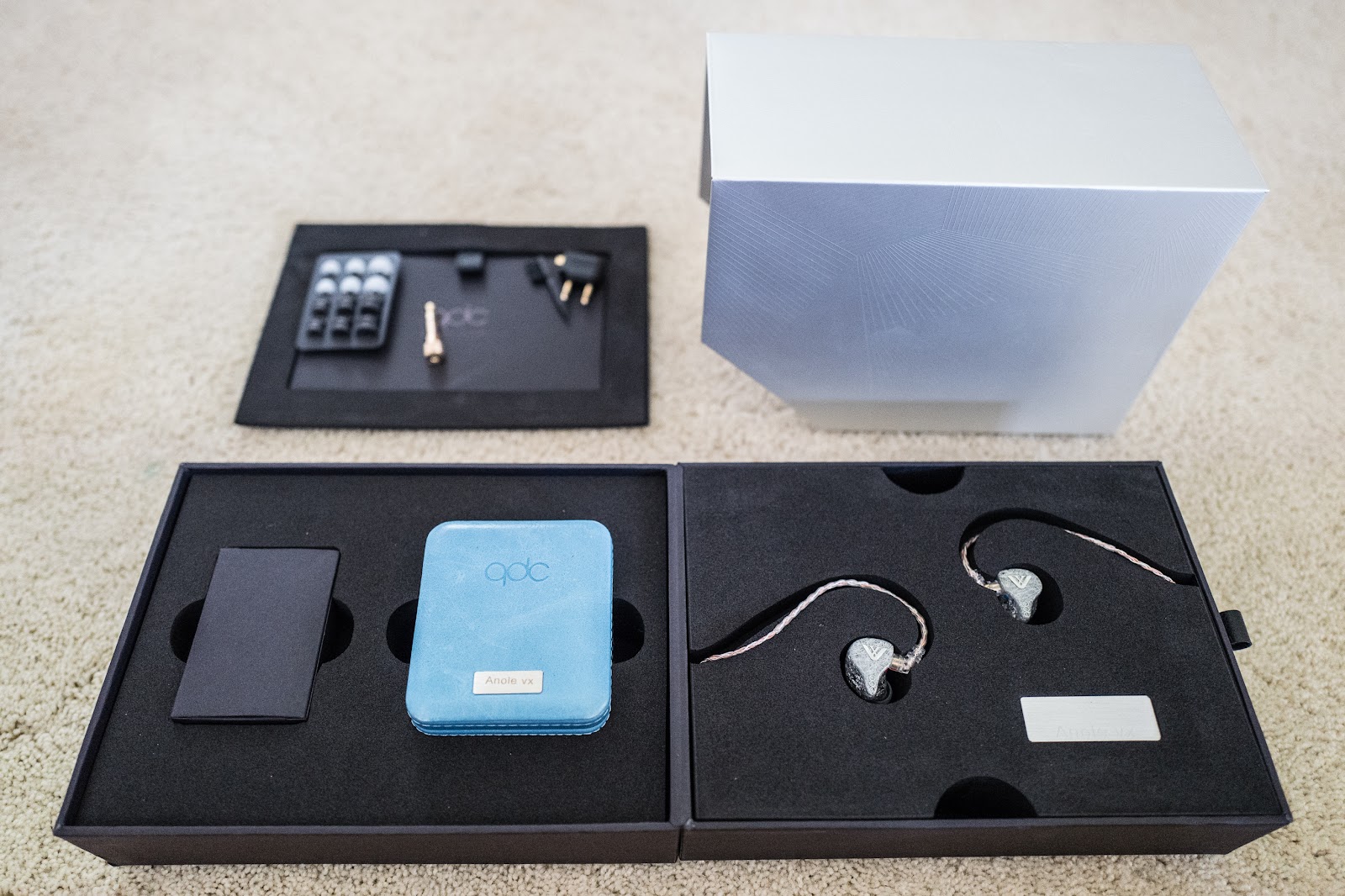
The packaging of the Anole VX is of very high quality, and unboxing this earphone gives the feeling of handling a luxury product. The silver outer slipcase reveals a black box which fully opens and lies fully flat to reveal the contents inside. The accessories include a light blue carrying case, silicone eartips, airline adapter, and 3.5 to ¼” adapter.
The supplied cable is an extremely well built and solid braided cable containing 2 wires, each of silver and copper. The cable folds nicely, and does not get tangled, making for an ergonomic user experience.

The earpieces have a great visual effect of crushed pieces of aluminum and are a striking design. They are also a lot smaller than similar 10 driver earphones which result in fantastic user comfort. With zero pressure or discomfort after extended periods of use, the Anole VX is, in fact, among the most comfortable earphones I’ve ever used. I’ve also tried several types of eartips and settled on the qdc supplied white silicone tips as these provided the best ergonomic fit for me.
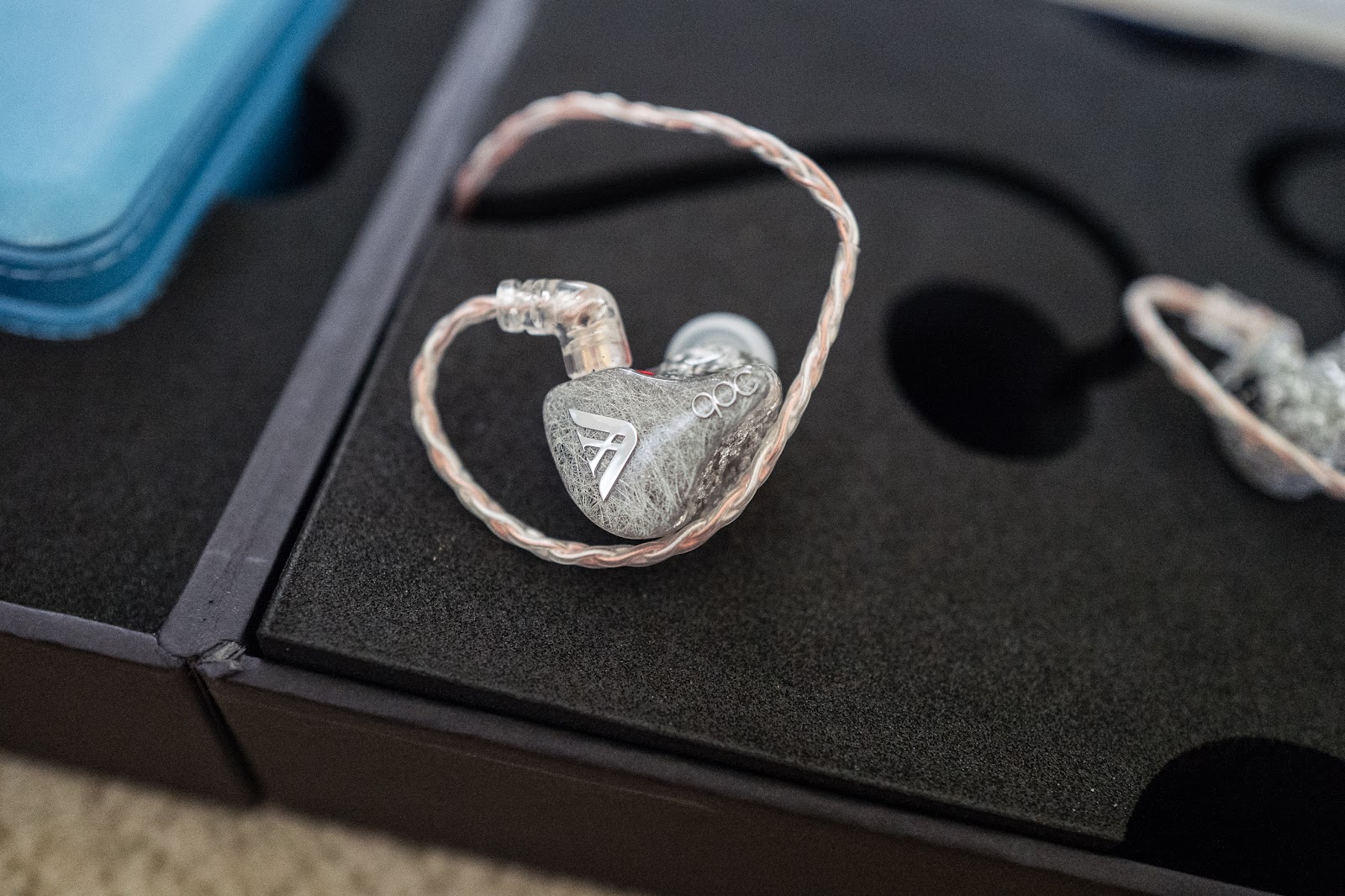
Sound Impressions
I use the Anole VX primarily with an Astell+Kern SP1000 copper and have also used it with a Chord Hugo 2, as well as a Benchmark HPA4 desktop headphone amplifier. In each case, the Anole VX scales higher and sounds “bigger.” I would describe the Anole VX sound signature (with all tuning switches off) as a neutral and natural reference sound with a slight touch of warmth. This is probably my ideal reference type of sound signature, and I continue to be mightily impressed with this earphone, and the seemingly effortless way it goes about its business of presenting a remarkable coherent sound signature that sounds very close to the full size flagship headphone category. If it sounds like I’m gushing, I am. It’s just simply that good.
The Anole VX is engaging without being fatiguing, transparent without any harshness or sibilance, and has an “out of your head” soundstage which is rarified air for an earphone. It also has the bass slam and visceral impact when called upon and sounds completely natural in the process without taking away from any other frequency.
When listening to many other top tier IEM’s, I can usually pinpoint some area of weakness or room for improvement. This is proving to be really difficult with the Anole VX as it simply ticks all of my boxes in terms of sound signature, ergonomics of ear pieces and cable, and overall comfort.
Sounds Impression Comparisons with other IEM/CIEM’s
Here is a brief comparison of the sonic differences between the Anole VX and a few other IEM’s on hand. All of the comparisons are with stock cables and using the Astell&Kern SP1000 copper.
Campfire Audio Solaris (Universals)
The Campfire Audio Solaris is a quad hybrid earphone with 3 balanced armature drivers and 1 dynamic driver. The Solaris is Campfire Audio’s current flagship IEM and retails for $1499. Of the earphones in this comparison list, the Solaris sounds the closest to the Anole VX in terms of sound signature. I feel that the Anole VX is a touch smoother, more transparent, has more space between instruments and is a more comfortable fit due to its much smaller physical size. Nonetheless, coming in at $1499, the Solaris represents good value for money and is one of the best IEM releases of 2018.
64 Audio Tia Fourte (Universals)
The 64 Audio Tia Fourte is considered among the highest performing flagship IEMs with an equally impressive price to match at $3499. The Tia driver technology is excellent, and while the Tio Fourte does cast a slightly wider soundstage, the Anole VX digs a little deeper with more depth and an overall more balanced and coherent frequency response.
Ultimate Ears LIVE (Customs)
The Ultimate Ears UE LIVE was released as a monitor for live musicians, and the sound signature does deviate a little from a traditional audiophile type of sound. The emphasis of the UE LIVE is a more organic tonality with less treble emphasis. This results in a smooth and dark sound signature, albeit with a wide and deep soundstage. In a direct comparison with the Anole VX, the UE LIVE sounds dark, veiled, and lacking in transparency and overall coherency. It is however, a fun sounding IEM and has its appeal if this type of sound signature is preferred.
Conclusion
The qdc Anole VX is a remarkable earphone and one of the best flagships currently available. It has an ideal blend of transparency and musicality, with a natural tonality and smoothness to the sound signature that just sounds right. It is also equally comfortable, and the ergonomics are second to none enabling long and fatigue free listening sessions.
It’s great to see Chinese manufacturers continuing to push the envelope in headphone and earphone technology. Hifiman has done this with their full size headphones, and qdc seems to be doing this with their earphones. The Anole VX is a must audition if you are in the market for a neutral reference flagship IEM, and for those able to attend CanJam NYC 2019, be sure to stop by the qdc booth to check these out. Very enthusiastically recommended!

In November 2018, Head-Fi held its first CanJam event in Shanghai, China, and it turned out to be a resounding success. One of the reasons to enter the Chinese market was to enable the exposure of Chinese brands to the international headphone audio market as the last few years have seen a rapid proliferation of high quality audio products coming from China. And while many of the products are firmly in the entry and mid-level tier, a number of companies are also honing their technological skills and producing true summit-fi products.
The last few years have also seen a rapid growth of new in-ear monitor (IEM) products as personal/portable audio continues its incredible growth trend within the global audio industry. Increasingly, headphone enthusiasts and mobile technology consumers are looking at IEM’s as their primary headphone of choice. Thankfully, the performance level of IEMs has improved across the board with great products at all price ranges.
During our visit to CanJam Shanghai 2018, Jude and I had an opportunity to spend a few days in Shenzhen, where several of the emerging headphone audio companies are located. One of the companies we visited was qdc, a local company specializing in communications hardware for military and police, IEMs for professional musicians, as well as a recently expanded product line to cater to the enthusiast audiophile market. We were struck by the extremely high level of innovation at the facility, which included a full anechoic chamber along with some of the finest audio testing equipment currently available. And during our visit, we were able to test out most of qdc’s earphone offerings.
The 10 driver Anole VX is qdc’s current summit-fi earphone and is currently qdc’s most expensive offering at approximately $2500. I’ve now had a few months of using the Anole VX as my daily driver IEM and remain very impressed with the sound quality and overall ergonomics of this piece. The Anole VX-S (Standard) is the universal fit version and there is also a custom version, the VX-C, which sells for a surcharge of approximately $200.
Tuning Switches
The Anole VX is a balanced armature design with 10 micro balanced armature drivers. In handling and using the earphones for the first time, the most immediate design feature that stands out are 3 tuning switches on each earphone shell for low, medium, and high frequencies labeled 1, 2, and 3, respectively. There are 2 positions for each switch, which essentially act as a slight frequency boost. And although my preferred sound signature is with all switches down (off), I can certainly see the benefit of being able to individually tune according to tase, mood, and/or specific recording.
Packaging, Build Quality, and Ergonomics
The packaging of the Anole VX is of very high quality, and unboxing this earphone gives the feeling of handling a luxury product. The silver outer slipcase reveals a black box which fully opens and lies fully flat to reveal the contents inside. The accessories include a light blue carrying case, silicone eartips, airline adapter, and 3.5 to ¼” adapter.
The supplied cable is an extremely well built and solid braided cable containing 2 wires, each of silver and copper. The cable folds nicely, and does not get tangled, making for an ergonomic user experience.
The earpieces have a great visual effect of crushed pieces of aluminum and are a striking design. They are also a lot smaller than similar 10 driver earphones which result in fantastic user comfort. With zero pressure or discomfort after extended periods of use, the Anole VX is, in fact, among the most comfortable earphones I’ve ever used. I’ve also tried several types of eartips and settled on the qdc supplied white silicone tips as these provided the best ergonomic fit for me.
Sound Impressions
I use the Anole VX primarily with an Astell+Kern SP1000 copper and have also used it with a Chord Hugo 2, as well as a Benchmark HPA4 desktop headphone amplifier. In each case, the Anole VX scales higher and sounds “bigger.” I would describe the Anole VX sound signature (with all tuning switches off) as a neutral and natural reference sound with a slight touch of warmth. This is probably my ideal reference type of sound signature, and I continue to be mightily impressed with this earphone, and the seemingly effortless way it goes about its business of presenting a remarkable coherent sound signature that sounds very close to the full size flagship headphone category. If it sounds like I’m gushing, I am. It’s just simply that good.
The Anole VX is engaging without being fatiguing, transparent without any harshness or sibilance, and has an “out of your head” soundstage which is rarified air for an earphone. It also has the bass slam and visceral impact when called upon and sounds completely natural in the process without taking away from any other frequency.
When listening to many other top tier IEM’s, I can usually pinpoint some area of weakness or room for improvement. This is proving to be really difficult with the Anole VX as it simply ticks all of my boxes in terms of sound signature, ergonomics of ear pieces and cable, and overall comfort.
Sounds Impression Comparisons with other IEM/CIEM’s
Here is a brief comparison of the sonic differences between the Anole VX and a few other IEM’s on hand. All of the comparisons are with stock cables and using the Astell&Kern SP1000 copper.
Campfire Audio Solaris (Universals)
The Campfire Audio Solaris is a quad hybrid earphone with 3 balanced armature drivers and 1 dynamic driver. The Solaris is Campfire Audio’s current flagship IEM and retails for $1499. Of the earphones in this comparison list, the Solaris sounds the closest to the Anole VX in terms of sound signature. I feel that the Anole VX is a touch smoother, more transparent, has more space between instruments and is a more comfortable fit due to its much smaller physical size. Nonetheless, coming in at $1499, the Solaris represents good value for money and is one of the best IEM releases of 2018.
64 Audio Tia Fourte (Universals)
The 64 Audio Tia Fourte is considered among the highest performing flagship IEMs with an equally impressive price to match at $3499. The Tia driver technology is excellent, and while the Tio Fourte does cast a slightly wider soundstage, the Anole VX digs a little deeper with more depth and an overall more balanced and coherent frequency response.
Ultimate Ears LIVE (Customs)
The Ultimate Ears UE LIVE was released as a monitor for live musicians, and the sound signature does deviate a little from a traditional audiophile type of sound. The emphasis of the UE LIVE is a more organic tonality with less treble emphasis. This results in a smooth and dark sound signature, albeit with a wide and deep soundstage. In a direct comparison with the Anole VX, the UE LIVE sounds dark, veiled, and lacking in transparency and overall coherency. It is however, a fun sounding IEM and has its appeal if this type of sound signature is preferred.
Conclusion
The qdc Anole VX is a remarkable earphone and one of the best flagships currently available. It has an ideal blend of transparency and musicality, with a natural tonality and smoothness to the sound signature that just sounds right. It is also equally comfortable, and the ergonomics are second to none enabling long and fatigue free listening sessions.
It’s great to see Chinese manufacturers continuing to push the envelope in headphone and earphone technology. Hifiman has done this with their full size headphones, and qdc seems to be doing this with their earphones. The Anole VX is a must audition if you are in the market for a neutral reference flagship IEM, and for those able to attend CanJam NYC 2019, be sure to stop by the qdc booth to check these out. Very enthusiastically recommended!
gunwale
Canjam singapore is end of march. I tested them at music sanctuary so I guess they will be one of the representative. Singapore is very small. Even if they don't sell it at canjam you can always take a 20min train ride to their shop.
Tweety 99
Great review. It made me ordering one for me!
F208Frank
I tried these at CanJam NYC 2019 and they were pretty good. The price is a bit high but I guess that would be subjective to the individual purchasing.
Pros: Natural, musical, and smooth sound signature
High level of transparency and resolution
Incredible bass response and slam
Featherweight and very comfortable
High level of transparency and resolution
Incredible bass response and slam
Featherweight and very comfortable
Cons: Clamping force due to memory wire might be too high for some
Introduction
A few weeks ago at an audio event in Los Angeles, I was sitting at a table with Dan Clark and Andy Regan of MrSpeakers and we were treated to a wonderful live jazz ensemble performance. While talking about sound signatures of headphones in general, Dan suggested that I close my eyes and really listen to how the live drums and piano actually sounded. Natural, silky, and smooth were the immediate things that came to mind and as we continued to talk about the Ether 2, it became clear that Dan’s design goals were to create a sound signature that would be as close to live music as possible while enabling users to enjoy their music over long listening sessions and without ear fatigue.
For those not yet familiar, Dan Clark is one of the busiest guys in the high-end headphone audio industry. Over the past several years, MrSpeakers has had a string of groundbreaking products that started with the MrSpeakers Mad Dog headphone in 2012, a heavily modified Fostex T50RP that retailed for $300. Even then it seemed apparent that Dan’s vision was to bring headphones to market that would present a musical, engaging, realistic, and comfortable sonic experience while at the same time delivering fantastic value to us, the audio enthusiast community.
Over time, MrSpeakers continued to push the envelope and do extensive work on earpad, headband, and driver design, as well as his first foray into 3d printed ear cups with the Alpha Dog, called the Super-Cup. The 2013 released Alpha Dog retailed for $600 and continued to showcase MrSpeakers as a strong value proposition in relation to competitive products by other more established headphone manufacturers. It would be followed up in 2014 with the Alpha Prime, a further enhancement of the Alpha Dog which would be MrSpeakers last headphone that still used the (heavily modified) T50RP planar drivers. Cue the Ether.
The MrSpeakers Ether was released in 2015 and was the first MrSpeakers headphone completely built from the ground up utilizing all of the knowledge gained with its previous modification and design work. The Ether (open) and Ether C (closed) were runaway hits and firmly established MrSpeakers as one of the premier high end headphone manufacturers. The $1500 Ether was now a direct competitor with planar offerings from Audeze and Hifiman, as well as the Sennheiser HD800, the neutral reference headphone of choice for many. The Ether’s sound signature could generally be described as a reference, neutral type of sound, which many enthusiasts at the time felt combined some of the best attributes of the Sennheiser HD800 in terms of its highs and the Hifiman HE-6 in terms of its bass response and overall physicality. More importantly, it was perhaps the first direct competitor to the HD800 that could provide some of the HD800’s core sound signature characteristics, with the addition of an enhanced bass response, one of the niggling points of critique with the HD800. Since the release of the Ether, Dan and the MrSpeakers team have been hard at work with subsequent Ether Flow and AEON releases, existing headphone model upgrades, and notably in 2018, the release of the VOCE electrostatic headphone. Much of the design and development work on the VOCE was able to trickle down to the Ether 2.
The Ether 2 was released in late 2018 and is now the flagship planar magnetic headphone from MrSpeakers.
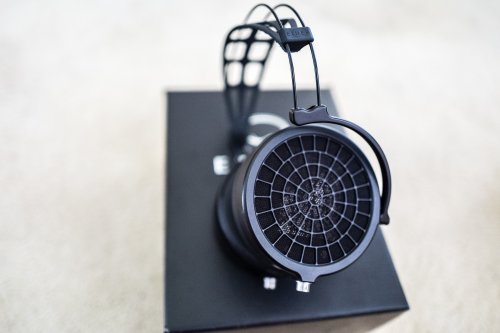
What’s in the Box
The Ether 2 comes packaged in a branded Ether 2 box along with a Quick Start Guide, microfiber cloth, and Certificate of Authenticity with the headphone serial number. The headphone itself comes in a black hardshell carrying case, a welcome and useful addition that I wish more headphones manufacturers would provide in the box. In terms of overall packaging, think practicality over luxury.


Design, Build Quality, and Ergonomics
One of the first things to notice when first picking up and handling the Ether 2 is the weight. Or rather, the lack of it. This is one seriously light headphone, coming in at 290 grams or 90 grams lighter than the most recent incarnation of the Ether family, the Ether Flow.
The Ether 2 shares much of its design DNA with the electrostatic VOCE and is immediately noticeable by the “spider web” ear cup grilles and headband. The matte, all-black aesthetic gives it a very lean and stealthy look. Very cool. The headphone has an all-metal headphone ear cup, headband, and a carbon fiber driver baffle. The feeling of the headphone earcups in hand is quite special, as it’s an incredibly smooth texture that just feels “right,” for lack of a better term. The headphone uses the same flexible NiTinol memory metal for its headband along with a perforated leather strap. While providing a large range for optimal fit, those with very large heads might find the head strap and memory metal touching at the top of the head without any space in between. Additionally, there is a fairly high level of clamping force from the memory metal wire which might reduce the comfort level for those with larger head sizes. The earpads are made of synthetic leather which looks and feels of high quality and feels like a slightly stiff memory foam. And while these can get a little warm after extended use, it never got to the point of being uncomfortable. The ear pad openings are angled and are large and deep enough for a fully circumaural fit for my slightly larger than average ear size. Overall, the comfort level of the Ether 2 is excellent and among the more comfortable headphones I’ve used.

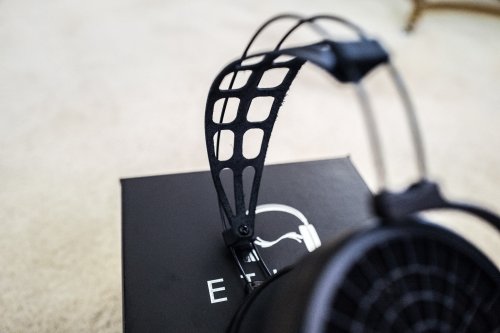

Sound Impressions
The main system used for reviewing the Ether 2 is the Sonore microRendu/Uptone Audio LPS-1 running Roon Server into a Chord Hugo 2 DAC and Benchmark HPA4 headphone amplifier along with the supplied MrSpeakers VIVO headphone cable terminated in 4 pin XLR.
The Ether 2 was burned in for around 100 hours before any critical listening was done. At very first impression, the Ether 2 can come across as smooth and dark. Perhaps overly so. However, after a short period of time the brain adjusts to the sound signature which I feel it can best be described as neutral, musical, and natural. While the soundstage is not the widest or deepest, the presentation is full-bodied, with excellent resolution and a mostly linear response that accentuates the Ether 2’s exceptional bass texture and slam. This in turn has a warming effect which gives the Ether 2 its smooth and musical sound signature and prevents it from sounding clinical. As such, these headphones have little to no sibilance and can be comfortably used for very long listening sessions without fatigue. The highs are silky smooth with vocals sounding realistic and textured. Resolution and dynamics are also excellent with instruments sounding lifelike and not overdone.
Conclusion
The Ether 2 represents a significant step forward in the MrSpeakers brand trajectory by continuing to push the performance envelope while also being made available at a sensible price. It’s simply a fantastic all-around TOTL headphone that sounds natural, combines musicality without the loss of technicalities, and has a stealthy design aesthetic that’s not only visually appealing, but one that gives the user a feeling of using something uniquely special. This one just sounds (and feels) right.
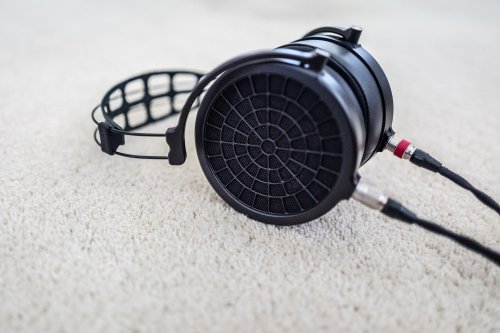


A few weeks ago at an audio event in Los Angeles, I was sitting at a table with Dan Clark and Andy Regan of MrSpeakers and we were treated to a wonderful live jazz ensemble performance. While talking about sound signatures of headphones in general, Dan suggested that I close my eyes and really listen to how the live drums and piano actually sounded. Natural, silky, and smooth were the immediate things that came to mind and as we continued to talk about the Ether 2, it became clear that Dan’s design goals were to create a sound signature that would be as close to live music as possible while enabling users to enjoy their music over long listening sessions and without ear fatigue.
For those not yet familiar, Dan Clark is one of the busiest guys in the high-end headphone audio industry. Over the past several years, MrSpeakers has had a string of groundbreaking products that started with the MrSpeakers Mad Dog headphone in 2012, a heavily modified Fostex T50RP that retailed for $300. Even then it seemed apparent that Dan’s vision was to bring headphones to market that would present a musical, engaging, realistic, and comfortable sonic experience while at the same time delivering fantastic value to us, the audio enthusiast community.
Over time, MrSpeakers continued to push the envelope and do extensive work on earpad, headband, and driver design, as well as his first foray into 3d printed ear cups with the Alpha Dog, called the Super-Cup. The 2013 released Alpha Dog retailed for $600 and continued to showcase MrSpeakers as a strong value proposition in relation to competitive products by other more established headphone manufacturers. It would be followed up in 2014 with the Alpha Prime, a further enhancement of the Alpha Dog which would be MrSpeakers last headphone that still used the (heavily modified) T50RP planar drivers. Cue the Ether.
The MrSpeakers Ether was released in 2015 and was the first MrSpeakers headphone completely built from the ground up utilizing all of the knowledge gained with its previous modification and design work. The Ether (open) and Ether C (closed) were runaway hits and firmly established MrSpeakers as one of the premier high end headphone manufacturers. The $1500 Ether was now a direct competitor with planar offerings from Audeze and Hifiman, as well as the Sennheiser HD800, the neutral reference headphone of choice for many. The Ether’s sound signature could generally be described as a reference, neutral type of sound, which many enthusiasts at the time felt combined some of the best attributes of the Sennheiser HD800 in terms of its highs and the Hifiman HE-6 in terms of its bass response and overall physicality. More importantly, it was perhaps the first direct competitor to the HD800 that could provide some of the HD800’s core sound signature characteristics, with the addition of an enhanced bass response, one of the niggling points of critique with the HD800. Since the release of the Ether, Dan and the MrSpeakers team have been hard at work with subsequent Ether Flow and AEON releases, existing headphone model upgrades, and notably in 2018, the release of the VOCE electrostatic headphone. Much of the design and development work on the VOCE was able to trickle down to the Ether 2.
The Ether 2 was released in late 2018 and is now the flagship planar magnetic headphone from MrSpeakers.

What’s in the Box
The Ether 2 comes packaged in a branded Ether 2 box along with a Quick Start Guide, microfiber cloth, and Certificate of Authenticity with the headphone serial number. The headphone itself comes in a black hardshell carrying case, a welcome and useful addition that I wish more headphones manufacturers would provide in the box. In terms of overall packaging, think practicality over luxury.


Design, Build Quality, and Ergonomics
One of the first things to notice when first picking up and handling the Ether 2 is the weight. Or rather, the lack of it. This is one seriously light headphone, coming in at 290 grams or 90 grams lighter than the most recent incarnation of the Ether family, the Ether Flow.
The Ether 2 shares much of its design DNA with the electrostatic VOCE and is immediately noticeable by the “spider web” ear cup grilles and headband. The matte, all-black aesthetic gives it a very lean and stealthy look. Very cool. The headphone has an all-metal headphone ear cup, headband, and a carbon fiber driver baffle. The feeling of the headphone earcups in hand is quite special, as it’s an incredibly smooth texture that just feels “right,” for lack of a better term. The headphone uses the same flexible NiTinol memory metal for its headband along with a perforated leather strap. While providing a large range for optimal fit, those with very large heads might find the head strap and memory metal touching at the top of the head without any space in between. Additionally, there is a fairly high level of clamping force from the memory metal wire which might reduce the comfort level for those with larger head sizes. The earpads are made of synthetic leather which looks and feels of high quality and feels like a slightly stiff memory foam. And while these can get a little warm after extended use, it never got to the point of being uncomfortable. The ear pad openings are angled and are large and deep enough for a fully circumaural fit for my slightly larger than average ear size. Overall, the comfort level of the Ether 2 is excellent and among the more comfortable headphones I’ve used.



Sound Impressions
The main system used for reviewing the Ether 2 is the Sonore microRendu/Uptone Audio LPS-1 running Roon Server into a Chord Hugo 2 DAC and Benchmark HPA4 headphone amplifier along with the supplied MrSpeakers VIVO headphone cable terminated in 4 pin XLR.
The Ether 2 was burned in for around 100 hours before any critical listening was done. At very first impression, the Ether 2 can come across as smooth and dark. Perhaps overly so. However, after a short period of time the brain adjusts to the sound signature which I feel it can best be described as neutral, musical, and natural. While the soundstage is not the widest or deepest, the presentation is full-bodied, with excellent resolution and a mostly linear response that accentuates the Ether 2’s exceptional bass texture and slam. This in turn has a warming effect which gives the Ether 2 its smooth and musical sound signature and prevents it from sounding clinical. As such, these headphones have little to no sibilance and can be comfortably used for very long listening sessions without fatigue. The highs are silky smooth with vocals sounding realistic and textured. Resolution and dynamics are also excellent with instruments sounding lifelike and not overdone.
Conclusion
The Ether 2 represents a significant step forward in the MrSpeakers brand trajectory by continuing to push the performance envelope while also being made available at a sensible price. It’s simply a fantastic all-around TOTL headphone that sounds natural, combines musicality without the loss of technicalities, and has a stealthy design aesthetic that’s not only visually appealing, but one that gives the user a feeling of using something uniquely special. This one just sounds (and feels) right.



Attachments
Pros: Transparent, "speaker-like" presentation
Highly engaging and realistic tonality
Fantastics looks and build quality
Highly engaging and realistic tonality
Fantastics looks and build quality
Cons: Earcups might be too small for some users,
Provided 5' cable more suited to portable rather than desktop use
Provided 5' cable more suited to portable rather than desktop use
Over the past couple of years, I’ve had the chance to hear various iterations of the Abyss Diana through their development, and was really excited to finally hear the production version earlier this year at CanJam NYC 2018. Although my audition at the time was a relatively short one, it was enough to pique my interest in spending some time with this headphone and I’ve now had the chance to spend time with a production review sample for the past few months.
First a little background on Abyss Headphones and the Diana project. High end cable manufacturer, JPS Labs, formed Abyss Headphones, and their first product, the Abyss AB-1266 took the headphone world by storm back in 2013. The headphone was a serious attempt at creating the best sounding headphone in the world and developed a strong fan following for its unique ability to create a strong sense of realism, and perhaps, the most “speaker-like” sound of any headphone. While the AB-1266 has seen further refinements over the years with the AB-1266 Phi (and the most recent AB-1288 Phi CC), one of the common points of discussion among Abyss fans, has been the ergonomics of the AB-1266. It’s an extremely large headphone, a headphone that requires a proper fit (and the requisite patience) needed to achieve this, as well as a headphone that requires a significant level of upstream gear in order to maximize its enormous potential.
It seems that with this in mind, Abyss Headphones set out to develop a headphone that would preserve much of the sound signature of the larger AB-1266, while addressing some of its ergonomic points of contention, while enabling an overall lower point of entry in terms of its price. Enter the Abyss Diana.
The Diana is a semi-open back design, features large 63 millimeter planar magnetic drivers, and has an impedance rating of 40 ohms. The build quality is second to none, with beautifully machined aluminum ear cups that are finished in ceramic and come in a choice of 3 colors: black, coffee, and white. The headphone is surprisingly light and compact with square shaped leather ear pads that magnetically click into place. And although the Diana is not a true circumaural fit for me, the Diana is light and I found the overall comfort level to be high. The leather and alcantara headband along with a very satisfyingly smooth adjustment mechanism completes a very refined package. One thing to note, the Diana ships with a 5’ cable (with the termination of your choosing) which while great for portable use, might be a tad short for home/desktop users.
I’ve been using the Diana in the following configurations:
Despite the 40 ohm impedance rating, the Abyss Diana will happily take as much juice as you can give it and its sound quality belies its more common “portable” descriptive tag. This is very much a “full” size flagship headphone in a “portable” package. With that said, in order to achieve this full size sound, I would at the minimum recommend using a portable amplifier such as the Hugo 2. A further and distinct improvement was heard when adding the beefier 2A3 tube amp into the chain.
The sound quality of the Diana can be described as open, transparent, punchy, and with fantastic tonality. These headphones will immediately grab your attention with a “speaker-like” and three dimensional presentation that is overall similar, albeit “smaller”, to its bigger brother, the Abyss Phi. The Diana has a more intimate soundstage than the massive soundstage of the Abyss Phi and one that is closer to the Focal Utopia. And while the aforementioned Utopia can, at times, have a “too much of a good thing” type of tonality, the Diana remains remarkably balanced.
Overall, the $2995 Abyss Diana is a flagship headphone that should a must audition for those looking for this level of performance and in this price category. The fact that the Diana is also portable, is icing on a very sweet cake.
First a little background on Abyss Headphones and the Diana project. High end cable manufacturer, JPS Labs, formed Abyss Headphones, and their first product, the Abyss AB-1266 took the headphone world by storm back in 2013. The headphone was a serious attempt at creating the best sounding headphone in the world and developed a strong fan following for its unique ability to create a strong sense of realism, and perhaps, the most “speaker-like” sound of any headphone. While the AB-1266 has seen further refinements over the years with the AB-1266 Phi (and the most recent AB-1288 Phi CC), one of the common points of discussion among Abyss fans, has been the ergonomics of the AB-1266. It’s an extremely large headphone, a headphone that requires a proper fit (and the requisite patience) needed to achieve this, as well as a headphone that requires a significant level of upstream gear in order to maximize its enormous potential.
It seems that with this in mind, Abyss Headphones set out to develop a headphone that would preserve much of the sound signature of the larger AB-1266, while addressing some of its ergonomic points of contention, while enabling an overall lower point of entry in terms of its price. Enter the Abyss Diana.
The Diana is a semi-open back design, features large 63 millimeter planar magnetic drivers, and has an impedance rating of 40 ohms. The build quality is second to none, with beautifully machined aluminum ear cups that are finished in ceramic and come in a choice of 3 colors: black, coffee, and white. The headphone is surprisingly light and compact with square shaped leather ear pads that magnetically click into place. And although the Diana is not a true circumaural fit for me, the Diana is light and I found the overall comfort level to be high. The leather and alcantara headband along with a very satisfyingly smooth adjustment mechanism completes a very refined package. One thing to note, the Diana ships with a 5’ cable (with the termination of your choosing) which while great for portable use, might be a tad short for home/desktop users.
I’ve been using the Diana in the following configurations:
- As a portable headphone driven by an Astell&Kern SP1000
- As a portable headphone driven by a Hugo 2
- As a desktop headphone driven by a DNA Stratus (2A3 tube amp)
Despite the 40 ohm impedance rating, the Abyss Diana will happily take as much juice as you can give it and its sound quality belies its more common “portable” descriptive tag. This is very much a “full” size flagship headphone in a “portable” package. With that said, in order to achieve this full size sound, I would at the minimum recommend using a portable amplifier such as the Hugo 2. A further and distinct improvement was heard when adding the beefier 2A3 tube amp into the chain.
The sound quality of the Diana can be described as open, transparent, punchy, and with fantastic tonality. These headphones will immediately grab your attention with a “speaker-like” and three dimensional presentation that is overall similar, albeit “smaller”, to its bigger brother, the Abyss Phi. The Diana has a more intimate soundstage than the massive soundstage of the Abyss Phi and one that is closer to the Focal Utopia. And while the aforementioned Utopia can, at times, have a “too much of a good thing” type of tonality, the Diana remains remarkably balanced.
Overall, the $2995 Abyss Diana is a flagship headphone that should a must audition for those looking for this level of performance and in this price category. The fact that the Diana is also portable, is icing on a very sweet cake.
Pros: Resolution, Speed, Air, Balance, Layering, Musical, Comfort and Ergonomics
Cons: High cost
Introduction
The last few years have seen a proliferation of new in ear monitor (IEM) products as personal/portable audio continues its incredible growth trend within the global audio industry. Increasingly, headphone enthusiasts and mobile technology consumers are looking at IEM’s as their primary headphone of choice. Thankfully, the performance level of IEM’s has improved across the board with great products at all price ranges.
The 64 Audio Tia Fourte is a flagship category example of this new trend of high performance IEM’s, and features cutting edge technology, called Tia. I received a production review sample of the Tia Fourte in early July and have had a chance to spend a lot of time with the product both in both home and travel situations, as well as extensive use on airplanes. The Tia Fourte is 64 Audio’s most expensive offering at $3599, and is available as a Universal Fit model only.
64 Audio and Tia Technology
64 Audio is based in Portland, OR and was started by Vitaliy Bolonozhko, a sound engineer with many years of experience working with musicians and production companies in the Northwest. The company’s name is derived from the year 1964, a “pinnacle year for rock music”. 64 Audio offers a wide range of custom and universal fit in ear monitors and the Tia Fourte represents its latest innovation, the Tia system.

Tia stands for Tubeless In-ear Audio and the Tia driver is an open balanced armature speaker design that according to 64 Audio, “brings new meaning to resolution and transparency”. The idea behind this is similar to common speaker designs, where opening the balanced armature produces the sound with the direct-radiating and fully unobstructed diaphragm. This method eliminates the need for conventional sound tubes and dampers and coupled with the design of the acoustic chambers, results in a more open and smooth sound with less unwanted resonances.
Let’s open the package and take a peek.


Packaging and Build Quality
The packaging of the Tia Fourte is workmanlike with a small selection of foam and silicone ear tips, instruction manual, and a nice 64 Audio sticker. The standout of the provided accessories is the carrying case which is a nice balance of hard protection, size, and ease of use. I like that the each earphone piece has it’s own separate chamber with a larger section to wrap the cable into. The supplied cable is a very well built and solid braided cable with a standard two prong connector and a heavy duty right angle 3.5mm connector.

The Tia Fourte earpieces are machined out of a solid block of aluminum and feature a copper patina finish inlaid on the faceplates. While looks are completely subjective, I do like the look, feel, and overall comfort level of these earpieces. They are a lot smaller in person than most flagship IEM’s on the market and are the first IEM’s that I have been able to wear for longer periods of time (over one hour) without any discomfort or pressure in my ears. They are, in fact, the first IEM/CIEM I have used that seem to fully “disappear” during extended use.
I’ve primarily used 2 types of ear tips with the Tia Fourte: Comply’s and Ultimate Ears Silicone tips and have come to overall prefer the UE ear tips as they provide me with a balanced sound signature and the best comfort level. Ear tips can change things up and I would definitely encourage IEM users to experiment with different types whenever possible to achieve the best possible fit (and sound). Pictured here with Comply's.

Sound Impressions
I first heard the Tia Fourte at CanJam Singapore 2017 and it was one of the clear highlights of the show for me. Plugging into my AK380, I sat at the booth for around 30 minutes and did not really want to get up. This experience was similar to the one I got when first listening the the Focal Utopia last year. There just seemed to be so much more musical information passing into my ears than what I was previously used to and the music was being delivered in such an effortless and coherent manner. The other thing that really struck me was the visceral impact and bass slam, which delivered in spades but not at the expense of other frequencies. It was all there and it was really impressive.
Since receiving the Tia Fourte review sample, I’ve primarily used it directly with the AK380 as this is the most common application that I would use an in ear monitor for. It does scale higher when adding the Chord Hugo 2 to the chain and higher still when plugging directly into the Chord Hugo TT or into the DNA Stratus 2A3 tube amp, both of which were dead silent with the Fourte.
I would describe the Fourte’s sound signature as in the reference (neutral) category but with a slightly elevated bass response which gives it a distinctly musical and engaging type of sound signature. This is a very “big” sounding earphone, with a wide and deep soundstage and is among the closest approximations to my full sized reference over ear headphones that I have yet heard from an IEM. The resolution of the Fourte is top notch and it seems effortless with very open and airy sound. Despite its musical nature, the Fourte is extremely transparent, with excellent layering of instruments and vocals in a very deep sound stage.
Most other IEM’s that I have heard usually have clear strengths in certain areas with some weaknesses in others; the Fourte is remarkably well balanced and for my sound preferences, seems to check all the boxes.
Sounds Impression Comparisons with other IEM/CIEM’s

Here is where I can describe some of the sonic differences between the Fourte and some other IEM/CIEM’s that I have on hand. All of these comparisons are with stock cables and using the Chord Hugo 2 and AK380 as source.
Ultimate Ears UERM (Customs)
The UERM has been a reference monitor for several years now and still holds its own with many newer offerings. The biggest difference between these two earphones is the bass presentation which is noticeably lacking in the UERM when directly comparing with the Fourte. While the UERM strengths are its strong resolution and excellent mid and high registers, it does have a smaller and narrower soundstage in comparison with the Tia Fourte.
Noble Audio K10 Prestige (Customs)
The Noble K10 Prestige is a good all around earphone with a balanced sound. In comparison with the Tia Fourte, the Fourte reveals itself as clearly more resolving across all frequencies and an overall more coherent and full sound.
Jerry Harvey Audio Layla (Customs)
The Jerry Harvey Layla is a fun sounding earphone with a very strong and tunable bass response. Since my sonic preferences lean more towards neutral, the Tia Fourte is a better sonic fit as it has higher level of resolution and transparency in the mid and upper ranges. It also sounds more balanced to me.
Campfire Audio Andromeda (Universals)
The Campfire Audio Andromeda is the closest to the Tia Fourte in terms of sound signature with the Fourte pulling ahead in terms of soundstage depth and resolution. The Fourte has more air, is smoother, and sounds more refined than the Andromeda. However, the Andromeda is very close to the Fourte in terms of it having a coherent and balanced top to bottom sound signature. It’s comfort and ergonomics are also a close second to the Fourte compared to the rest of the group.
Hifiman RE2000 (Universals)
The Hifiman RE2000 is the new flagship earphone from Hifiman. It has a very big and diffuse soundstage with powerful bass, even more so than the Fourte. The Tia Fourte does sound more three dimensional and is more present. The RE2000 is a little more laid back, yet still very detailed, musical, and balanced sounding with a touch less transparency and sparkle than the Fourte.
Shure KSE1500 (Universals)
At CanJam London 2017, I was able to briefly compare the Tia Fourte with the Shure KSE1500 system along with a few other Head-Fier's in a quiet listening environment; in the end we were evenly split on which was the preferred IEM, and not surprisingly, this came down to personal preference and which musical genre was being played. Those that preferred classical music as their primary genre leaned towards the KSE1500, while those that preferred rock and other modern genres, leaning towards the Tia Fourte.
Conclusion
The Tia Fourte is a remarkable earphone and a truly innovative flagship. It is extremely engaging and musical, and to my ears has achieved a near perfect balance of detail, clarity, and transparency together with musicality, bass response and an overall smoothness to the sound which is quite intoxicating. Additionally, the ergonomics and comfort level of the Fourte are second to none due to the small size of the ear pieces as well as the Tia system, which helps alleviate the usual pressure build up in the ear canals during use.
Anyone looking for a flagship class earphone in this price category should have the Tia Fourte on their short list to audition. And hopefully, we will see the Tia system technology trickle down to future products in more mainstream price categories. Very highly recommended.
The last few years have seen a proliferation of new in ear monitor (IEM) products as personal/portable audio continues its incredible growth trend within the global audio industry. Increasingly, headphone enthusiasts and mobile technology consumers are looking at IEM’s as their primary headphone of choice. Thankfully, the performance level of IEM’s has improved across the board with great products at all price ranges.
The 64 Audio Tia Fourte is a flagship category example of this new trend of high performance IEM’s, and features cutting edge technology, called Tia. I received a production review sample of the Tia Fourte in early July and have had a chance to spend a lot of time with the product both in both home and travel situations, as well as extensive use on airplanes. The Tia Fourte is 64 Audio’s most expensive offering at $3599, and is available as a Universal Fit model only.
64 Audio and Tia Technology
64 Audio is based in Portland, OR and was started by Vitaliy Bolonozhko, a sound engineer with many years of experience working with musicians and production companies in the Northwest. The company’s name is derived from the year 1964, a “pinnacle year for rock music”. 64 Audio offers a wide range of custom and universal fit in ear monitors and the Tia Fourte represents its latest innovation, the Tia system.

Tia stands for Tubeless In-ear Audio and the Tia driver is an open balanced armature speaker design that according to 64 Audio, “brings new meaning to resolution and transparency”. The idea behind this is similar to common speaker designs, where opening the balanced armature produces the sound with the direct-radiating and fully unobstructed diaphragm. This method eliminates the need for conventional sound tubes and dampers and coupled with the design of the acoustic chambers, results in a more open and smooth sound with less unwanted resonances.
Let’s open the package and take a peek.


Packaging and Build Quality
The packaging of the Tia Fourte is workmanlike with a small selection of foam and silicone ear tips, instruction manual, and a nice 64 Audio sticker. The standout of the provided accessories is the carrying case which is a nice balance of hard protection, size, and ease of use. I like that the each earphone piece has it’s own separate chamber with a larger section to wrap the cable into. The supplied cable is a very well built and solid braided cable with a standard two prong connector and a heavy duty right angle 3.5mm connector.

The Tia Fourte earpieces are machined out of a solid block of aluminum and feature a copper patina finish inlaid on the faceplates. While looks are completely subjective, I do like the look, feel, and overall comfort level of these earpieces. They are a lot smaller in person than most flagship IEM’s on the market and are the first IEM’s that I have been able to wear for longer periods of time (over one hour) without any discomfort or pressure in my ears. They are, in fact, the first IEM/CIEM I have used that seem to fully “disappear” during extended use.
I’ve primarily used 2 types of ear tips with the Tia Fourte: Comply’s and Ultimate Ears Silicone tips and have come to overall prefer the UE ear tips as they provide me with a balanced sound signature and the best comfort level. Ear tips can change things up and I would definitely encourage IEM users to experiment with different types whenever possible to achieve the best possible fit (and sound). Pictured here with Comply's.

Sound Impressions
I first heard the Tia Fourte at CanJam Singapore 2017 and it was one of the clear highlights of the show for me. Plugging into my AK380, I sat at the booth for around 30 minutes and did not really want to get up. This experience was similar to the one I got when first listening the the Focal Utopia last year. There just seemed to be so much more musical information passing into my ears than what I was previously used to and the music was being delivered in such an effortless and coherent manner. The other thing that really struck me was the visceral impact and bass slam, which delivered in spades but not at the expense of other frequencies. It was all there and it was really impressive.
Since receiving the Tia Fourte review sample, I’ve primarily used it directly with the AK380 as this is the most common application that I would use an in ear monitor for. It does scale higher when adding the Chord Hugo 2 to the chain and higher still when plugging directly into the Chord Hugo TT or into the DNA Stratus 2A3 tube amp, both of which were dead silent with the Fourte.
I would describe the Fourte’s sound signature as in the reference (neutral) category but with a slightly elevated bass response which gives it a distinctly musical and engaging type of sound signature. This is a very “big” sounding earphone, with a wide and deep soundstage and is among the closest approximations to my full sized reference over ear headphones that I have yet heard from an IEM. The resolution of the Fourte is top notch and it seems effortless with very open and airy sound. Despite its musical nature, the Fourte is extremely transparent, with excellent layering of instruments and vocals in a very deep sound stage.
Most other IEM’s that I have heard usually have clear strengths in certain areas with some weaknesses in others; the Fourte is remarkably well balanced and for my sound preferences, seems to check all the boxes.
Sounds Impression Comparisons with other IEM/CIEM’s

Here is where I can describe some of the sonic differences between the Fourte and some other IEM/CIEM’s that I have on hand. All of these comparisons are with stock cables and using the Chord Hugo 2 and AK380 as source.
Ultimate Ears UERM (Customs)
The UERM has been a reference monitor for several years now and still holds its own with many newer offerings. The biggest difference between these two earphones is the bass presentation which is noticeably lacking in the UERM when directly comparing with the Fourte. While the UERM strengths are its strong resolution and excellent mid and high registers, it does have a smaller and narrower soundstage in comparison with the Tia Fourte.
Noble Audio K10 Prestige (Customs)
The Noble K10 Prestige is a good all around earphone with a balanced sound. In comparison with the Tia Fourte, the Fourte reveals itself as clearly more resolving across all frequencies and an overall more coherent and full sound.
Jerry Harvey Audio Layla (Customs)
The Jerry Harvey Layla is a fun sounding earphone with a very strong and tunable bass response. Since my sonic preferences lean more towards neutral, the Tia Fourte is a better sonic fit as it has higher level of resolution and transparency in the mid and upper ranges. It also sounds more balanced to me.
Campfire Audio Andromeda (Universals)
The Campfire Audio Andromeda is the closest to the Tia Fourte in terms of sound signature with the Fourte pulling ahead in terms of soundstage depth and resolution. The Fourte has more air, is smoother, and sounds more refined than the Andromeda. However, the Andromeda is very close to the Fourte in terms of it having a coherent and balanced top to bottom sound signature. It’s comfort and ergonomics are also a close second to the Fourte compared to the rest of the group.
Hifiman RE2000 (Universals)
The Hifiman RE2000 is the new flagship earphone from Hifiman. It has a very big and diffuse soundstage with powerful bass, even more so than the Fourte. The Tia Fourte does sound more three dimensional and is more present. The RE2000 is a little more laid back, yet still very detailed, musical, and balanced sounding with a touch less transparency and sparkle than the Fourte.
Shure KSE1500 (Universals)
At CanJam London 2017, I was able to briefly compare the Tia Fourte with the Shure KSE1500 system along with a few other Head-Fier's in a quiet listening environment; in the end we were evenly split on which was the preferred IEM, and not surprisingly, this came down to personal preference and which musical genre was being played. Those that preferred classical music as their primary genre leaned towards the KSE1500, while those that preferred rock and other modern genres, leaning towards the Tia Fourte.
Conclusion
The Tia Fourte is a remarkable earphone and a truly innovative flagship. It is extremely engaging and musical, and to my ears has achieved a near perfect balance of detail, clarity, and transparency together with musicality, bass response and an overall smoothness to the sound which is quite intoxicating. Additionally, the ergonomics and comfort level of the Fourte are second to none due to the small size of the ear pieces as well as the Tia system, which helps alleviate the usual pressure build up in the ear canals during use.
Anyone looking for a flagship class earphone in this price category should have the Tia Fourte on their short list to audition. And hopefully, we will see the Tia system technology trickle down to future products in more mainstream price categories. Very highly recommended.

















drftr